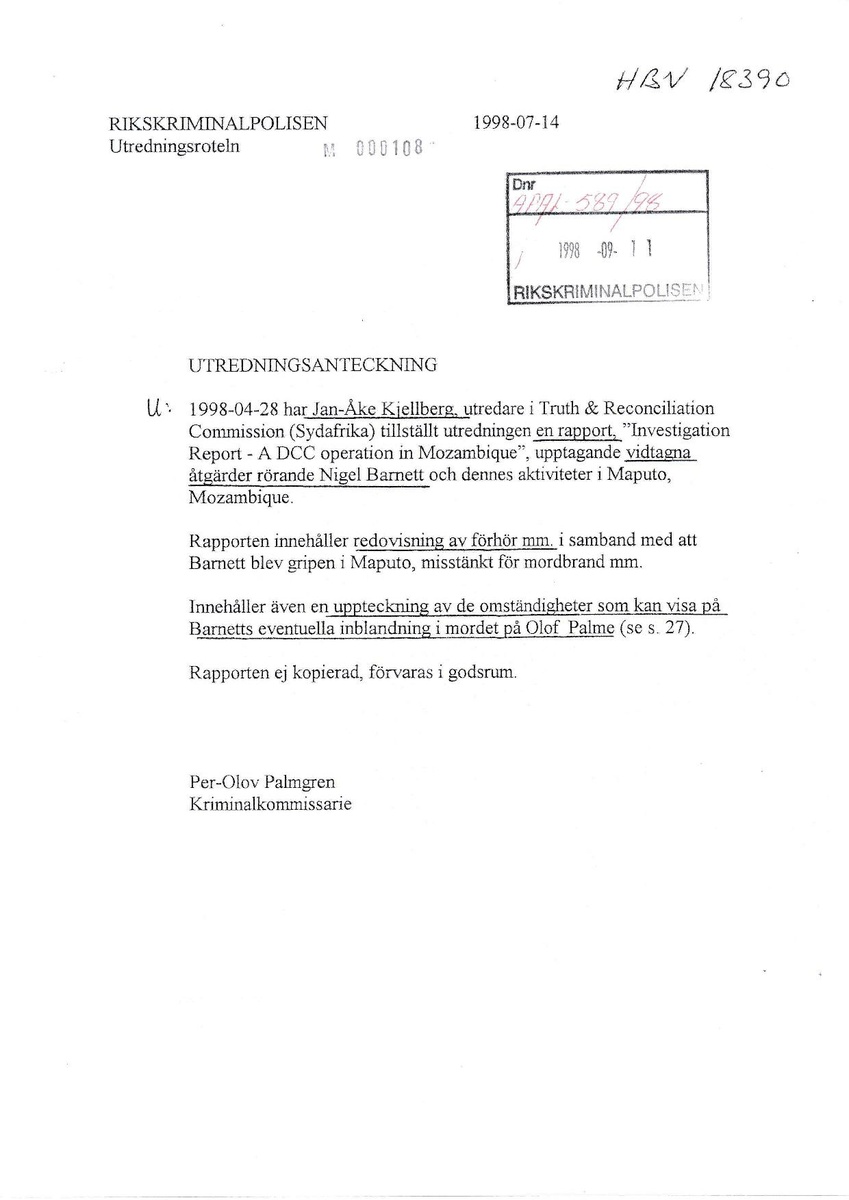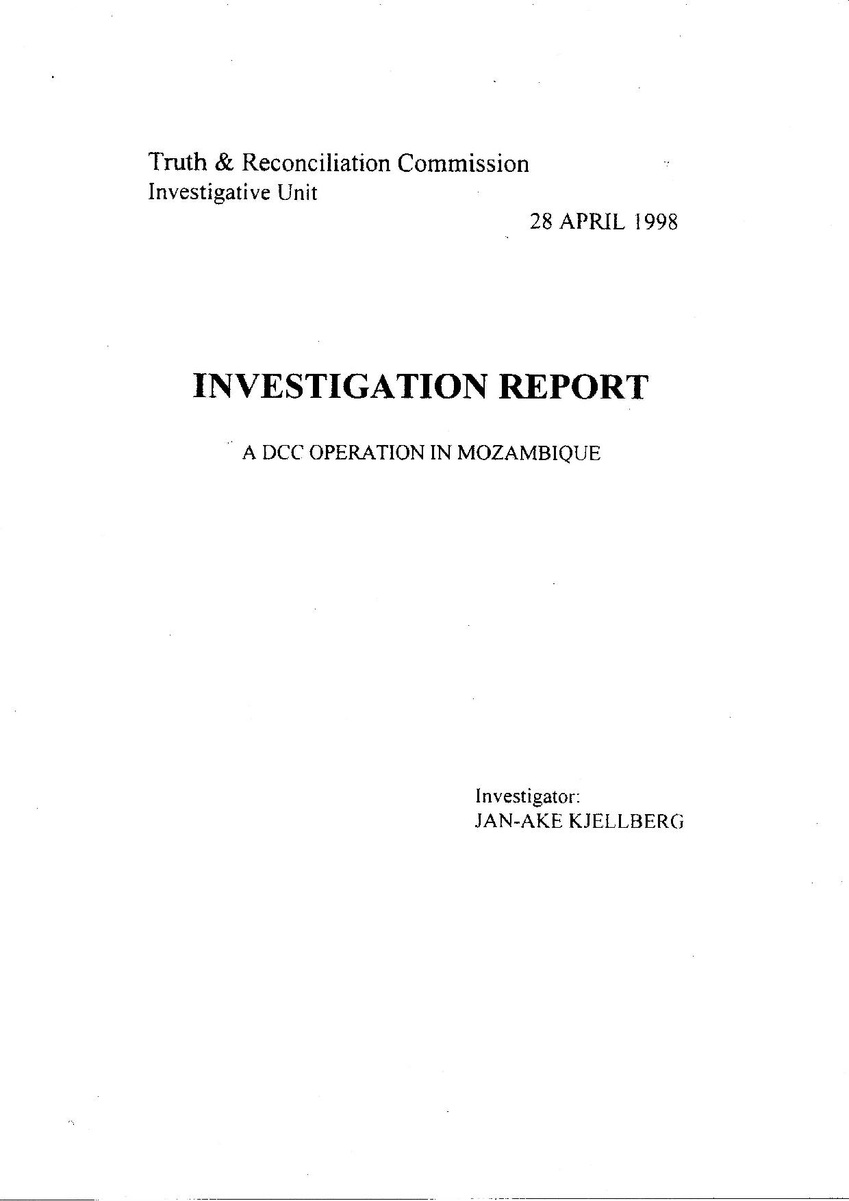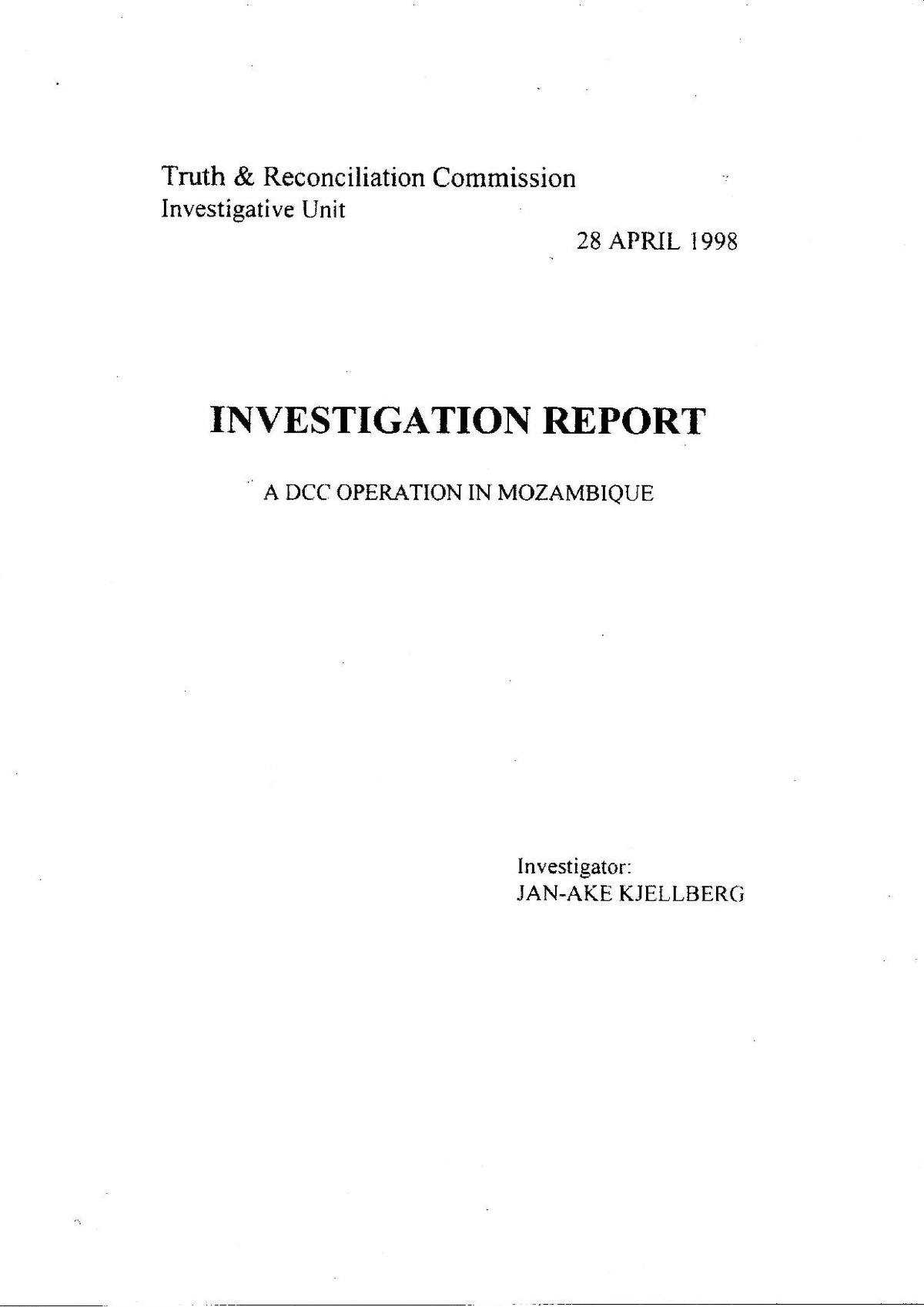Uppslag i samma avsnitt:
HBN 18390
1998-07-14
RIKSKRIMINALPOLISEN Utredningsroteln
M000108
Dnr
589
1998 -09-11
RIKSKRIMINALPOLISEN
UTREDNINGSANTECKNING
W 1998-04-28 har Jan-Åke Kjellberg, utredare i Truth & Reconciliation
Commission (Sydafrika) tillställt utredningen en rapport, "Investigation Report - A DCC operation in Mozambique”, upptagande vidtagna åtgärder rörande Nigel Barnett och dennes aktiviteter i Maputo, Mozambique.
2
Rapporten innehåller redovisning av förhör mm. i samband med att Barnett blev gripen i Maputo, misstänkt för mordbrand mm.
Innehåller även en uppteckning av de omständigheter som kan visa på Barnetts eventuella inblandning i mordet på Olof Palme (se s. 27).
Rapporten ej kopierad, förvaras i godsrum.
Per-Olov Palmgren Kriminalkommissarie
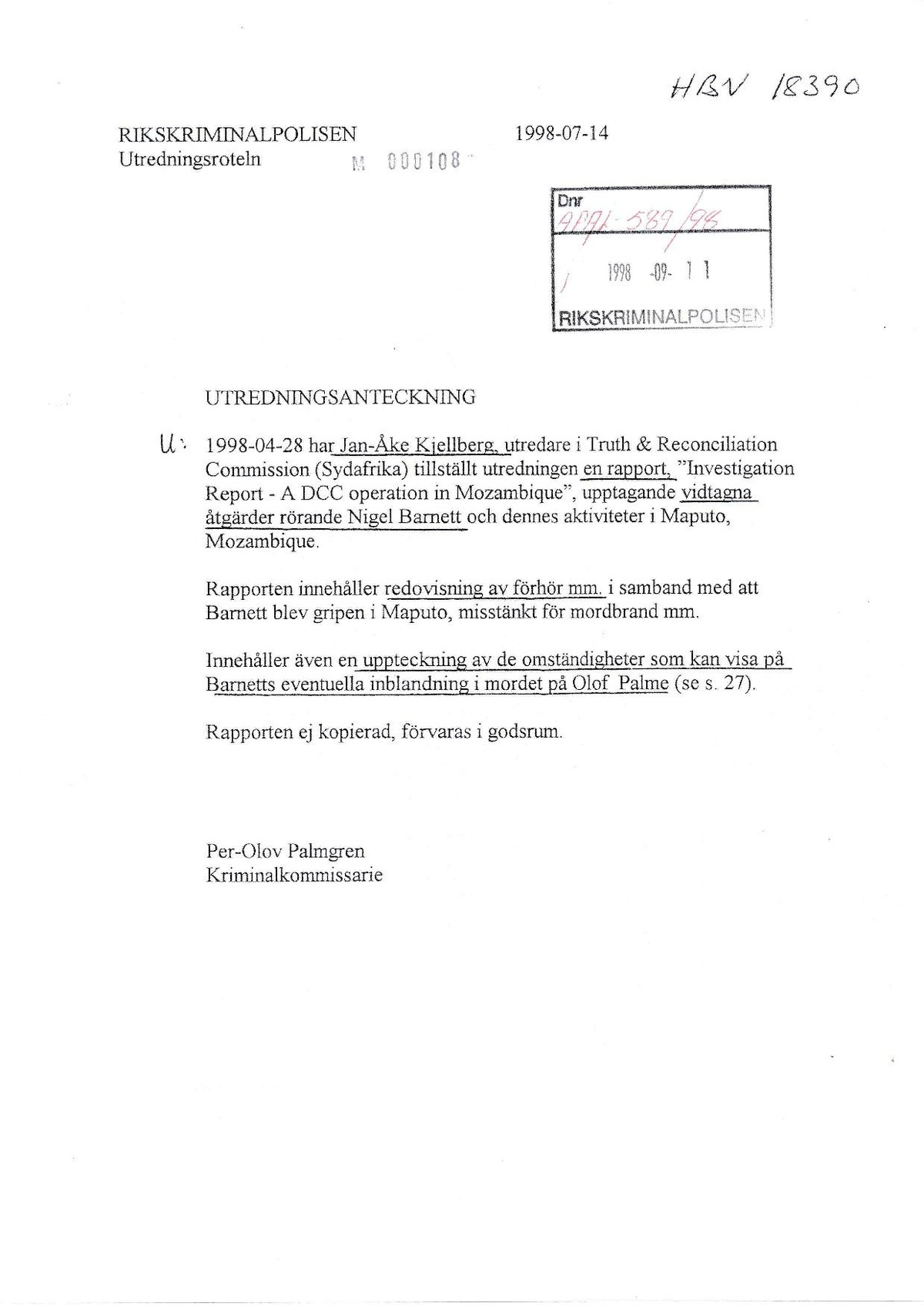
HBN 18390
1998-07-14
RIKSKRIMINALPOLISEN Utredningsroteln
M000108
Dnr
589
1998 -09-11
RIKSKRIMINALPOLISEN
UTREDNINGSANTECKNING
W 1998-04-28 har Jan-Åke Kjellberg, utredare i Truth & Reconciliation
Commission (Sydafrika) tillställt utredningen en rapport, "Investigation Report - A DCC operation in Mozambique”, upptagande vidtagna åtgärder rörande Nigel Barnett och dennes aktiviteter i Maputo, Mozambique.
2
Rapporten innehåller redovisning av förhör mm. i samband med att Barnett blev gripen i Maputo, misstänkt för mordbrand mm.
Innehåller även en uppteckning av de omständigheter som kan visa på Barnetts eventuella inblandning i mordet på Olof Palme (se s. 27).
Rapporten ej kopierad, förvaras i godsrum.
Per-Olov Palmgren Kriminalkommissarie
Beyond these sporadic visits, he seems to have had very little contact with his Swedish relatives. As far as has been established, Bacon has no children and has never been married.
MILITARY SERVICE
According to Bacon, he joined the Navy in June 1969 to do 2 years of military service. He was based in Simonstown where he tirst did 6 months of basic training and then I years as a de-mining diver.
A request was made to the Military Archives in Pretoria for access to Bacon's/Esslin's/ Barnett's personal file or files. None were forthcoming and a subpoena was served on the SANDF for production of the file/s in late April 1998.
RHODESIA
According to Bacon, he was employed by the British South African Police in Rhodesia after he finished his military service in 1971. He was trained for 6 months at the Trammar Police Depot in Salisbury. From 1972 until 1981 he served in different positions within the police structures in Rhodesia. He has described his duties as "normal" police ones, such as crime investigation and traffic control. Furthermore, he has stated that he was never involved in any activities which resulted in direct contact with “enemies“ during the war in Rhodesia. This is almost certainly not true.
17
One of the items found in Bacon's safety drawer in the Nedbank branch in Durban was a certificate for a Police Decoration for Gallantry' dated 5 October 1979. There was also letters from his superiors giving motivation for his decoration. One's by Supt. Seaward, Officer Commanding. Special Branch. Lomagundi District, where H.W. Bacon served for a period of three months between September and November 1978. states that his planned anti-terrorist operations were completed in a methodical manner“ and that the generates considerable enthusiasm and determination in coming to grips with terrorist groups, displaying initiative and flair for specialized projects“. In another document, dated 9 October 1979, a Provincial Special Branch Officer states that the Police Decoration for (iallantry was recently awarded to a Special Branch detail. who in addition to having done sterling work as an intelligence gatherer was engaged in a number of contacts with terrorists whom he managed to eliminate despite being out-gunned."
When Bacon was asked about the background to his decoration, he stated that he received the decoration for his performance in relation to a rescue operation, alter an air-plane crash, involving a Minister. Furthermore, he claimed that the decoration was
Copy of the certificate for the Police Decoration for Gallantry and copies of lour letters addressed to Bacon. * CONFIDENTIAL, XYS 7273. dated 20 February 1979.
SECRET. NYS 7226. dated 9 October 1979.
!
8
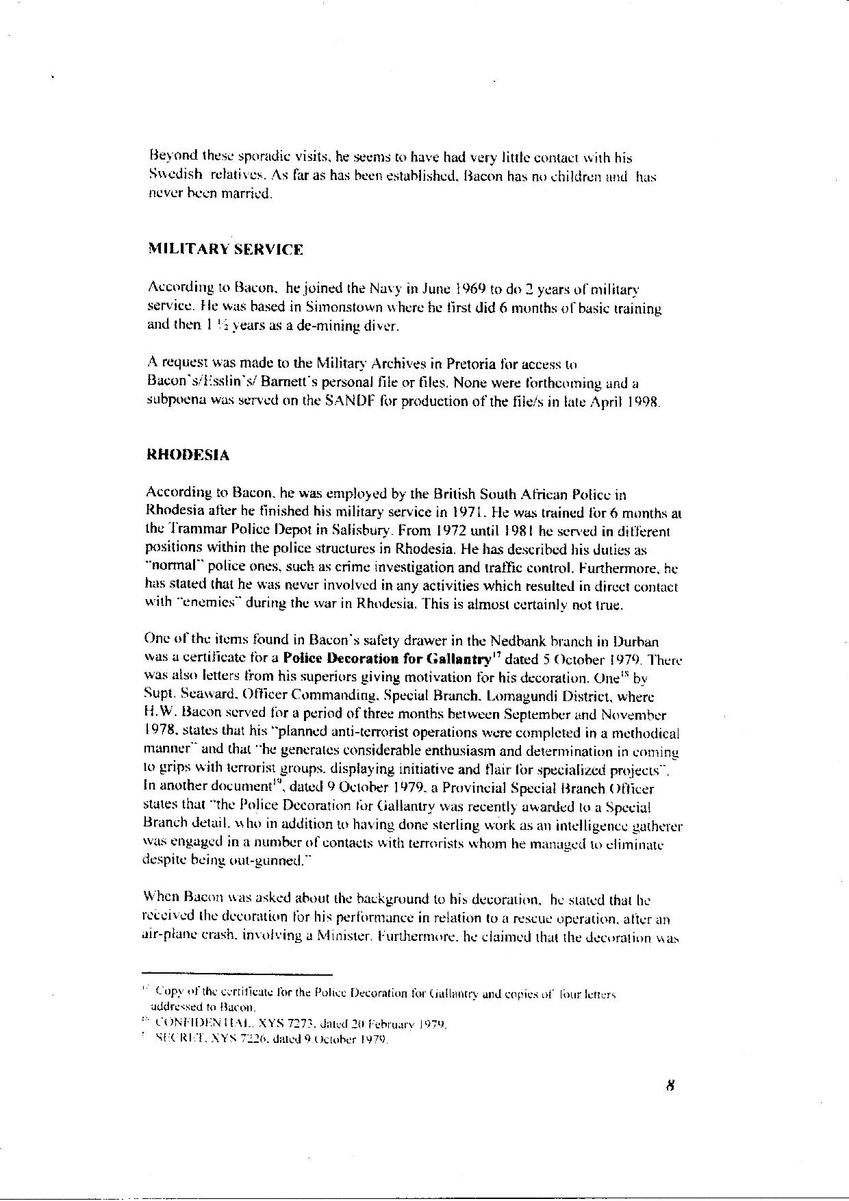
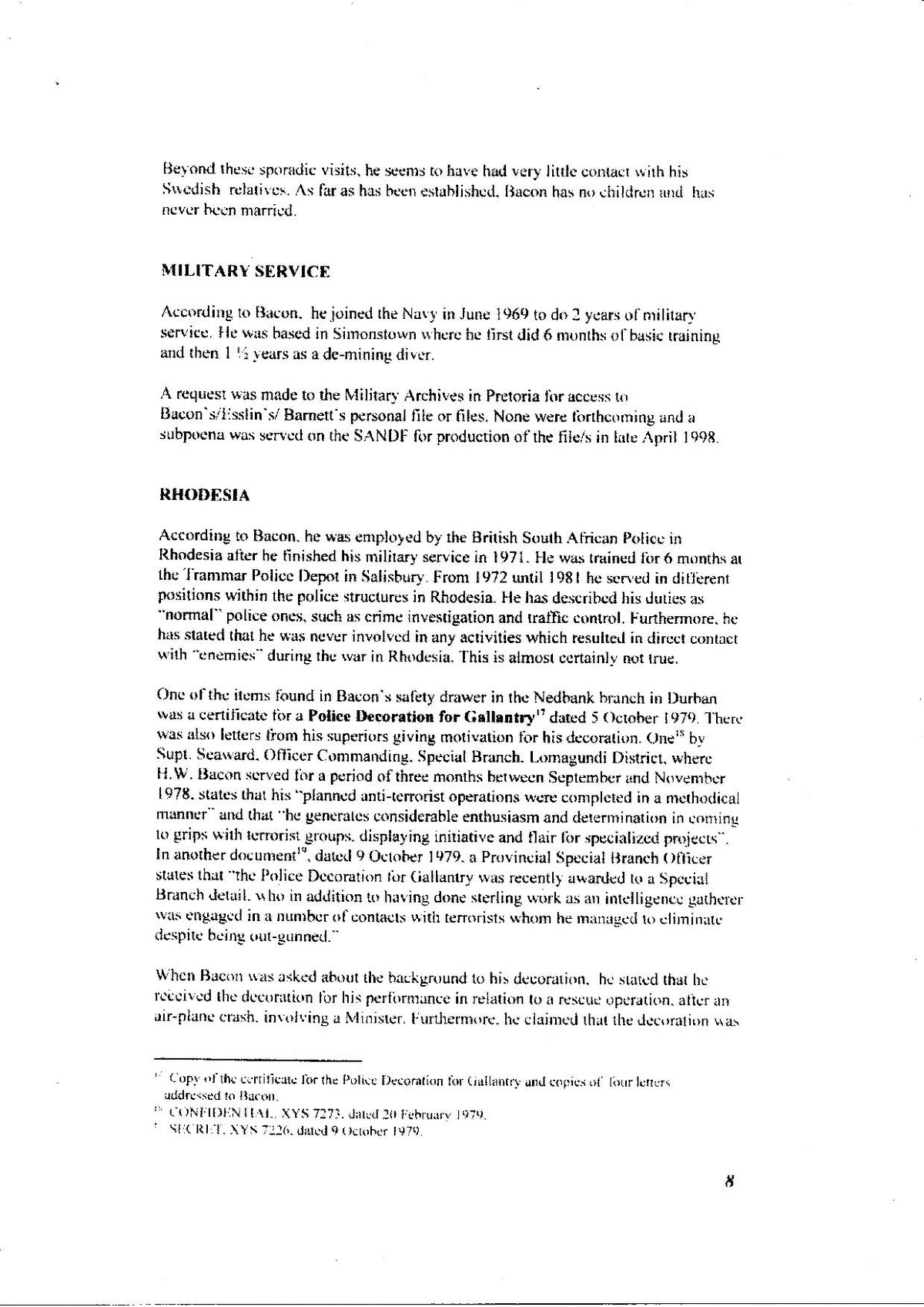
Beyond these sporadic visits, he seems to have had very little contact with his Swedish relatives. As far as has been established, Bacon has no children and has never been married.
MILITARY SERVICE
According to Bacon, he joined the Navy in June 1969 to do 2 years of military service. He was based in Simonstown where he tirst did 6 months of basic training and then I years as a de-mining diver.
A request was made to the Military Archives in Pretoria for access to Bacon's/Esslin's/ Barnett's personal file or files. None were forthcoming and a subpoena was served on the SANDF for production of the file/s in late April 1998.
RHODESIA
According to Bacon, he was employed by the British South African Police in Rhodesia after he finished his military service in 1971. He was trained for 6 months at the Trammar Police Depot in Salisbury. From 1972 until 1981 he served in different positions within the police structures in Rhodesia. He has described his duties as "normal" police ones, such as crime investigation and traffic control. Furthermore, he has stated that he was never involved in any activities which resulted in direct contact with “enemies“ during the war in Rhodesia. This is almost certainly not true.
17
One of the items found in Bacon's safety drawer in the Nedbank branch in Durban was a certificate for a Police Decoration for Gallantry' dated 5 October 1979. There was also letters from his superiors giving motivation for his decoration. One's by Supt. Seaward, Officer Commanding. Special Branch. Lomagundi District, where H.W. Bacon served for a period of three months between September and November 1978. states that his planned anti-terrorist operations were completed in a methodical manner“ and that the generates considerable enthusiasm and determination in coming to grips with terrorist groups, displaying initiative and flair for specialized projects“. In another document, dated 9 October 1979, a Provincial Special Branch Officer states that the Police Decoration for (iallantry was recently awarded to a Special Branch detail. who in addition to having done sterling work as an intelligence gatherer was engaged in a number of contacts with terrorists whom he managed to eliminate despite being out-gunned."
When Bacon was asked about the background to his decoration, he stated that he received the decoration for his performance in relation to a rescue operation, alter an air-plane crash, involving a Minister. Furthermore, he claimed that the decoration was
Copy of the certificate for the Police Decoration for Gallantry and copies of lour letters addressed to Bacon. * CONFIDENTIAL, XYS 7273. dated 20 February 1979.
SECRET. NYS 7226. dated 9 October 1979.
!
8
quite commonly issued and that the motivation was more or less a fake.
Eventually he admitted that he had been involved in intelligence gathering concerning "terrorists" who had been passed on to army units.
The need to establish Bacon's role in Rhodesia is considered to be of importance in relation to his role in Mozambique.
The motivation for his decoration indicates that he had a completely different role in Rhodesia from the "normal" police duties he alleged..
His brother has also stated that H.W. Bacon once mentioned to his father that he was tired of all the killing" while he was in Rhodesia.
The fact that in various documents he is linked to the Special Branch in the British South African police is considered to be signiticant.
Since the purpose of this investigation has been not only to establish the nature of Bacon's intelligence operation in Mozambique, but also to investigate any possible involvement in other types of operations e.g. assassinations, it is important to determine whether Bacon was capable of such operations.
The official records from his service indicate that he had such a capability. His military service in a de-mining diving unit also confirms that he was considered a highly capable operator.
Of interest also is the fact that Colonel At Nel, who allegedly recruited Bacon into the DCC, was working for BOSS/NIS in Rhodesia during the same period as Bacon was based there.
It is highly likely the two knew each other in Rhodesia which Bacon left in June or July 1981 - 18 months after the end of the war.
THE DIRECTORATE OF COVERT COLLECTION
After a short vacation in mid-1981, Bacon applied for employment in the South African Navy which was accepted and in October 1981 he started a refresher course at the Navy Diving School in Simonstown where he had done his basic military training ten years earlier.
After one-month's training, he was placed on a training boat as a supervisor for the divers. After three months, he asked for a transfer.
In March 1982, he was transferred to COM NAV ( Communication Navy ) in the Cape Province where he took up a position in the Personnel Section.
He has described this work as purely administrative and he soon found it boring and therefore left the Navy in December 1982.
During the period when he was working at COM NAV he met Colonel At Nel.
He has not been able clarify under which circumstances they met.
Bacon has stated that he told At Nel that he was about to leave the Navy.
Nel suggested that he should contact a Mr. Clemo at Polaris Shipping in Durban. Polaris Shipping was apparently a "front company used by the DCC and linked to its main front company, Pan African Investment Cooperation (PATIC").
Polaris Shipping (Pty) Lid was located on the 4th Floor, Cowey Park. 91 Cowey Road. Berea, Durban 4001. The company used as an address Box 10220, Marine Parade 4056, and the telephone number was (31231 008.
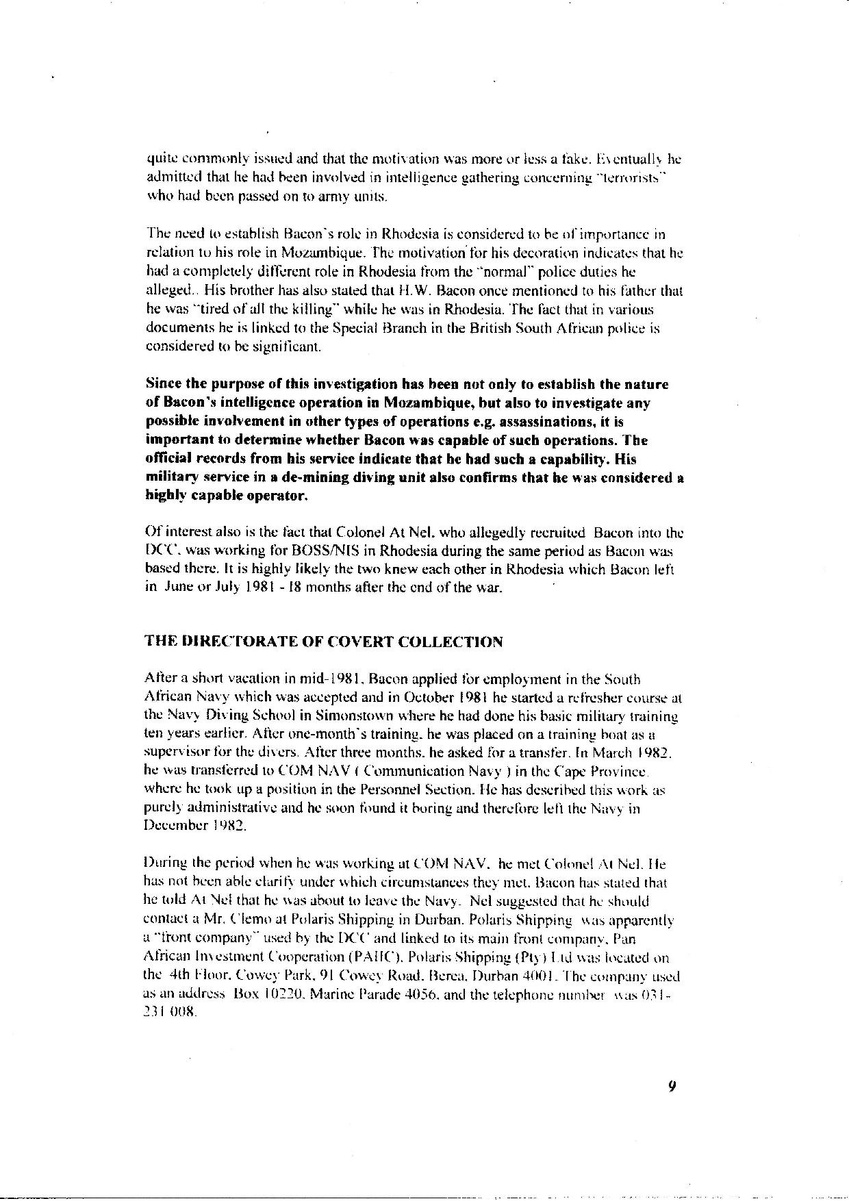
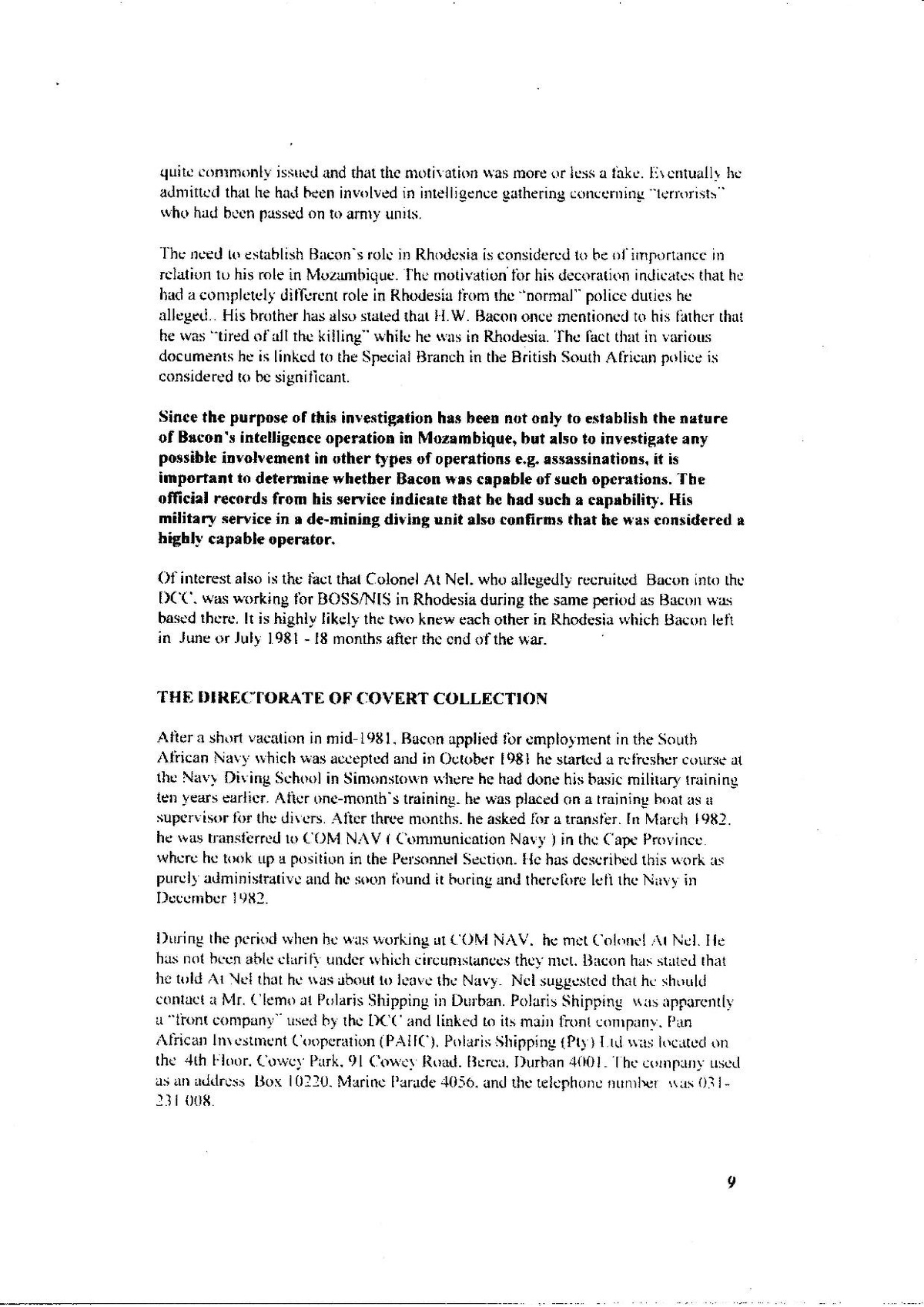
quite commonly issued and that the motivation was more or less a fake.
Eventually he admitted that he had been involved in intelligence gathering concerning "terrorists" who had been passed on to army units.
The need to establish Bacon's role in Rhodesia is considered to be of importance in relation to his role in Mozambique.
The motivation for his decoration indicates that he had a completely different role in Rhodesia from the "normal" police duties he alleged..
His brother has also stated that H.W. Bacon once mentioned to his father that he was tired of all the killing" while he was in Rhodesia.
The fact that in various documents he is linked to the Special Branch in the British South African police is considered to be signiticant.
Since the purpose of this investigation has been not only to establish the nature of Bacon's intelligence operation in Mozambique, but also to investigate any possible involvement in other types of operations e.g. assassinations, it is important to determine whether Bacon was capable of such operations.
The official records from his service indicate that he had such a capability. His military service in a de-mining diving unit also confirms that he was considered a highly capable operator.
Of interest also is the fact that Colonel At Nel, who allegedly recruited Bacon into the DCC, was working for BOSS/NIS in Rhodesia during the same period as Bacon was based there.
It is highly likely the two knew each other in Rhodesia which Bacon left in June or July 1981 - 18 months after the end of the war.
THE DIRECTORATE OF COVERT COLLECTION
After a short vacation in mid-1981, Bacon applied for employment in the South African Navy which was accepted and in October 1981 he started a refresher course at the Navy Diving School in Simonstown where he had done his basic military training ten years earlier.
After one-month's training, he was placed on a training boat as a supervisor for the divers. After three months, he asked for a transfer.
In March 1982, he was transferred to COM NAV ( Communication Navy ) in the Cape Province where he took up a position in the Personnel Section.
He has described this work as purely administrative and he soon found it boring and therefore left the Navy in December 1982.
During the period when he was working at COM NAV he met Colonel At Nel.
He has not been able clarify under which circumstances they met.
Bacon has stated that he told At Nel that he was about to leave the Navy.
Nel suggested that he should contact a Mr. Clemo at Polaris Shipping in Durban. Polaris Shipping was apparently a "front company used by the DCC and linked to its main front company, Pan African Investment Cooperation (PATIC").
Polaris Shipping (Pty) Lid was located on the 4th Floor, Cowey Park. 91 Cowey Road. Berea, Durban 4001. The company used as an address Box 10220, Marine Parade 4056, and the telephone number was (31231 008.
Bacon met Mr. Clemo shortly after he arrived in Durban in January 1983. He was told to apply for a job at Lesotho Mountain Carriers, which was a company owned by Polaris Shipping. He claims that he worked for this company until early 1984 when he was "offered“ another job. The Investigative Unit is in possession of two identical business cards". found in the Ned Safety Drawer, in the name of Nigel Barnett (Director). According to the card, the address for Lesotho Mountain Carriers (Lid) was Office Suite 532. Maseru Cabana Hotel, Maseru. Lesotho. Apparently there was also an office on 14 (A) Alexandre Marx, Maputo, Mozambique.
Sometime during 1983. Nel convinced Bacon to change his name and he later also came back to him with a passport in the name of Nigel Barnett.
At the beginning of 1984, he was told by Nel that Polaris Shipping needed a representative in Maputo and advised to apply for the job. He did and was later offered the job in Maputo.
Bacon has stated that he never received any intelligence training before he was based in Maputo. He has also stated that it took him about 8 months before he realized that he was involved in an intelligence operation. Clearly there is reason to doubt this version, especially considering his background and the fact that he was placed in a foreign country and handled by one of the top operators within the DCC.
Also notable is the version given by one of Bacon's handlers who states he was introduced to Barnett by a Capt. Lofti Palmer in mid-1983. At the end of 1983, he was informed by At Nel that Bacon would be stationed in Mozambique as an intelligence agent working for the DCC. Furthermore, he met him at an intelligence course held at the DCC Head Office in Pretoria. The course was an 8-week theoretical and practical intelligence course held from January to March 1984.
The question of when H.W. Bacon actually was recruited to the DCC is a matter that could be further investigated. From the information obtained, it seems he may have been recruited earlier than he has stated and that he also received intelligence training. The question is why is he trying to cover up his role within the DCC before 1984? The importance of access to his SADF personal file is obvious.
Bacon has stated that he thinks that he was recruited when he came back to Durban in January 1983 and joined Lesotho Mountain Carriers. It is also of importance to establish when he was employed by Polaris Shipping. Bacon has stated that he was recruited at the beginning of 1984. In a letter dated 27 February 1986, which was found in the Nedbank safety box. addressed to The Secretary. Unemployment Insurance Fund in Pretoria, sent from Polaris Shipping, it is stated that Nigel Barnett received a salary from 1 December 1983.
Copies of two business cards, Lesothu Mountain Carriers ( Lid). Copy of a letter from Polaris Shipping (Pty) Ltd. dated 27 February 1480.
10
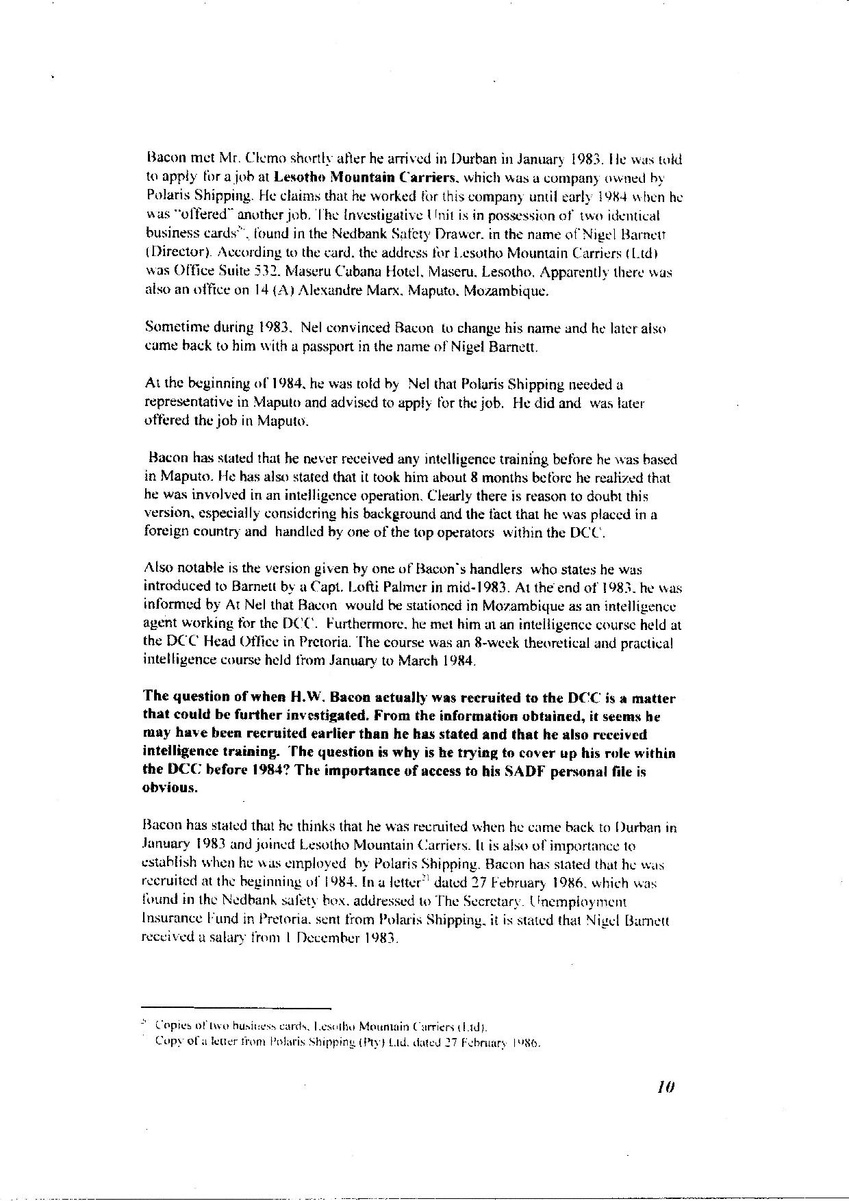
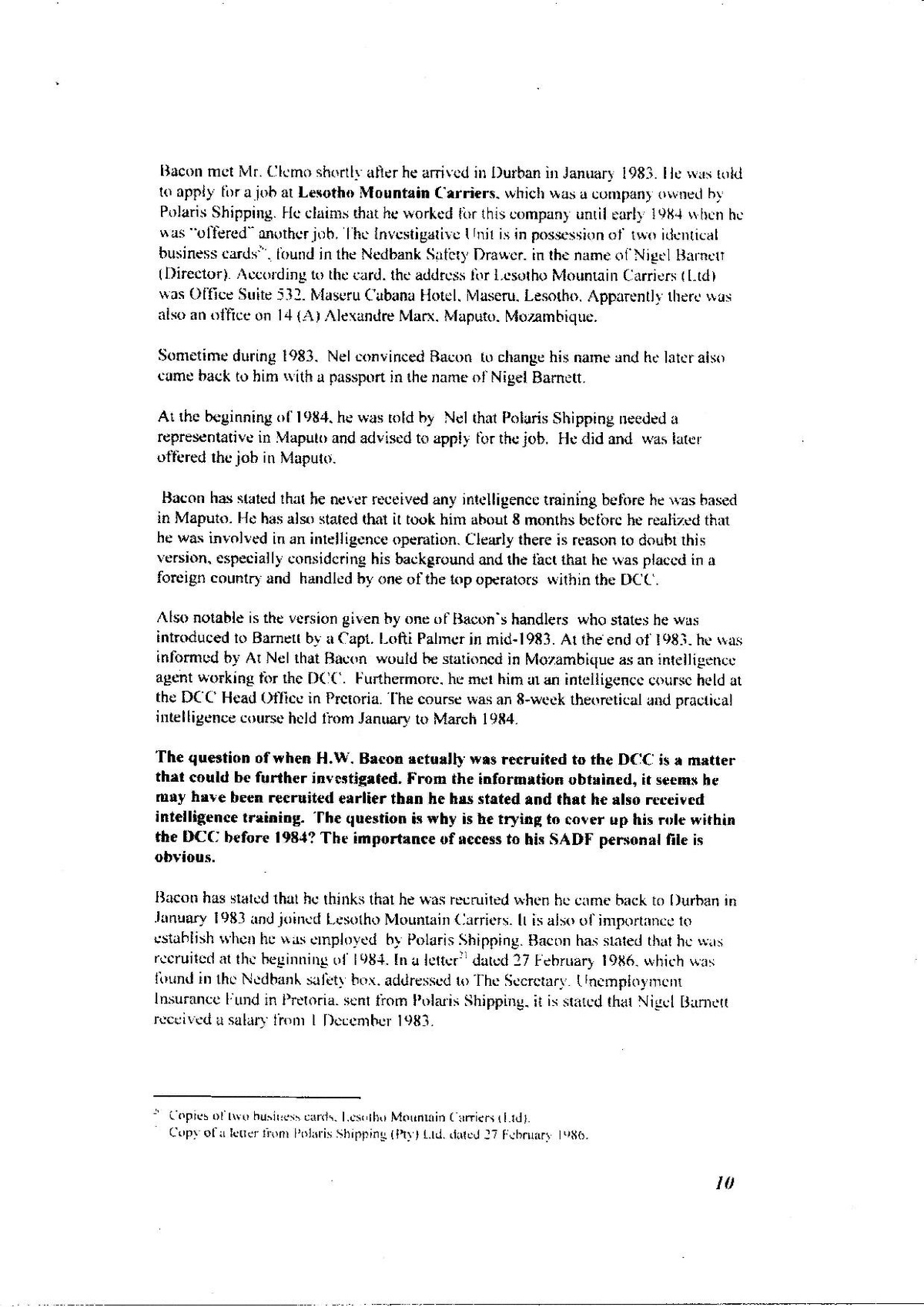
Bacon met Mr. Clemo shortly after he arrived in Durban in January 1983. He was told to apply for a job at Lesotho Mountain Carriers, which was a company owned by Polaris Shipping. He claims that he worked for this company until early 1984 when he was "offered“ another job. The Investigative Unit is in possession of two identical business cards". found in the Ned Safety Drawer, in the name of Nigel Barnett (Director). According to the card, the address for Lesotho Mountain Carriers (Lid) was Office Suite 532. Maseru Cabana Hotel, Maseru. Lesotho. Apparently there was also an office on 14 (A) Alexandre Marx, Maputo, Mozambique.
Sometime during 1983. Nel convinced Bacon to change his name and he later also came back to him with a passport in the name of Nigel Barnett.
At the beginning of 1984, he was told by Nel that Polaris Shipping needed a representative in Maputo and advised to apply for the job. He did and was later offered the job in Maputo.
Bacon has stated that he never received any intelligence training before he was based in Maputo. He has also stated that it took him about 8 months before he realized that he was involved in an intelligence operation. Clearly there is reason to doubt this version, especially considering his background and the fact that he was placed in a foreign country and handled by one of the top operators within the DCC.
Also notable is the version given by one of Bacon's handlers who states he was introduced to Barnett by a Capt. Lofti Palmer in mid-1983. At the end of 1983, he was informed by At Nel that Bacon would be stationed in Mozambique as an intelligence agent working for the DCC. Furthermore, he met him at an intelligence course held at the DCC Head Office in Pretoria. The course was an 8-week theoretical and practical intelligence course held from January to March 1984.
The question of when H.W. Bacon actually was recruited to the DCC is a matter that could be further investigated. From the information obtained, it seems he may have been recruited earlier than he has stated and that he also received intelligence training. The question is why is he trying to cover up his role within the DCC before 1984? The importance of access to his SADF personal file is obvious.
Bacon has stated that he thinks that he was recruited when he came back to Durban in January 1983 and joined Lesotho Mountain Carriers. It is also of importance to establish when he was employed by Polaris Shipping. Bacon has stated that he was recruited at the beginning of 1984. In a letter dated 27 February 1986, which was found in the Nedbank safety box. addressed to The Secretary. Unemployment Insurance Fund in Pretoria, sent from Polaris Shipping, it is stated that Nigel Barnett received a salary from 1 December 1983.
Copies of two business cards, Lesothu Mountain Carriers ( Lid). Copy of a letter from Polaris Shipping (Pty) Ltd. dated 27 February 1480.
10
Another interesting piece of information relating to the question of when he was recruited can be found in his ID Book issued 1981-10-16. His address is given in this ID book as Box 10891. Marine Parade 4056. Significantly, the Polaris Shipping address was Box 10220. Marine Parade 4056.
INTELLIGENCE OPERATION IN MAPUTO
Before he located to Maputo, Bacon was sent to the Far East to visit the head office of Gold Star Shipping in Hong Kong. The reason for this, according to Bacon, was that Polaris Shipping was an agency for Gold Star Shipping and he was therefore sent there to get familiar with the head office and to study the harbour. He was also sent to Kobe in Japan to meet with the representatives for Gold Star Shipping in Kobe. He spent altogether ten days in the Far East before he returned to South Africa and shortly afterwards he was sent to Maputo.
The address given in Nigel Barnett's ID Book issued on 1993-03-23 was No 151 Glowesner Rd, Hong Kong, which corroborates the information given by Bacon. The address given in the two passports that have been seized, one issued on 1990-01-22 and the other one 1992-11-16, is also in Hong Kong.
This "legend" (cover) is also outlined in a telex-letter" dated 11 November 1986, which was addressed to "The National Director, Ministry of Immigration, Maputo, Mozambique“. The letter refers to Mr. Nigel Barnett's application for a Residence card (D.I.R.E.). The sender of this telex, unknown, states that Mr. Barnett emigrated permanently from South Africa to Hong Kong in 1982, when he took up employment with Gold Star Line. Furthermore, it is stated that Mr. Barnett "has represented the company in Kobe(Japan), Bangkok(Thailand) and Colombo(Sri Lanka)". It is also stated that he “first represented Gold Star in Maputo and Beira, Mozambique, during 1983 when he travelled as a “Super cargo" on the Gold Star Linc vessels. Finally, the letter refers to Mr. Balaji in Hong Kong or Mr. C. Stringer in Mozambique. A copy of this telex letter was found in the Durban Nedbank Safety deposit box.
The link between the DCC and Gold Star Shipping is of interest. It has been alleged that Gold Star Shipping and its “sister-company“ Black Star Shipping was a front for one of the Israeli Intelligence agencies. Bacon has also mentioned that he met with a Mr. Zimmerman who was the head of the Gold Star Shipping office in Hong Kong and with a Mr. Ami Pamper who held the corresponding position in Kobe. In Kobe, he also saw people who allegedly were from the Israeli Embassy in Japan delivering envelopes to people on boats belonging to Gold Star Shipping.
The intelligence gathering that he was supposed to carry out has been described by himself in his hand-written letter as follows:
1984 - 1987
Maputo harbour. Gather information relating to the activities in the harbour, e.g. how many cranes and forklifts in working
Copy of a teler-letler, dated 11 November 1986.
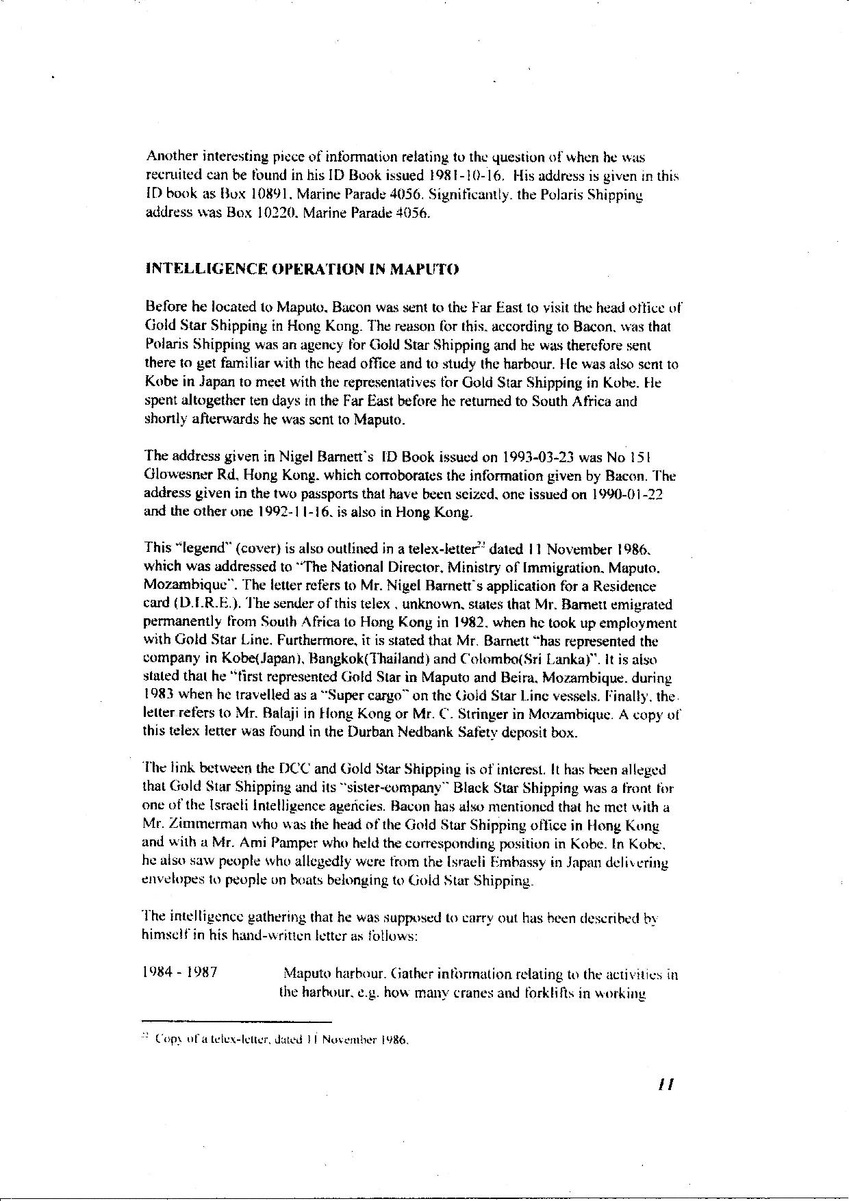
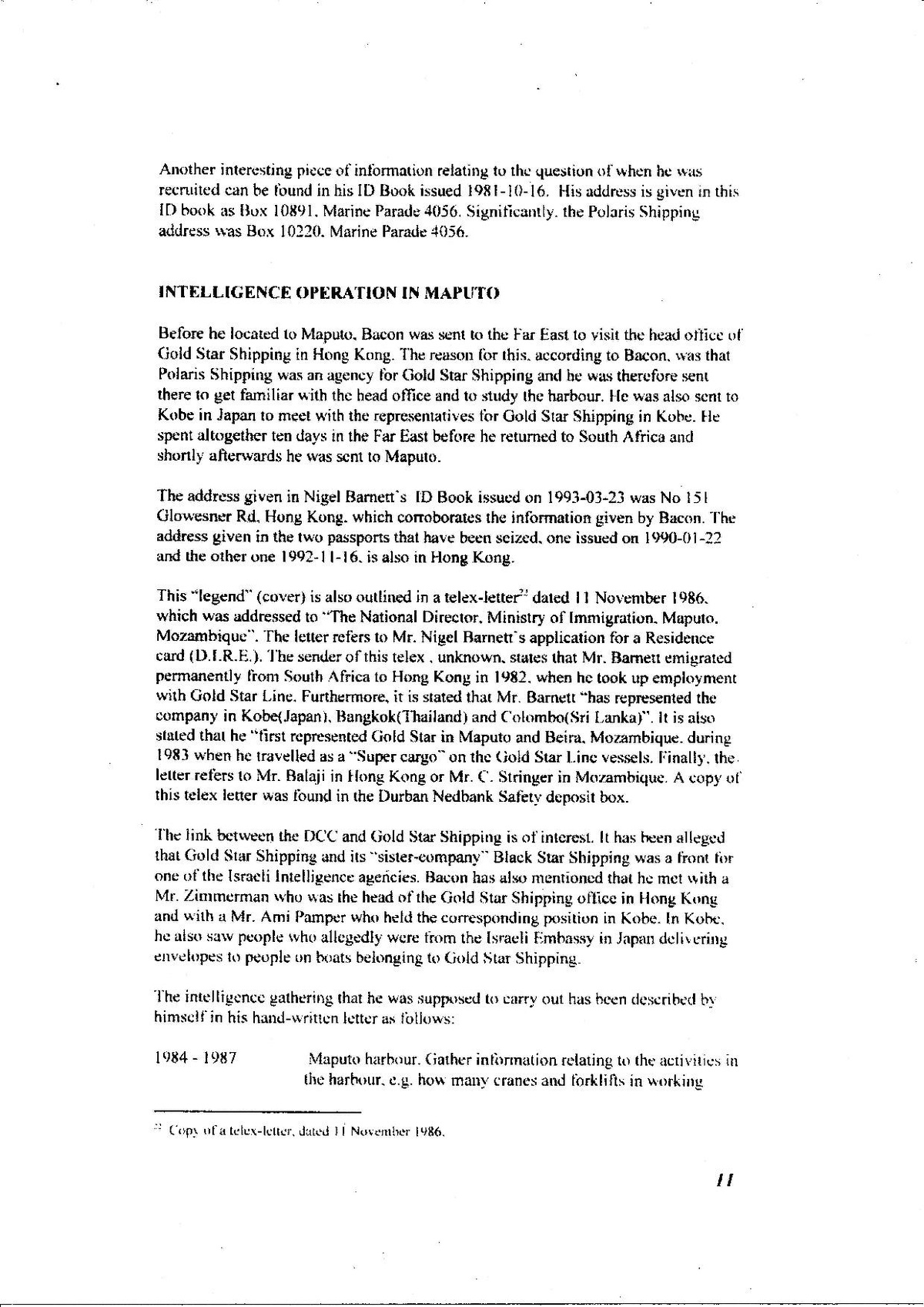
Another interesting piece of information relating to the question of when he was recruited can be found in his ID Book issued 1981-10-16. His address is given in this ID book as Box 10891. Marine Parade 4056. Significantly, the Polaris Shipping address was Box 10220. Marine Parade 4056.
INTELLIGENCE OPERATION IN MAPUTO
Before he located to Maputo, Bacon was sent to the Far East to visit the head office of Gold Star Shipping in Hong Kong. The reason for this, according to Bacon, was that Polaris Shipping was an agency for Gold Star Shipping and he was therefore sent there to get familiar with the head office and to study the harbour. He was also sent to Kobe in Japan to meet with the representatives for Gold Star Shipping in Kobe. He spent altogether ten days in the Far East before he returned to South Africa and shortly afterwards he was sent to Maputo.
The address given in Nigel Barnett's ID Book issued on 1993-03-23 was No 151 Glowesner Rd, Hong Kong, which corroborates the information given by Bacon. The address given in the two passports that have been seized, one issued on 1990-01-22 and the other one 1992-11-16, is also in Hong Kong.
This "legend" (cover) is also outlined in a telex-letter" dated 11 November 1986, which was addressed to "The National Director, Ministry of Immigration, Maputo, Mozambique“. The letter refers to Mr. Nigel Barnett's application for a Residence card (D.I.R.E.). The sender of this telex, unknown, states that Mr. Barnett emigrated permanently from South Africa to Hong Kong in 1982, when he took up employment with Gold Star Line. Furthermore, it is stated that Mr. Barnett "has represented the company in Kobe(Japan), Bangkok(Thailand) and Colombo(Sri Lanka)". It is also stated that he “first represented Gold Star in Maputo and Beira, Mozambique, during 1983 when he travelled as a “Super cargo" on the Gold Star Linc vessels. Finally, the letter refers to Mr. Balaji in Hong Kong or Mr. C. Stringer in Mozambique. A copy of this telex letter was found in the Durban Nedbank Safety deposit box.
The link between the DCC and Gold Star Shipping is of interest. It has been alleged that Gold Star Shipping and its “sister-company“ Black Star Shipping was a front for one of the Israeli Intelligence agencies. Bacon has also mentioned that he met with a Mr. Zimmerman who was the head of the Gold Star Shipping office in Hong Kong and with a Mr. Ami Pamper who held the corresponding position in Kobe. In Kobe, he also saw people who allegedly were from the Israeli Embassy in Japan delivering envelopes to people on boats belonging to Gold Star Shipping.
The intelligence gathering that he was supposed to carry out has been described by himself in his hand-written letter as follows:
1984 - 1987
Maputo harbour. Gather information relating to the activities in the harbour, e.g. how many cranes and forklifts in working
Copy of a teler-letler, dated 11 November 1986.
condition? Photographing of ANC' personnel, transit houses and foreign visitors. During 1992/93 when it became obvious that the ANC would become involved in politicking inside South Africa, all requirements for intelligence gathering on the ANC stopped.
According to Bacon, he was tasked and debriefed in everything he did for PAIIC/DCC by At Nel or one of his subordinates who were:
1984 - 1990 1991 - 1992 1993 - 1994
Adolf van den Berg Jack Widdowson Adrian Smit.
At Nel's subordinates were only administrators. They were unable to make decisions. Any question had to be related to At Nel. Bacon met regularly with At Nel.
Information related to ANC
Bacon's information-gathering concerning ANC activities in Mozambique has been described by him as follows:
A. Identifying suspected ANC-vehicles
He was provided with a list of 8 or 9 motor vehicles by At Nel. There was only a description of the vehicles, without any registration numbers. Bacon was told that sources in South Africa had identified these vehicles as being in use by ANC personnel in Maputo. He was tasked to locate these vehicles, to confirm that they were in fact in use by ANC, and to identify their role. Were they used to transport troops or arms to the borders, or were they used in Maputo in an administrative role?
Of the 8 or 9 vehicles on the list, he was only able to confirm that 4 of them were used for administrative reasons by the ANC: one blue Peugeot sedan and one white Peugeot sedan, which alternated between the administrative HQ in Awenida Julius Nyerere (4 th. tloor) and the Operational HQ in the road running past the central hospital between Awenida Eduardo Monolane and Awenida Mao Tse Tung ( Ist floor); one red Ford Escort which was also to be found parked behind the Operational HQ and one white Jeep Wagoneer, which was used to deliver food and for visits to an internal house, located near to Cardoso Hotel.
Bacon's role, having once confirmed the use of these vehicles by the ANC, was to monitor activities at these addresses. It proved to be almost impossible as they were all in built-up areas and any white person parked regularly outside any complex would have been investigated by the ANC' people.
B. Photographing of visitors
Another task was to photograph all visitors with a possible connection to the ANC flying into Maputo Airport. Whenever he identified ANC vehicles at the airport prior
12
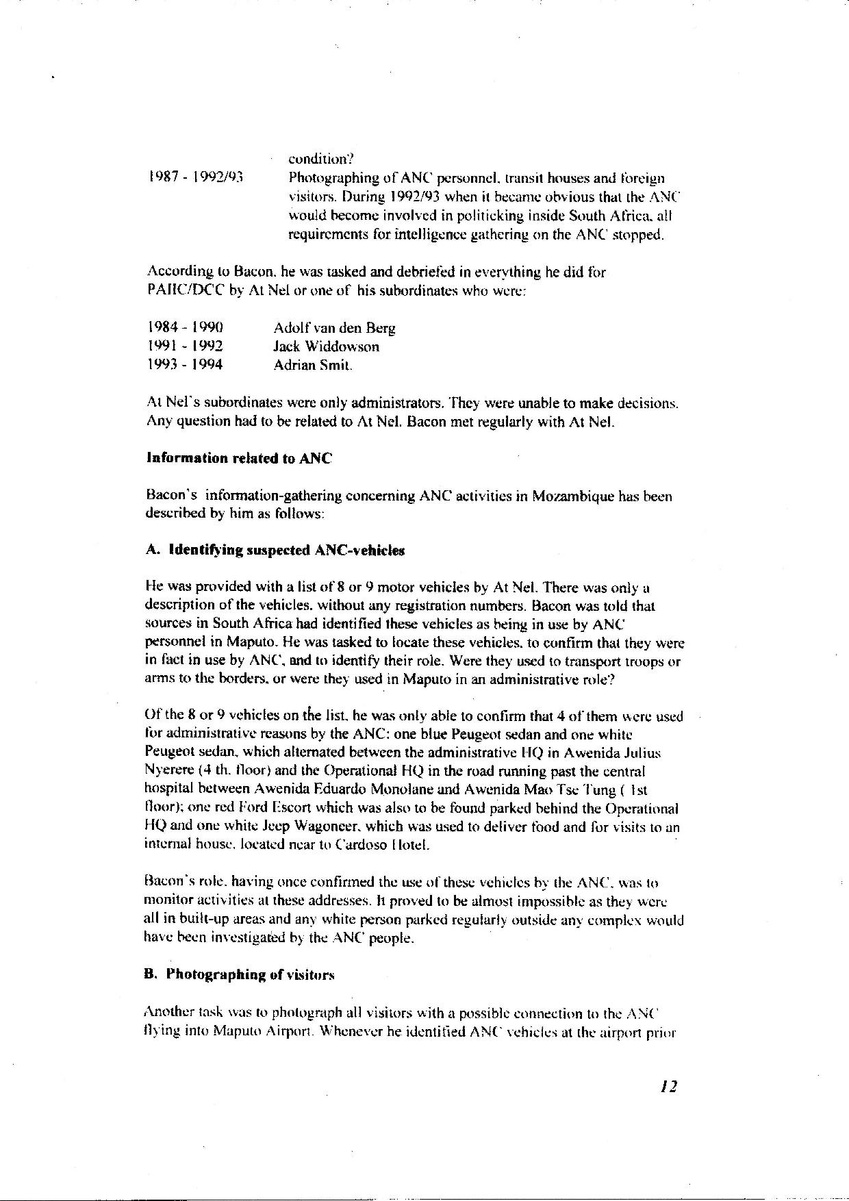
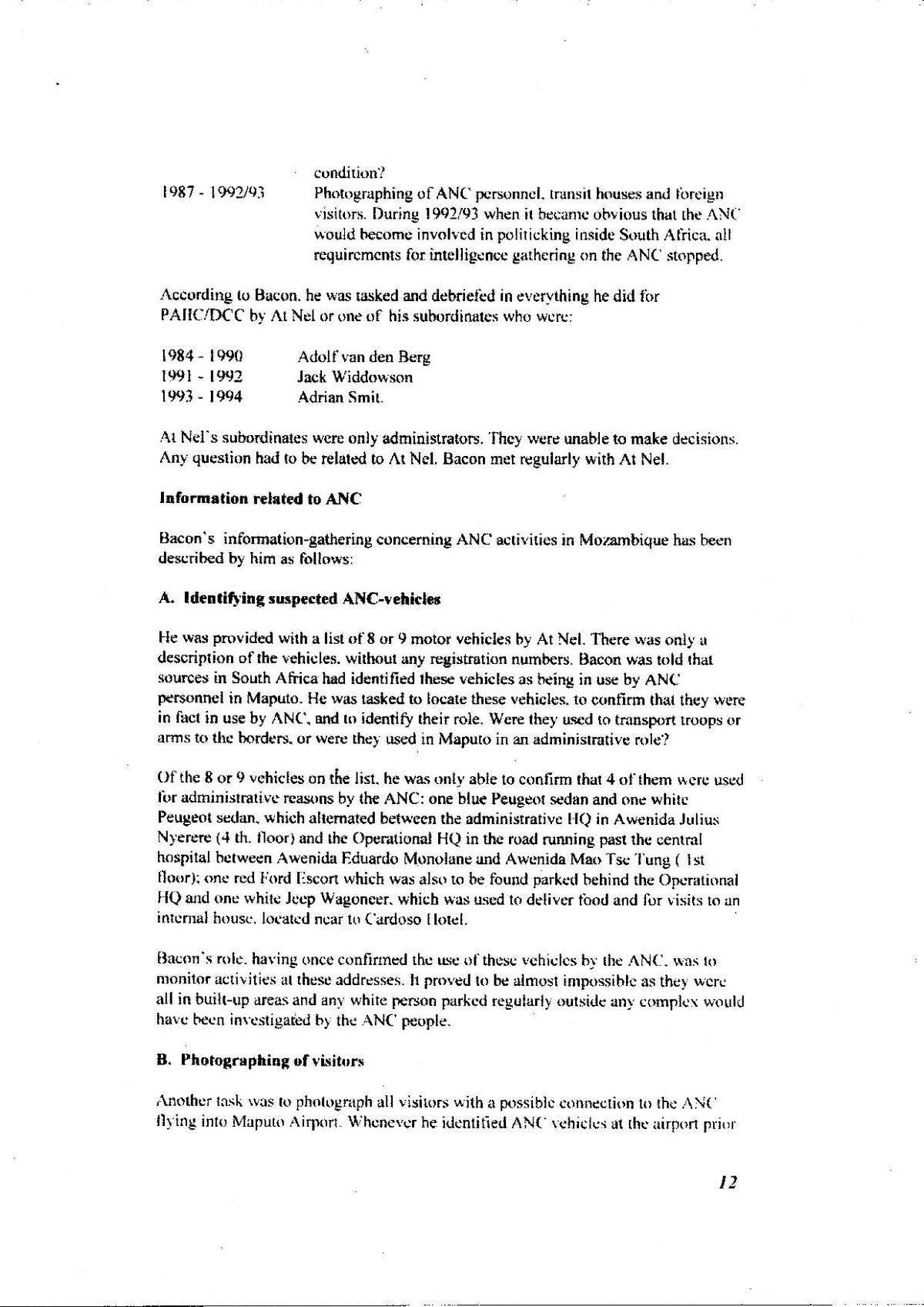
condition? Photographing of ANC' personnel, transit houses and foreign visitors. During 1992/93 when it became obvious that the ANC would become involved in politicking inside South Africa, all requirements for intelligence gathering on the ANC stopped.
According to Bacon, he was tasked and debriefed in everything he did for PAIIC/DCC by At Nel or one of his subordinates who were:
1984 - 1990 1991 - 1992 1993 - 1994
Adolf van den Berg Jack Widdowson Adrian Smit.
At Nel's subordinates were only administrators. They were unable to make decisions. Any question had to be related to At Nel. Bacon met regularly with At Nel.
Information related to ANC
Bacon's information-gathering concerning ANC activities in Mozambique has been described by him as follows:
A. Identifying suspected ANC-vehicles
He was provided with a list of 8 or 9 motor vehicles by At Nel. There was only a description of the vehicles, without any registration numbers. Bacon was told that sources in South Africa had identified these vehicles as being in use by ANC personnel in Maputo. He was tasked to locate these vehicles, to confirm that they were in fact in use by ANC, and to identify their role. Were they used to transport troops or arms to the borders, or were they used in Maputo in an administrative role?
Of the 8 or 9 vehicles on the list, he was only able to confirm that 4 of them were used for administrative reasons by the ANC: one blue Peugeot sedan and one white Peugeot sedan, which alternated between the administrative HQ in Awenida Julius Nyerere (4 th. tloor) and the Operational HQ in the road running past the central hospital between Awenida Eduardo Monolane and Awenida Mao Tse Tung ( Ist floor); one red Ford Escort which was also to be found parked behind the Operational HQ and one white Jeep Wagoneer, which was used to deliver food and for visits to an internal house, located near to Cardoso Hotel.
Bacon's role, having once confirmed the use of these vehicles by the ANC, was to monitor activities at these addresses. It proved to be almost impossible as they were all in built-up areas and any white person parked regularly outside any complex would have been investigated by the ANC' people.
B. Photographing of visitors
Another task was to photograph all visitors with a possible connection to the ANC flying into Maputo Airport. Whenever he identified ANC vehicles at the airport prior
12
to scheduled flights from Portugal, he would photograph passengers met by ANC personnel or who were driven away in the ANC vehicles. The films (spools) were taken to South Africa and handed over to At Nel or any of his subordinates. Bacon was informed that these photographs were developed and placed in photo albums. These albums were shown to sources who identified them if they could. Bacon estimates that he submitted approx. 500 photos. He has no knowledge of how many people were identified from the photos since he never received any feed-back.
C. Photographing of suspected ANC houses
Bacon's task was also to photograph suspected ANC houses in Maputo. All the information concerning houses used by ANC representatives was, he claimed, provided by ANC sources and passed on to him by At Nel. For example, At Nel would provide Bacon with 3-4 addresses on each visit. In many cases, the sources had only spent two or three nights at the address and did not know the exact address or sometimes even the name of the street. Bacon would be given a sketch and a general description of the area. His task was to photograph all the building on that particular side of the street. These photographs would be shown to the source and he would confirm the building and the entrance. Bacon thinks that this method was used to build up a comprehensive index of ANC houses.
According to Bacon, the following buildings in Maputo were photographed by him:
1. Administrative Office in Awenida Julius Nyerere. 2. Operational Office as described supra. 3. Internal house near to Cardoso Hotel. 4. The building at the intersection of Awenida Eduardo Mondlane and Awenida
Vladimir Lenin, on the north west corner on the intersection facing eastwards onto
Awenida Vladimir Lenin, 2nd and 4floor. 5. Apartment block no. 266 in Awenida Josina Machael. Traveling downhill from the
Josina Machael school towards Awenida Vladimir Lenin, the building was on the
left side of the road. 6. A west facing building ( 1" floor) in the street bordering the central hospital
complex. The street to east of the hospital. 7. A south facing building ( 1" floor ) on the street directly behind the central
hospital. 8. A west facing apartment block in a side-street of Awenida 24'" Julho as follows.
Traveling westwards in Awenida 2,4'" Julho from Awenida Julius Nyerere, turn lett at the 214 turning. 9. The African National Congress "pig farm in Matola".
Bacon's last intelligence-gathering operation on the ANC was just prior to the release of Nelson Mandela and the unbanning of the ANC. Bacon was tasked to follow a yellow Volkswagen from the Eduardo Mondlane University car park and to establish where the owner lived. He does not recall the name of the owner. As far as he remembers, he was a ANC member employed as a lecturer at the Eduardo Mondlane University. Bacon look photos of the vehicle and followed it to the user's residence. which he also photographed. He also photographed another vehicle and its occupants
13
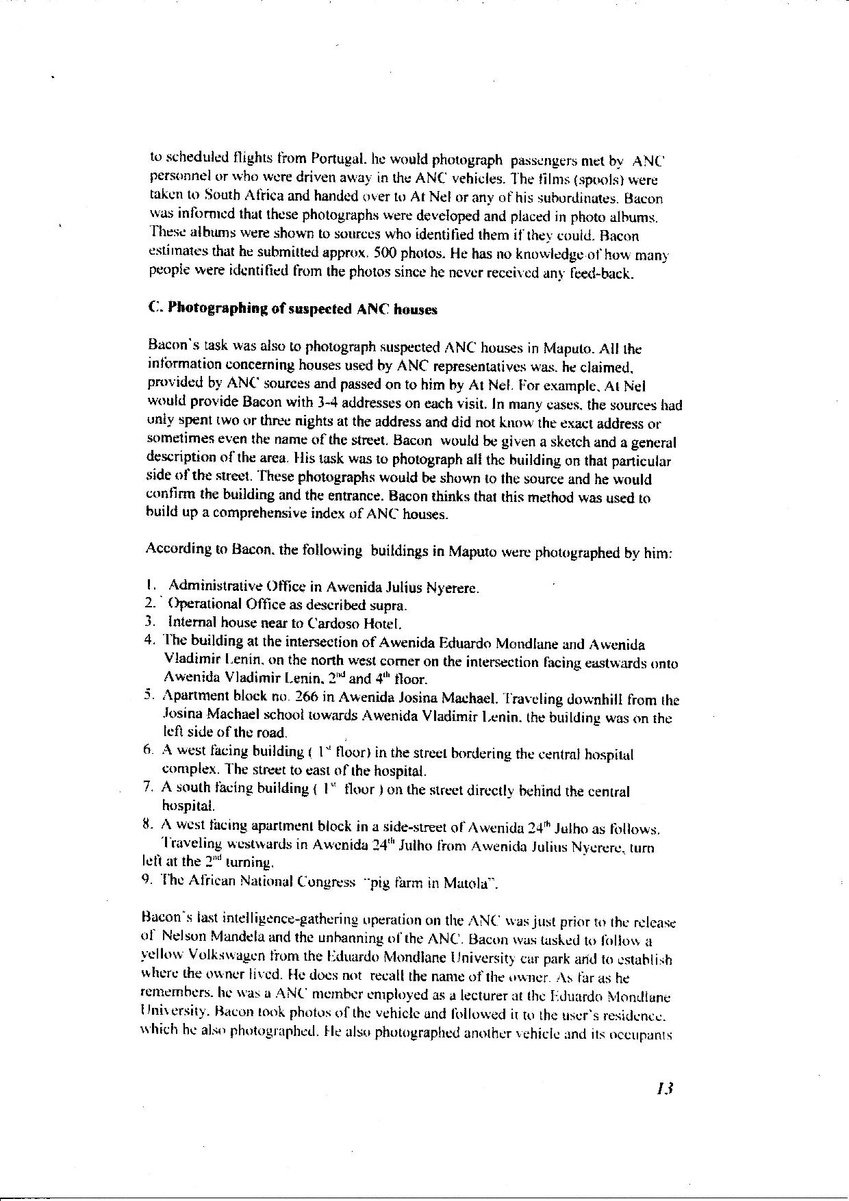
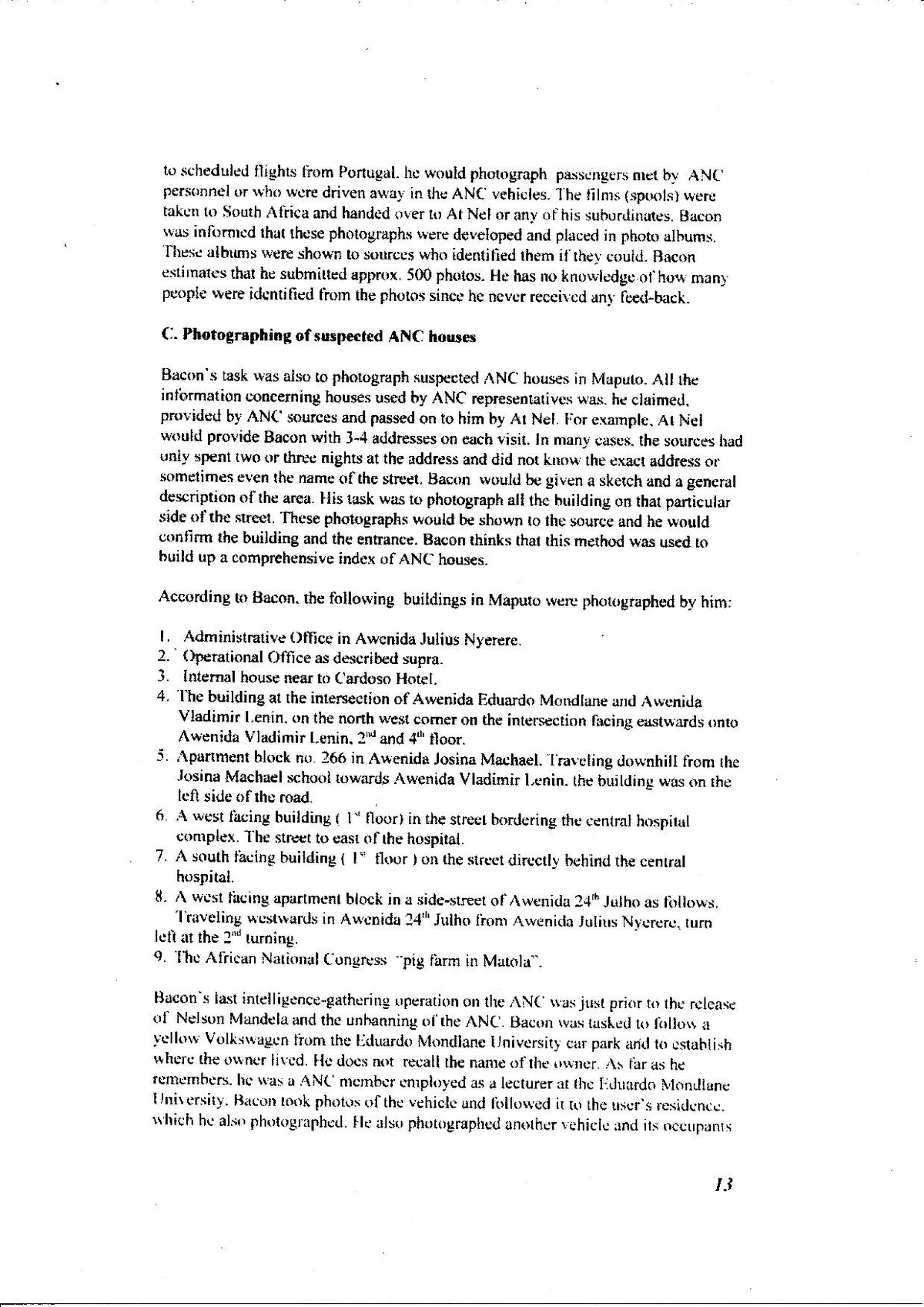
to scheduled flights from Portugal, he would photograph passengers met by ANC personnel or who were driven away in the ANC vehicles. The films (spools) were taken to South Africa and handed over to At Nel or any of his subordinates. Bacon was informed that these photographs were developed and placed in photo albums. These albums were shown to sources who identified them if they could. Bacon estimates that he submitted approx. 500 photos. He has no knowledge of how many people were identified from the photos since he never received any feed-back.
C. Photographing of suspected ANC houses
Bacon's task was also to photograph suspected ANC houses in Maputo. All the information concerning houses used by ANC representatives was, he claimed, provided by ANC sources and passed on to him by At Nel. For example, At Nel would provide Bacon with 3-4 addresses on each visit. In many cases, the sources had only spent two or three nights at the address and did not know the exact address or sometimes even the name of the street. Bacon would be given a sketch and a general description of the area. His task was to photograph all the building on that particular side of the street. These photographs would be shown to the source and he would confirm the building and the entrance. Bacon thinks that this method was used to build up a comprehensive index of ANC houses.
According to Bacon, the following buildings in Maputo were photographed by him:
1. Administrative Office in Awenida Julius Nyerere. 2. Operational Office as described supra. 3. Internal house near to Cardoso Hotel. 4. The building at the intersection of Awenida Eduardo Mondlane and Awenida
Vladimir Lenin, on the north west corner on the intersection facing eastwards onto
Awenida Vladimir Lenin, 2nd and 4floor. 5. Apartment block no. 266 in Awenida Josina Machael. Traveling downhill from the
Josina Machael school towards Awenida Vladimir Lenin, the building was on the
left side of the road. 6. A west facing building ( 1" floor) in the street bordering the central hospital
complex. The street to east of the hospital. 7. A south facing building ( 1" floor ) on the street directly behind the central
hospital. 8. A west facing apartment block in a side-street of Awenida 24'" Julho as follows.
Traveling westwards in Awenida 2,4'" Julho from Awenida Julius Nyerere, turn lett at the 214 turning. 9. The African National Congress "pig farm in Matola".
Bacon's last intelligence-gathering operation on the ANC was just prior to the release of Nelson Mandela and the unbanning of the ANC. Bacon was tasked to follow a yellow Volkswagen from the Eduardo Mondlane University car park and to establish where the owner lived. He does not recall the name of the owner. As far as he remembers, he was a ANC member employed as a lecturer at the Eduardo Mondlane University. Bacon look photos of the vehicle and followed it to the user's residence. which he also photographed. He also photographed another vehicle and its occupants
13
outside the residence.
Bacon described the location of the residence in Maputo as follows: follow Awenida Kenneth Kaunda direction west, turn left between the American Embassy and the US Aid Office. Then first right and 70 - 80 meters up on the left side.
The photographs were sent for contirmation and identification but there was no follow-up.
It is interesting to note that Bacon's administrative handler complained about the quality of his intelligence on the harbour. Nothing came of it however, and At Nel always seemed to be very satisfied with Bacon's work. From that, the handler got the impression that Bacon primary tasks were not related to the harbour.
Intelligence Gathering after 1994.
According to Bacon everything changed in 1994. At Nel left the DCC and Adrian Smit also left his position as his handler.
Shortly after they had left, Bacon was approached by a person named Charles Richards. Bacon has described how he met Richards “ by coincidence at the Hotel Paragon in Nelspruit. They started to talk about business possibilities in Mozambique and, according to Bacon, Richards informed him that he represented a group of businessmen who wanted to invest money specifically in Mozambique. This was something totally new for Bacon. He has also stated that he was offered commission on projects that he could find. At this first meeting he was given a Pretoria telephone number for Richards. After this they had a lot of discussions either via telephone or at meetings in Nelspruit. Richards never came to Maputo. According to Bacon, these discussions never developed into anything fruitfUL and he was never paid for his work.
Sometimes during 1995-96, Richards introduced him to Mr. Doncaster. The meeting took place in a coffee shop in Pretoria. The coffee shop, House of Coffee, was situated close to Church square. Doncaster was introduced to Bacon as a businessman. Even though Bacon knew that Doncaster had worked for the South African Military Intelligence he thought that he had left and that he, at this time, had a purely business interest in Mozambique.
Bacon had a second meeting with Doncaster in January-February 1997, at the same coffee shop in Pretoria. Charles Richards was present at this meeting. Bacon has described this meeting as a closing-down meeting. Since nothing ever came out of the information that he had delivered and he never was paid anything. They all agreed 10 close down the cooperation.
Bacon has described Charles Richards as about 35 years old, white, blond, strongly huilt and probably an Afrikaner. He described Doncaster as 50-55 years old, white with dark hair. Bacon's version of what happened atter 1994 give an impression that
14
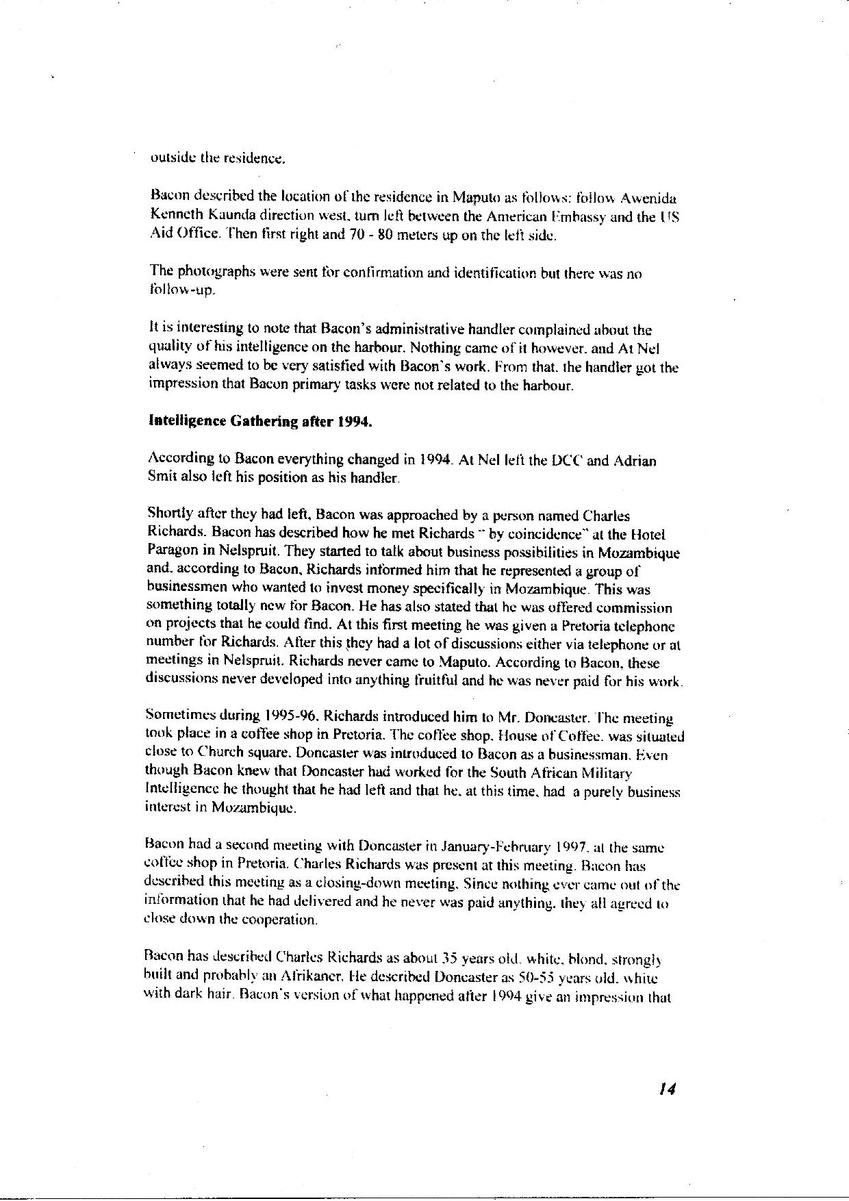
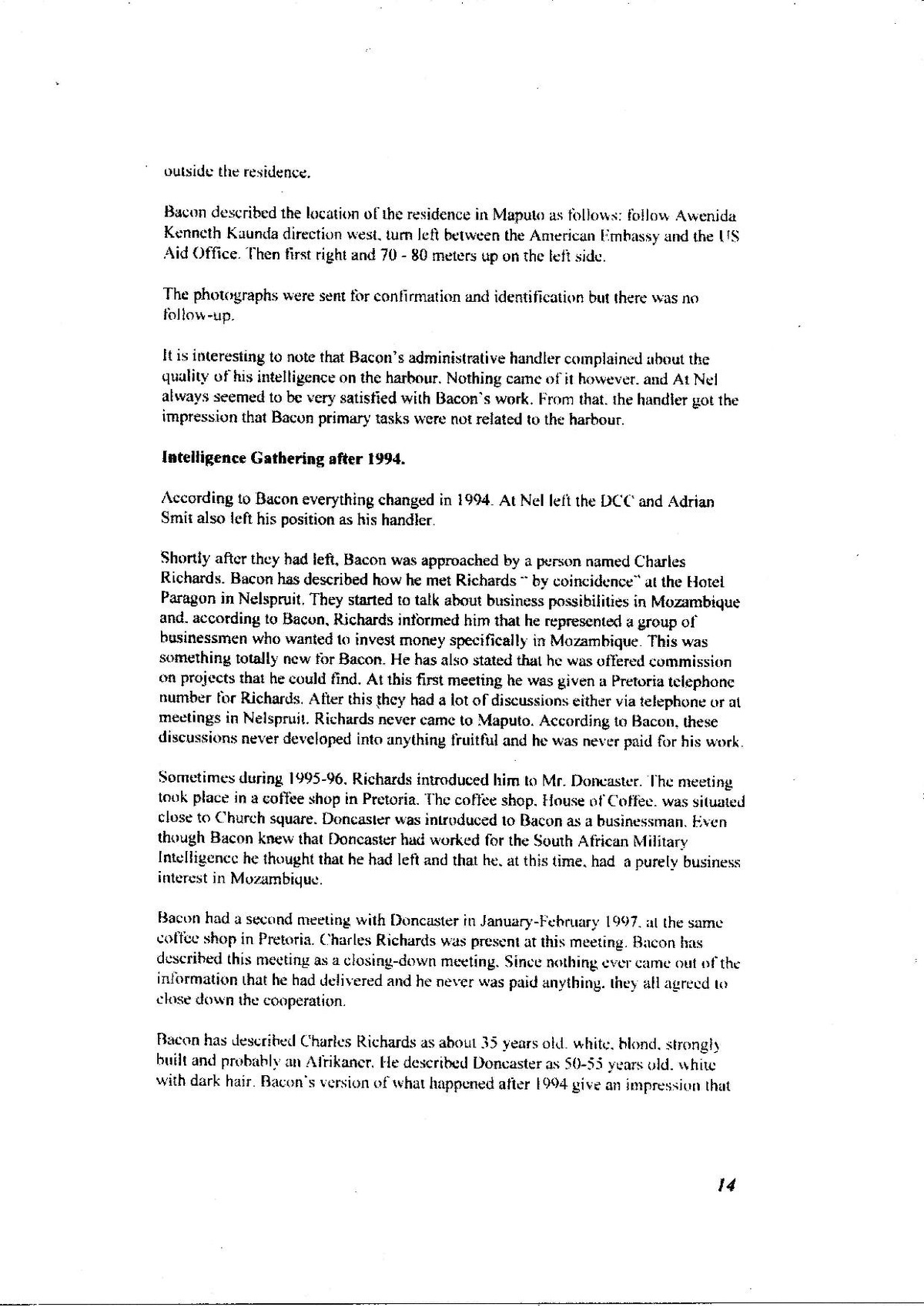
outside the residence.
Bacon described the location of the residence in Maputo as follows: follow Awenida Kenneth Kaunda direction west, turn left between the American Embassy and the US Aid Office. Then first right and 70 - 80 meters up on the left side.
The photographs were sent for contirmation and identification but there was no follow-up.
It is interesting to note that Bacon's administrative handler complained about the quality of his intelligence on the harbour. Nothing came of it however, and At Nel always seemed to be very satisfied with Bacon's work. From that, the handler got the impression that Bacon primary tasks were not related to the harbour.
Intelligence Gathering after 1994.
According to Bacon everything changed in 1994. At Nel left the DCC and Adrian Smit also left his position as his handler.
Shortly after they had left, Bacon was approached by a person named Charles Richards. Bacon has described how he met Richards “ by coincidence at the Hotel Paragon in Nelspruit. They started to talk about business possibilities in Mozambique and, according to Bacon, Richards informed him that he represented a group of businessmen who wanted to invest money specifically in Mozambique. This was something totally new for Bacon. He has also stated that he was offered commission on projects that he could find. At this first meeting he was given a Pretoria telephone number for Richards. After this they had a lot of discussions either via telephone or at meetings in Nelspruit. Richards never came to Maputo. According to Bacon, these discussions never developed into anything fruitfUL and he was never paid for his work.
Sometimes during 1995-96, Richards introduced him to Mr. Doncaster. The meeting took place in a coffee shop in Pretoria. The coffee shop, House of Coffee, was situated close to Church square. Doncaster was introduced to Bacon as a businessman. Even though Bacon knew that Doncaster had worked for the South African Military Intelligence he thought that he had left and that he, at this time, had a purely business interest in Mozambique.
Bacon had a second meeting with Doncaster in January-February 1997, at the same coffee shop in Pretoria. Charles Richards was present at this meeting. Bacon has described this meeting as a closing-down meeting. Since nothing ever came out of the information that he had delivered and he never was paid anything. They all agreed 10 close down the cooperation.
Bacon has described Charles Richards as about 35 years old, white, blond, strongly huilt and probably an Afrikaner. He described Doncaster as 50-55 years old, white with dark hair. Bacon's version of what happened atter 1994 give an impression that
14
the intelligence operation actually ended in 1994. However, the reports i found on his computer disks indicate the contrary.
First, the heading of the reports, FRED 142/96. FRED 41197 and FRED 42/97 indicates the frequency of reports sent to South Africa.
Second, the contents of these reports, e.g. FRED 142/96 mentions a person who claims to have current close ties with military intelligence in the RSA"; FRED 41/97 mentions Bacons contacts with the staff at the British Embassy and photos taken by him on the "Maputo Navigation Route" and FRED 42/97 deals with the Beira Navigation Channel and his “acceptability within the diplomatic circle". These reports definitely give an impression of something other then an operation to gather information for business investment.
Third and most important is a report dated 11/12/1995 in which Bacon reports that he had received information he was about to be arrested by the Mozambique SISE authorities” (SISE = Mozambique Intelligence Agency ). He ask his handler to contact the South African National Intelligence office in Nelspruit to ascertain the true nature of this threat“. He also asks the handler to try to find out if he had recently been compromised. The reason why he requested that NIA in Nelspruit should be contacted was because Bacon received the information from a person who was linked to NIA. Furthermore, Bacon also mentioned that he had a contact in Maputo who had access to the General Manager of SISE, who should make inquiries about any possible arrest.
Fourthly, a number of invoices from the telephone company in Maputo were found in Bacon's apartment. They are for the period October 1994 to January 1995. This is during a period when Bacon stayed in a house owned by a American woman.
who worked for USAID in Mozambique. The invoices are addressed to the Danish Embassy, which has been explained by the fact that personnel from the Danish Embassy used to live in the house before
moved in there. Of interest is the frequencies of phone calls to South Africa. Apparently the telephone was used by Bacon and but the phone calls done by
are marked on the lists. The dialed numbers have not been investigated but could be of interest to establish the identity of Bacon's handler and the intensity of his intelligence operation during this period.
COMMUNICATION
The question of how Bacon got his instructions and delivered his reports was also dealt with during the investigation.
3
reports copied from computer desks marked. FRED 142 96, FRED 41:97 and FRED 49/97. See footnote no?. Copies of telephone invoices from TELECOMUNICACOES DE MOZAMBIQUE
ܪܕ
15
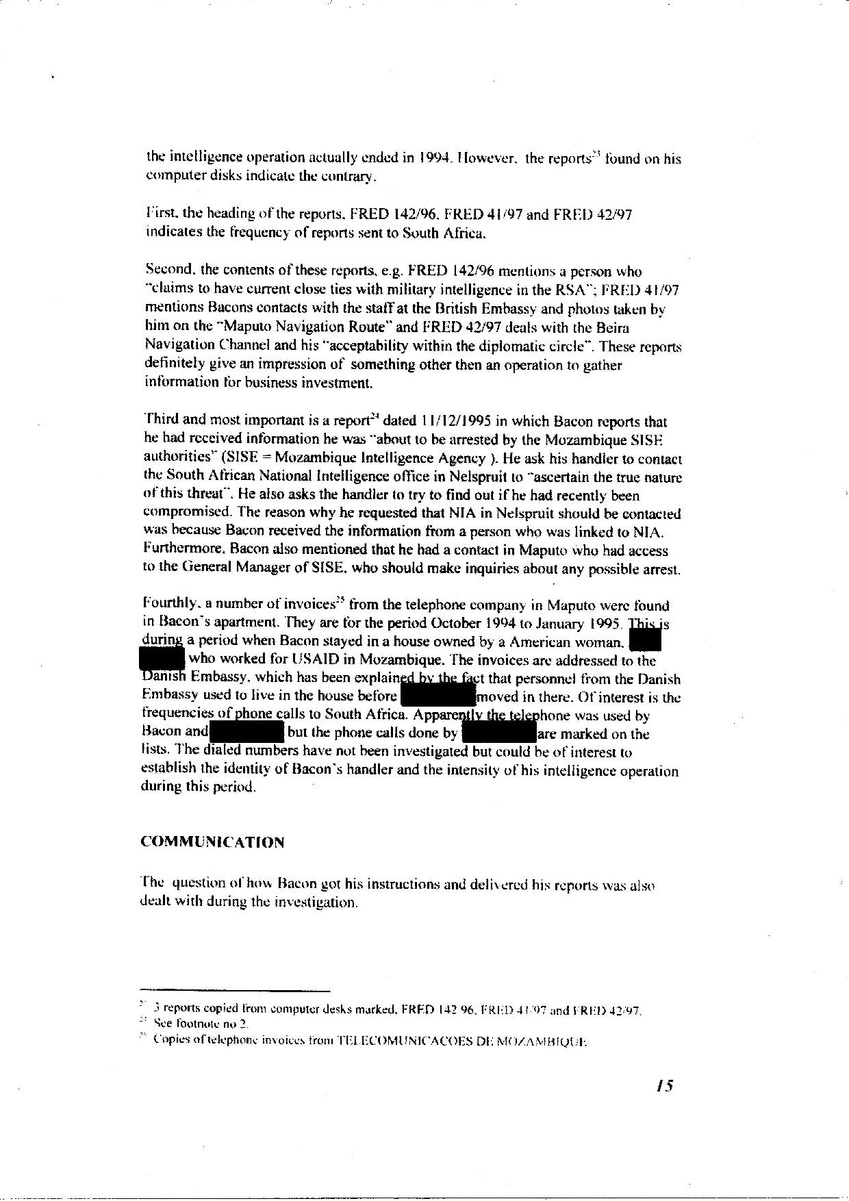
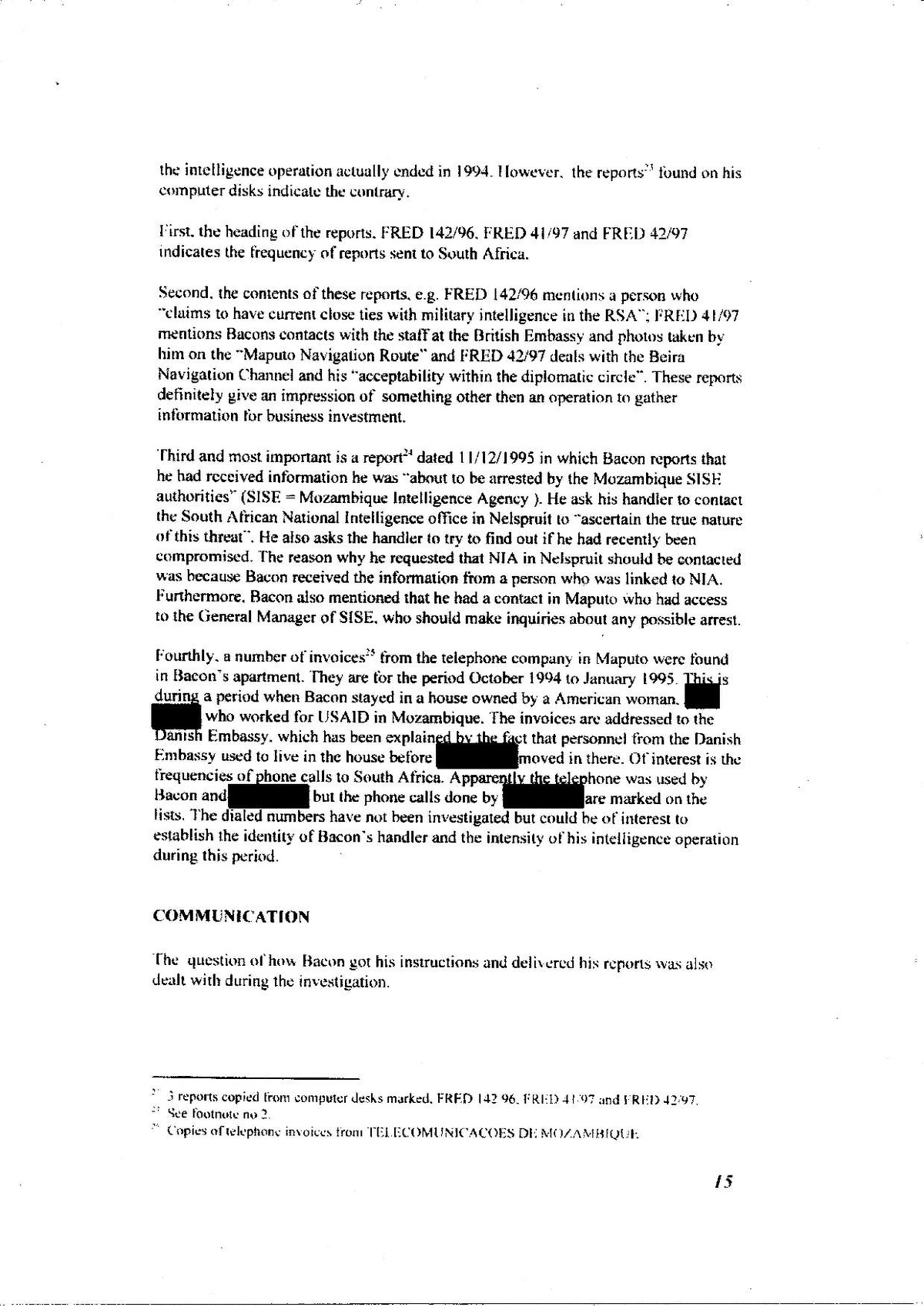
the intelligence operation actually ended in 1994. However, the reports i found on his computer disks indicate the contrary.
First, the heading of the reports, FRED 142/96. FRED 41197 and FRED 42/97 indicates the frequency of reports sent to South Africa.
Second, the contents of these reports, e.g. FRED 142/96 mentions a person who claims to have current close ties with military intelligence in the RSA"; FRED 41/97 mentions Bacons contacts with the staff at the British Embassy and photos taken by him on the "Maputo Navigation Route" and FRED 42/97 deals with the Beira Navigation Channel and his “acceptability within the diplomatic circle". These reports definitely give an impression of something other then an operation to gather information for business investment.
Third and most important is a report dated 11/12/1995 in which Bacon reports that he had received information he was about to be arrested by the Mozambique SISE authorities” (SISE = Mozambique Intelligence Agency ). He ask his handler to contact the South African National Intelligence office in Nelspruit to ascertain the true nature of this threat“. He also asks the handler to try to find out if he had recently been compromised. The reason why he requested that NIA in Nelspruit should be contacted was because Bacon received the information from a person who was linked to NIA. Furthermore, Bacon also mentioned that he had a contact in Maputo who had access to the General Manager of SISE, who should make inquiries about any possible arrest.
Fourthly, a number of invoices from the telephone company in Maputo were found in Bacon's apartment. They are for the period October 1994 to January 1995. This is during a period when Bacon stayed in a house owned by a American woman.
who worked for USAID in Mozambique. The invoices are addressed to the Danish Embassy, which has been explained by the fact that personnel from the Danish Embassy used to live in the house before
moved in there. Of interest is the frequencies of phone calls to South Africa. Apparently the telephone was used by Bacon and but the phone calls done by
are marked on the lists. The dialed numbers have not been investigated but could be of interest to establish the identity of Bacon's handler and the intensity of his intelligence operation during this period.
COMMUNICATION
The question of how Bacon got his instructions and delivered his reports was also dealt with during the investigation.
3
reports copied from computer desks marked. FRED 142 96, FRED 41:97 and FRED 49/97. See footnote no?. Copies of telephone invoices from TELECOMUNICACOES DE MOZAMBIQUE
ܪܕ
15
From information given by him we know that he travelled frequently to South Africa from Maputo. This is confirmed by Barnett's passport which contains several stamps from his border crossings.
Some of this trips were obviously to meet his handler to report and receive instructions about further intelligence gathering. His handler has also mentioned that they used a "sate house“ in Durban for their meetings. According to the handler, meetings were also held at the DCC head office in Pretoria.
At a later stage, probably after 1994, a computerized e-mail system was introduced. It has been established that Bacon used this system to send reports to his handler. To be able to enter the system, he had to type a 12-letter code as a password. The codes were changed every month. A copy of a document found in his apartment in Maputo listing the codes for every month from May 1996 to April 1997 is attached. Bacon has stated that Charles Richards introduced the computer system during 1995.
16
.
He used an E-mail system named PEGASUS and another program , NORTON COMMAND, to “compress” the document. To do this he had a computer with two desk stations. The sender and the receiver of the document had to use the monthly codes mentioned earlier in this report to be able to access the document. The reports were always sent on the telephone number given by Charles Richards, located in Pretoria. Copies of reports dated 4/12/96, 11/2/97, 12/3/97 and 17/3/97 are attached. These clearly indicate that Bacon was active as an intelligence operator until shortly before his arrest on 24 March 1997.
a
There are also two other documents seized by the investigators in Maputo that are of interest. One is a code-chartdivided into 6 columns and 9 rows. Each column and row are numbered and the combination of numbers indicates a square on the chart that has a letter, number or word. This is most probably a simple code-chart for some sort of communication e.g., radio or telephone. The chart is marked "CIRCULAR" and "SECRCID".
The other is also a code-chart-* containing 5 digit blocks of numbers. This could have been used for secret radio communication. The same kind of system is well known to have been used for a long time by intelligence agencies for communication purposes with their agents in foreign countries. It has been used particularly by all former East European agencies and more recently by the Russian agencies. This document is also market "C'IRKULAR" and "SECRCID"
Bacon has denied that these two documents belonged to him but has not been able to give an explanation as to how they could have been found amongst his belongings.
" Codes for the E-mail system.
Copy of the code-chart. - Copy of the code-chart.
16
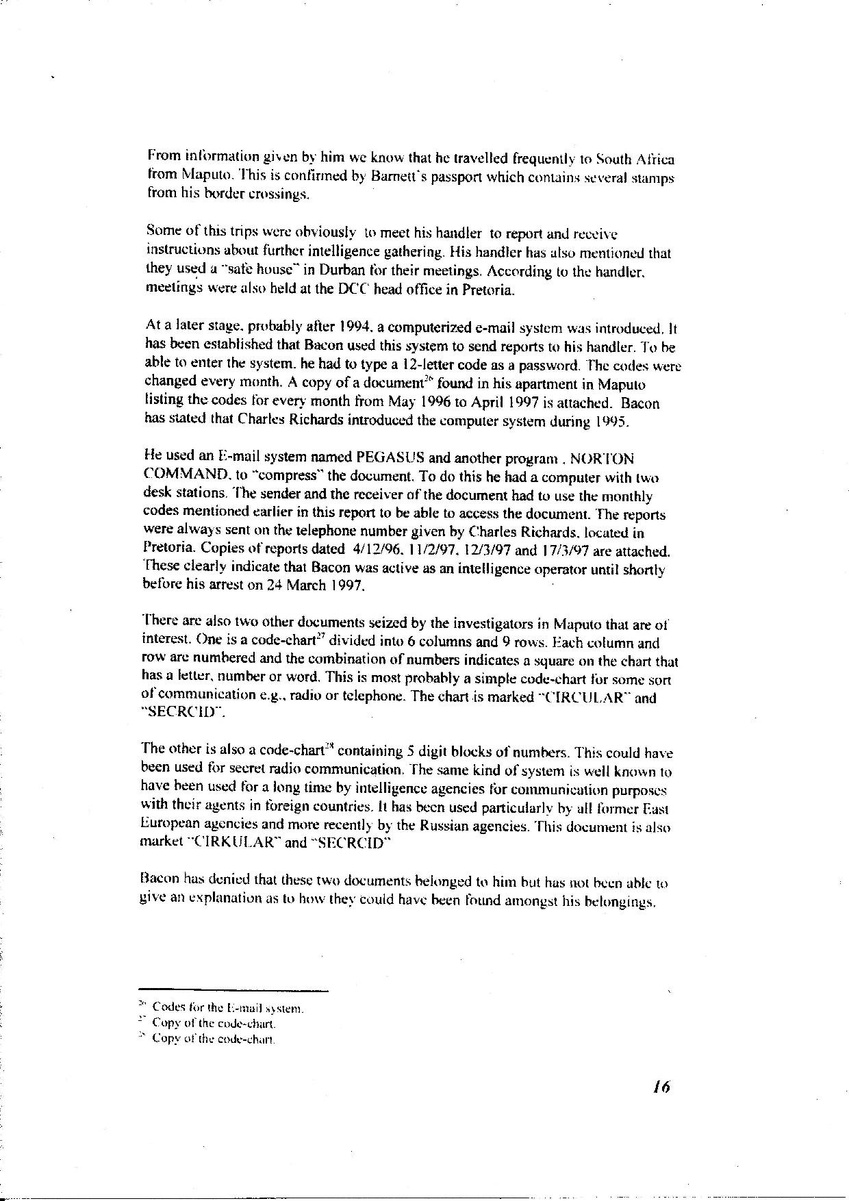
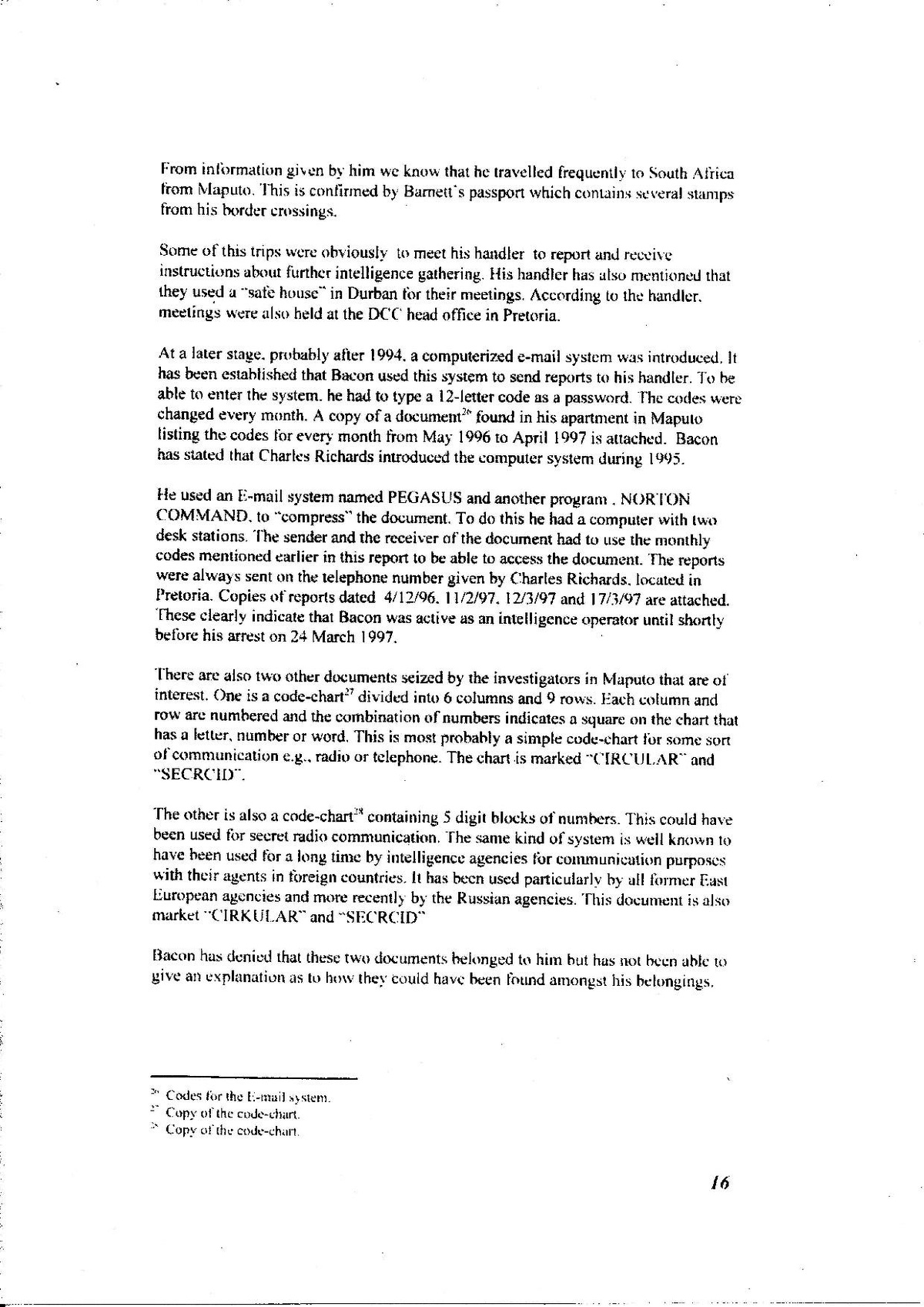
From information given by him we know that he travelled frequently to South Africa from Maputo. This is confirmed by Barnett's passport which contains several stamps from his border crossings.
Some of this trips were obviously to meet his handler to report and receive instructions about further intelligence gathering. His handler has also mentioned that they used a "sate house“ in Durban for their meetings. According to the handler, meetings were also held at the DCC head office in Pretoria.
At a later stage, probably after 1994, a computerized e-mail system was introduced. It has been established that Bacon used this system to send reports to his handler. To be able to enter the system, he had to type a 12-letter code as a password. The codes were changed every month. A copy of a document found in his apartment in Maputo listing the codes for every month from May 1996 to April 1997 is attached. Bacon has stated that Charles Richards introduced the computer system during 1995.
16
.
He used an E-mail system named PEGASUS and another program , NORTON COMMAND, to “compress” the document. To do this he had a computer with two desk stations. The sender and the receiver of the document had to use the monthly codes mentioned earlier in this report to be able to access the document. The reports were always sent on the telephone number given by Charles Richards, located in Pretoria. Copies of reports dated 4/12/96, 11/2/97, 12/3/97 and 17/3/97 are attached. These clearly indicate that Bacon was active as an intelligence operator until shortly before his arrest on 24 March 1997.
a
There are also two other documents seized by the investigators in Maputo that are of interest. One is a code-chartdivided into 6 columns and 9 rows. Each column and row are numbered and the combination of numbers indicates a square on the chart that has a letter, number or word. This is most probably a simple code-chart for some sort of communication e.g., radio or telephone. The chart is marked "CIRCULAR" and "SECRCID".
The other is also a code-chart-* containing 5 digit blocks of numbers. This could have been used for secret radio communication. The same kind of system is well known to have been used for a long time by intelligence agencies for communication purposes with their agents in foreign countries. It has been used particularly by all former East European agencies and more recently by the Russian agencies. This document is also market "C'IRKULAR" and "SECRCID"
Bacon has denied that these two documents belonged to him but has not been able to give an explanation as to how they could have been found amongst his belongings.
" Codes for the E-mail system.
Copy of the code-chart. - Copy of the code-chart.
16
In his apartment a radio-receiver was found - a SONY world hand receiver ICF-SW 55. Bacon has stated that he bought this radio in Maputo in 1995 for which he paid US$200.
Further investigation is required in regard to the circumstances surrounding the last-mentioned document with the 5 digit code-chart in combination with the seized radio-receiver. The possibility that Bacon worked for a second agency apart from the South African DMI needs to be considered.
WEAPONS
At the time of his arrest. Bacon was in possession of the following weapons:
1. One pistol, Astra, Cal 22, No. 1271976, listed in Nigel Barnett's ID books No.
500630 5202 08 9 on 1985-05-09 and 500630 5202 00 6 on 1985-05-09;
2. One pistol. Glock, Cal 10 mm, No. UL129. listed in Nigel Barnett's ID book No.
500630 5202 08 9 on 1992-02-24;
3. One rifle, Spandau Mauser, Cal 308, No. 5019, listed in H.W. Bacon's ID book
No. 490529 5115 00 6 on 1982-10-21 and on N. Esslin's ID book No. 490529 5115 00 6 on 1983-10-24;
These three weapons are being held by the CID in Maputo.
Furthermore, it was established from a copy of an ID book” found in Bacon's apartment that he had a licence for a fourth weapon. This weapon was later found in the Nedbank branch safety drawer which was accessed on 21 May 1997. It was a revolver. Smith and Wesson, Model 28-2 Highway Patrolman, Cal. 357 Magnum, No. 55596 and N584330, listed in H.W. Bacon's ID book No. 490529 5115 00 6 on 1983-10-26. This weapon has been ballistically tested. See Ballistic Test.
According to copies of the seized ID. books, Bacon was also in possession of at least two more weapons. According to H.W. Bacon's ID book No. 490529 5115 00 6. he was licenced for one revolver, Smith and Wesson, Cal. 44. No. N442245 on 1981-1016. This licence was cancelled on a unknown date. Then there is another weapon listed in N. Barnett's ID book No. 500630 5202 00 6 which also has been cancelled. again date unknown. The details of the weapon are unclear but from what could be read from the ID book it was a licence for a revolver, Smith and Wesson. Cal. Probably 44 Magnum, No N425235 ?(unclear). The licence was dated 1988-05-17.
Bacon has stated that he bought the weapons for self-protection and that he had never used any of the weapons. He has described himself as a very peacefUL person without any particular interest in weapons. This is unconvincing given the kind and number of Weapons.
Copy of
page 7uf ID berok for 490529 5115 00 6, 11 W Bacon.
17
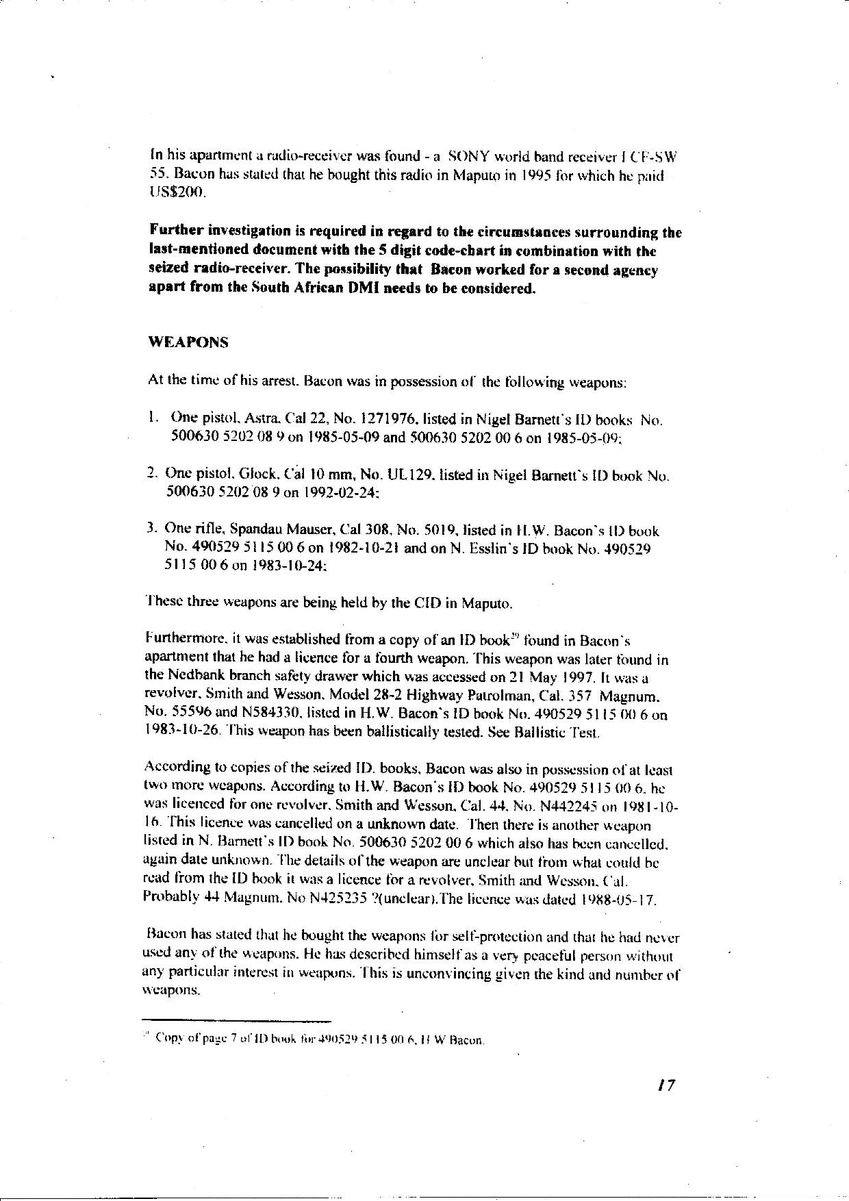
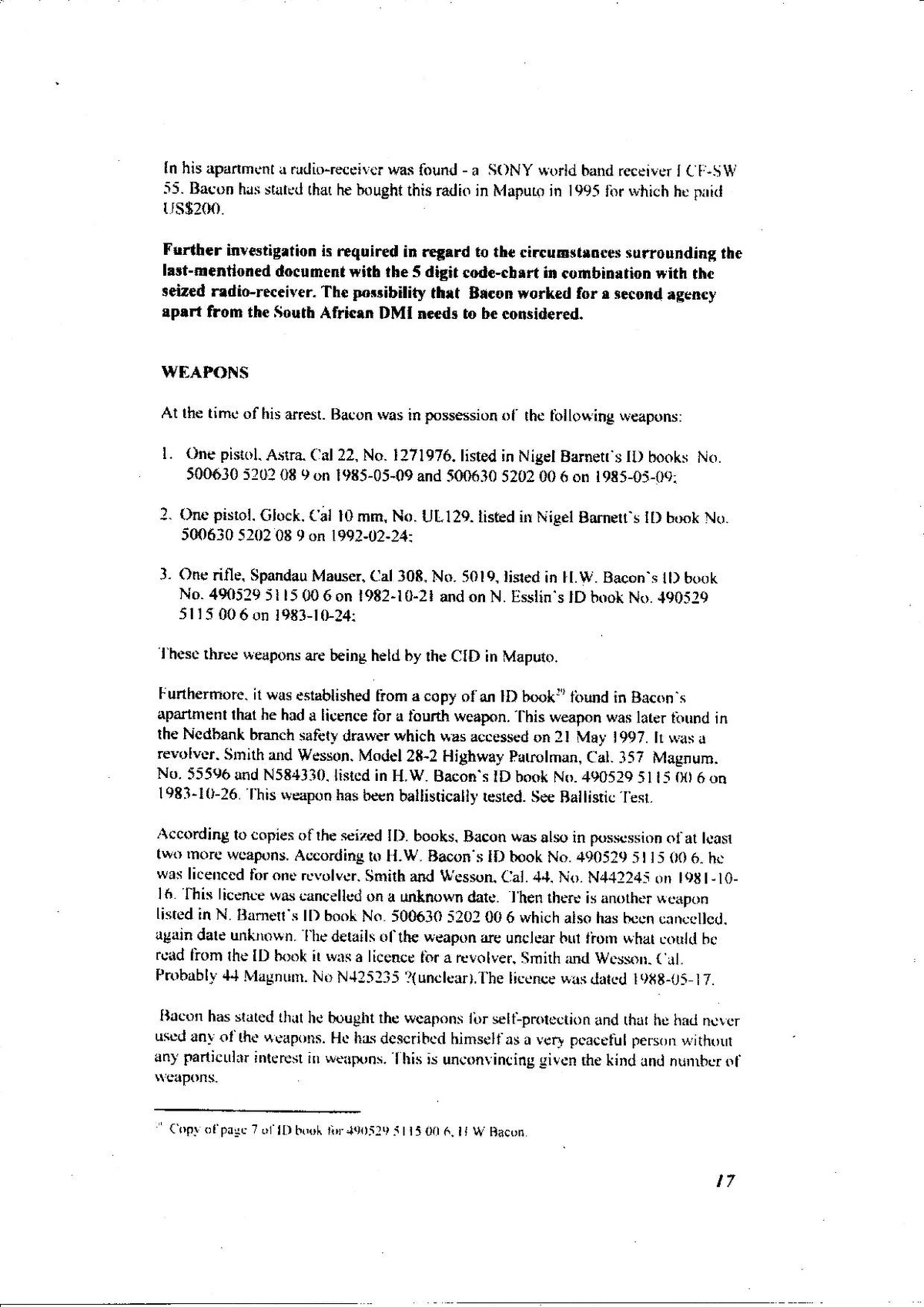
In his apartment a radio-receiver was found - a SONY world hand receiver ICF-SW 55. Bacon has stated that he bought this radio in Maputo in 1995 for which he paid US$200.
Further investigation is required in regard to the circumstances surrounding the last-mentioned document with the 5 digit code-chart in combination with the seized radio-receiver. The possibility that Bacon worked for a second agency apart from the South African DMI needs to be considered.
WEAPONS
At the time of his arrest. Bacon was in possession of the following weapons:
1. One pistol, Astra, Cal 22, No. 1271976, listed in Nigel Barnett's ID books No.
500630 5202 08 9 on 1985-05-09 and 500630 5202 00 6 on 1985-05-09;
2. One pistol. Glock, Cal 10 mm, No. UL129. listed in Nigel Barnett's ID book No.
500630 5202 08 9 on 1992-02-24;
3. One rifle, Spandau Mauser, Cal 308, No. 5019, listed in H.W. Bacon's ID book
No. 490529 5115 00 6 on 1982-10-21 and on N. Esslin's ID book No. 490529 5115 00 6 on 1983-10-24;
These three weapons are being held by the CID in Maputo.
Furthermore, it was established from a copy of an ID book” found in Bacon's apartment that he had a licence for a fourth weapon. This weapon was later found in the Nedbank branch safety drawer which was accessed on 21 May 1997. It was a revolver. Smith and Wesson, Model 28-2 Highway Patrolman, Cal. 357 Magnum, No. 55596 and N584330, listed in H.W. Bacon's ID book No. 490529 5115 00 6 on 1983-10-26. This weapon has been ballistically tested. See Ballistic Test.
According to copies of the seized ID. books, Bacon was also in possession of at least two more weapons. According to H.W. Bacon's ID book No. 490529 5115 00 6. he was licenced for one revolver, Smith and Wesson, Cal. 44. No. N442245 on 1981-1016. This licence was cancelled on a unknown date. Then there is another weapon listed in N. Barnett's ID book No. 500630 5202 00 6 which also has been cancelled. again date unknown. The details of the weapon are unclear but from what could be read from the ID book it was a licence for a revolver, Smith and Wesson. Cal. Probably 44 Magnum, No N425235 ?(unclear). The licence was dated 1988-05-17.
Bacon has stated that he bought the weapons for self-protection and that he had never used any of the weapons. He has described himself as a very peacefUL person without any particular interest in weapons. This is unconvincing given the kind and number of Weapons.
Copy of
page 7uf ID berok for 490529 5115 00 6, 11 W Bacon.
17
Truth & Reconciliation Commission Investigative Unit
28 APRIL 1998
INVESTIGATION REPORT
A DCC OPERATION IN MOZAMBIQUE
Investigator: JAN-AKE KJELLBERG
Truth & Reconciliation Commission Investigative Unit
28 APRIL 1998
INVESTIGATION REPORT
A DCC OPERATION IN MOZAMBIQUE
Investigator: JAN-AKE KJELLBERG
PAYMENT AND BANK ISSUES
The question of payment has been raised with Bacon during the investigation. He has stated that his salary was paid into his bank account in a Standard Bank branch in Durban. In a letter" dated 27 February 1986, which as found in his Nedbank safety deposit drawer, addressed 10 "The Secretary, Unemployment Insurarice Fund, Pretoria“ from Mrs. B M Lightbody of Polaris Shipping, it is stated that Nigel Barnett's monthly salary was RI 250 between 1.12.83. to 31.12.84; RI 500 between 1.1.85. to 31.12.85; and Ri 700 between 1.1.86 to 28.2.86.
From documentation found in his safety drawer, it has been established that he had a Standard Bank Mastercard in the name Bacon, Box 10891, 4056 Marine Parade linked to his Bank account no. 5221 0010 1701 0133. The date when this card was issued has not established. The I.U. is also in the possession of a copy of a Petrol Card slip. dated 26/03/88, showing that he had a card no. 2250 5010 8143 2353 at this date in the name H.W. Bacon. This was linked to a Standard Bank account.
Furthermore, there were also copies of Mastercard slips” found in his safety deposit drawer showing that he used a Mastercard, linked to the Standard Bank account no. 5221 5910 1701 0133, in the name N. Barnett during March 1988. There were also bank statements of this bank account from 1987-88 amongst the documentation.
Amongst the items found in the Durban Nedbank Safety Drawer was also a chequebook issued to H.W. Bacon. The cheques are for a Standard Bank, Beach branch. account no 051428156 06. The checks issued were numbered 0201 to 0230 and 0201 to 0212 were missing from the cheque-book. On the cover of the cheque-book the date 6-11-86 is written by hand.
Following the result of the investigation into the whereabouts of one of the weapons that was in Bacon's possession, it was established that it was kept in a Safety Deposit Box in a Nedbank branch on Smith Street in Durban. Bacon gave authorization for the Safety Deposit Drawer and the Safety Box to be accessed and to remove items found. A copy of the letter, dated 2 May 1997 and signed by Nicho Esslin, giving Mr. Jan-Ake Kjellberg authorization to access the drawer and box is attached. A report." including a list of the seized items is also attached.
According to the records of the bank, the Safety Drawer was rented on 31 January 1986 and the Safety Box on 22 June 1987. Copies of these records are attached.".
1
See footnote no. 20 Copy of a Standard Bank statement concerning a Master Card. Copy of a Standard Bank Master Card slip, dated 5/1/88. Copy of a Master Card slip, dated 24/3/88, R 213,27 Copy of a Standard bank cheque. account no 051428156 06. See tootnote no . See footnote no 6. Copy of a Sate Custody Receipt. + pages.
18
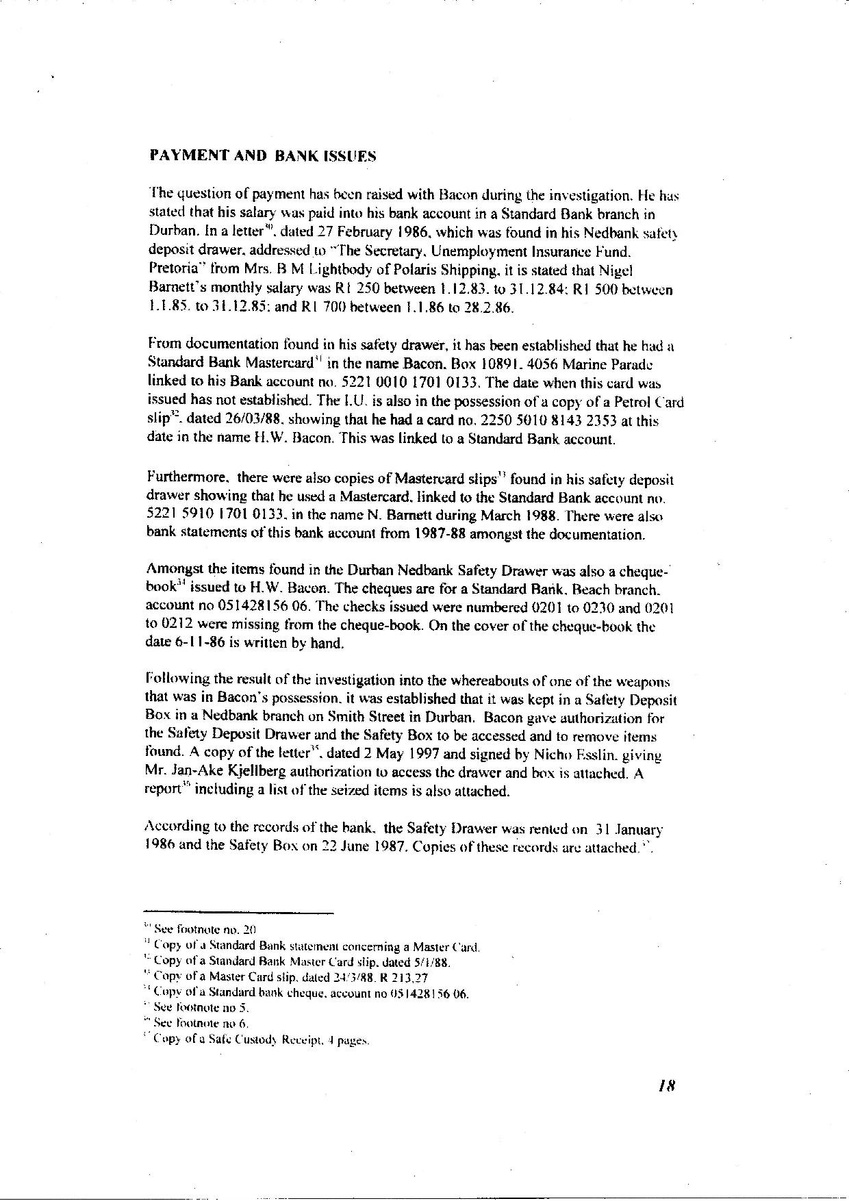
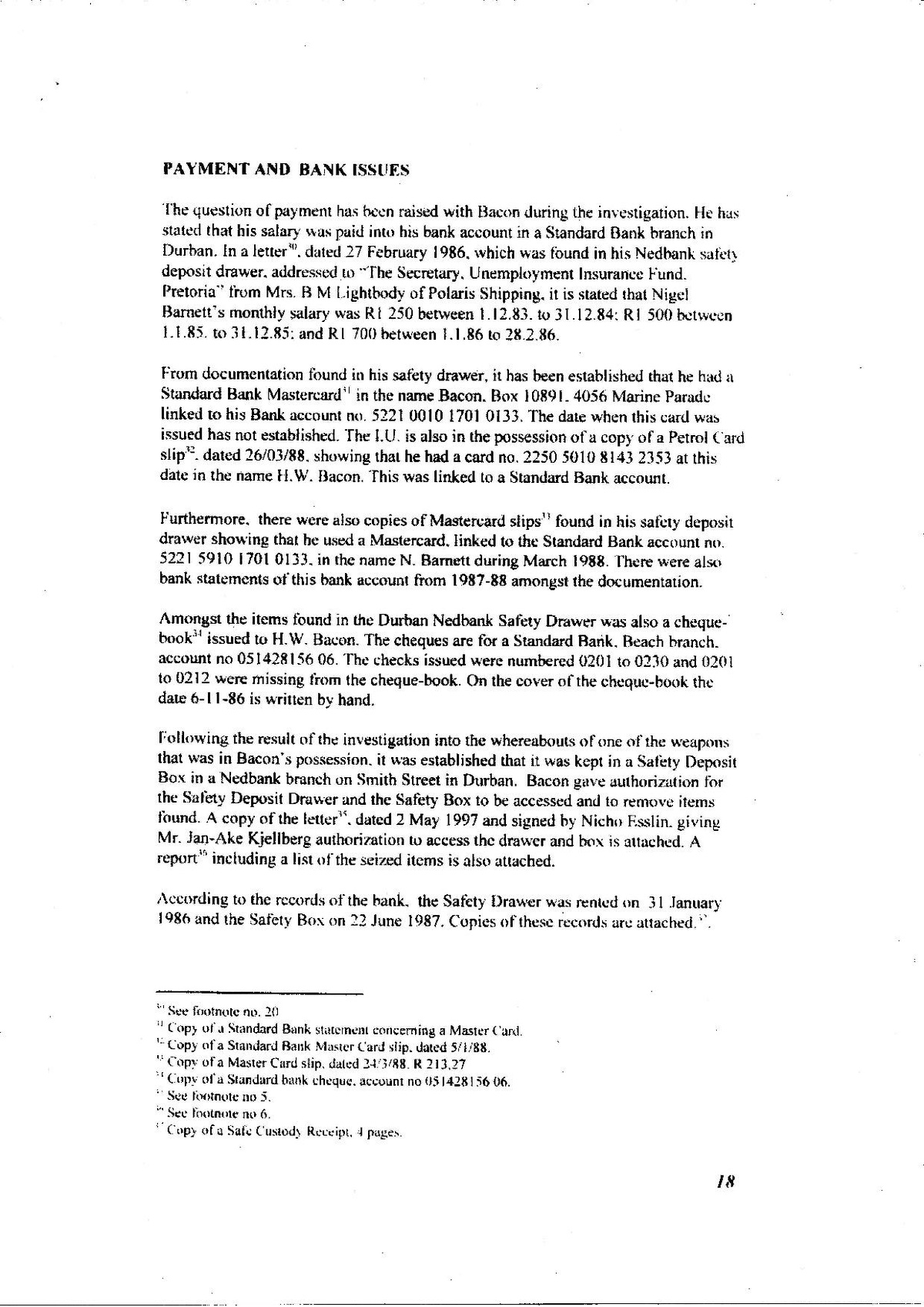
PAYMENT AND BANK ISSUES
The question of payment has been raised with Bacon during the investigation. He has stated that his salary was paid into his bank account in a Standard Bank branch in Durban. In a letter" dated 27 February 1986, which as found in his Nedbank safety deposit drawer, addressed 10 "The Secretary, Unemployment Insurarice Fund, Pretoria“ from Mrs. B M Lightbody of Polaris Shipping, it is stated that Nigel Barnett's monthly salary was RI 250 between 1.12.83. to 31.12.84; RI 500 between 1.1.85. to 31.12.85; and Ri 700 between 1.1.86 to 28.2.86.
From documentation found in his safety drawer, it has been established that he had a Standard Bank Mastercard in the name Bacon, Box 10891, 4056 Marine Parade linked to his Bank account no. 5221 0010 1701 0133. The date when this card was issued has not established. The I.U. is also in the possession of a copy of a Petrol Card slip. dated 26/03/88, showing that he had a card no. 2250 5010 8143 2353 at this date in the name H.W. Bacon. This was linked to a Standard Bank account.
Furthermore, there were also copies of Mastercard slips” found in his safety deposit drawer showing that he used a Mastercard, linked to the Standard Bank account no. 5221 5910 1701 0133, in the name N. Barnett during March 1988. There were also bank statements of this bank account from 1987-88 amongst the documentation.
Amongst the items found in the Durban Nedbank Safety Drawer was also a chequebook issued to H.W. Bacon. The cheques are for a Standard Bank, Beach branch. account no 051428156 06. The checks issued were numbered 0201 to 0230 and 0201 to 0212 were missing from the cheque-book. On the cover of the cheque-book the date 6-11-86 is written by hand.
Following the result of the investigation into the whereabouts of one of the weapons that was in Bacon's possession, it was established that it was kept in a Safety Deposit Box in a Nedbank branch on Smith Street in Durban. Bacon gave authorization for the Safety Deposit Drawer and the Safety Box to be accessed and to remove items found. A copy of the letter, dated 2 May 1997 and signed by Nicho Esslin, giving Mr. Jan-Ake Kjellberg authorization to access the drawer and box is attached. A report." including a list of the seized items is also attached.
According to the records of the bank, the Safety Drawer was rented on 31 January 1986 and the Safety Box on 22 June 1987. Copies of these records are attached.".
1
See footnote no. 20 Copy of a Standard Bank statement concerning a Master Card. Copy of a Standard Bank Master Card slip, dated 5/1/88. Copy of a Master Card slip, dated 24/3/88, R 213,27 Copy of a Standard bank cheque. account no 051428156 06. See tootnote no . See footnote no 6. Copy of a Sate Custody Receipt. + pages.
18
Following the investigation into the possibilities that Bacon was in possession of other safety drawers or safety boxes, inquiries were also made to the Standard Bank Beach branch in Durban. This followed a letter from H.W. Bacon in which he gave authorization to Mr. Jan-Ake Kjellberg to access his security drawer in the bank. The response from the bank was that there was no safety drawer in the bank ither in the name of H.W. Bacon nor in the name of N. Esslin. Bacon was confronted with the result of this inquiry and his response was that he probably made a mistake when he thought that he had a safety box in the Standard Bank branch in Durban. Copies of the letter of authorization*%, letters to the Standard Bank branch in Durban and the written response" thereof are attached. A verbal inquiry was made to the bank regarding the name Nigel Barnett. T'he head of security in the bank would not. however, agree to deal with such a request in the same "informal" way that the other requests had been dealt with. The Nedbank Legal Department advised the TRC to obtain a court order to access this information. At that time of the investigation, it was considered to be not tactical to expose the investigation into this sensitive matter by going to a court with such request. It is, however, suggested that the time has now come when the risk of such exposure could be tactically accepted given the position of the investigation. Such request should also include full information about known and possible bank accounts in various banks.
On 30 May 1997, a letter was sent to the Nedbank branch in Nelspruit requesting information regarding services offered by the bank to H.W. Bacon, N. Esslin and N. Barnett. The telephonic response from the bank came a few days later and stated that there was no service whatsoever offered by the bank to any of these people. A copy of the request to Nedbank is attached.".
There are a number of reasons why it is considered to be important for the investigation to try to establish which bank accounts and bank safety boxes were used by H.W. Bacon. One is to trace the payment into the different bank accounts back to his employer, the Directorate of Covert Collection. Another is to try to obtain further documentation that can further clarify either his background or his activities during the period 1981-97. This could be achieved either through items found in the possible safety boxes or via documentation of transactions concerning his bank accounts. The fact that he continued to use the name H.W. Bacon after 1982/83 for at least one bank account after he had officially changed his name to Nicbo Esslin is of interest.
Copy of letter of authorization. To Standard Bank, Durban. 12 June 1997. *** Three letters sent to Ms. Veronica Christian, Standard Bank, Durban.
Two letters from Standard Bank, dated 19 June 1997. Letter to Ms. Anka, Nedbank. Nielspruit, dated 30 May 1997.
19
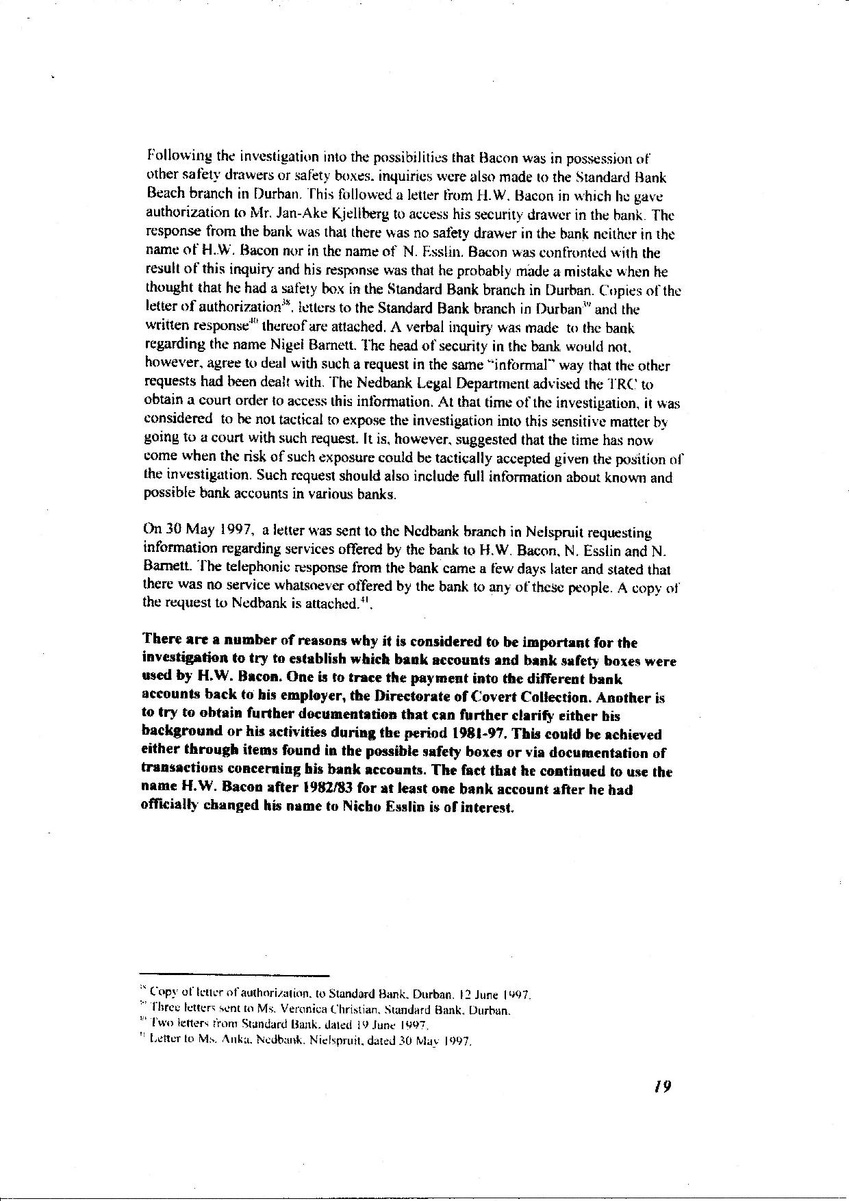
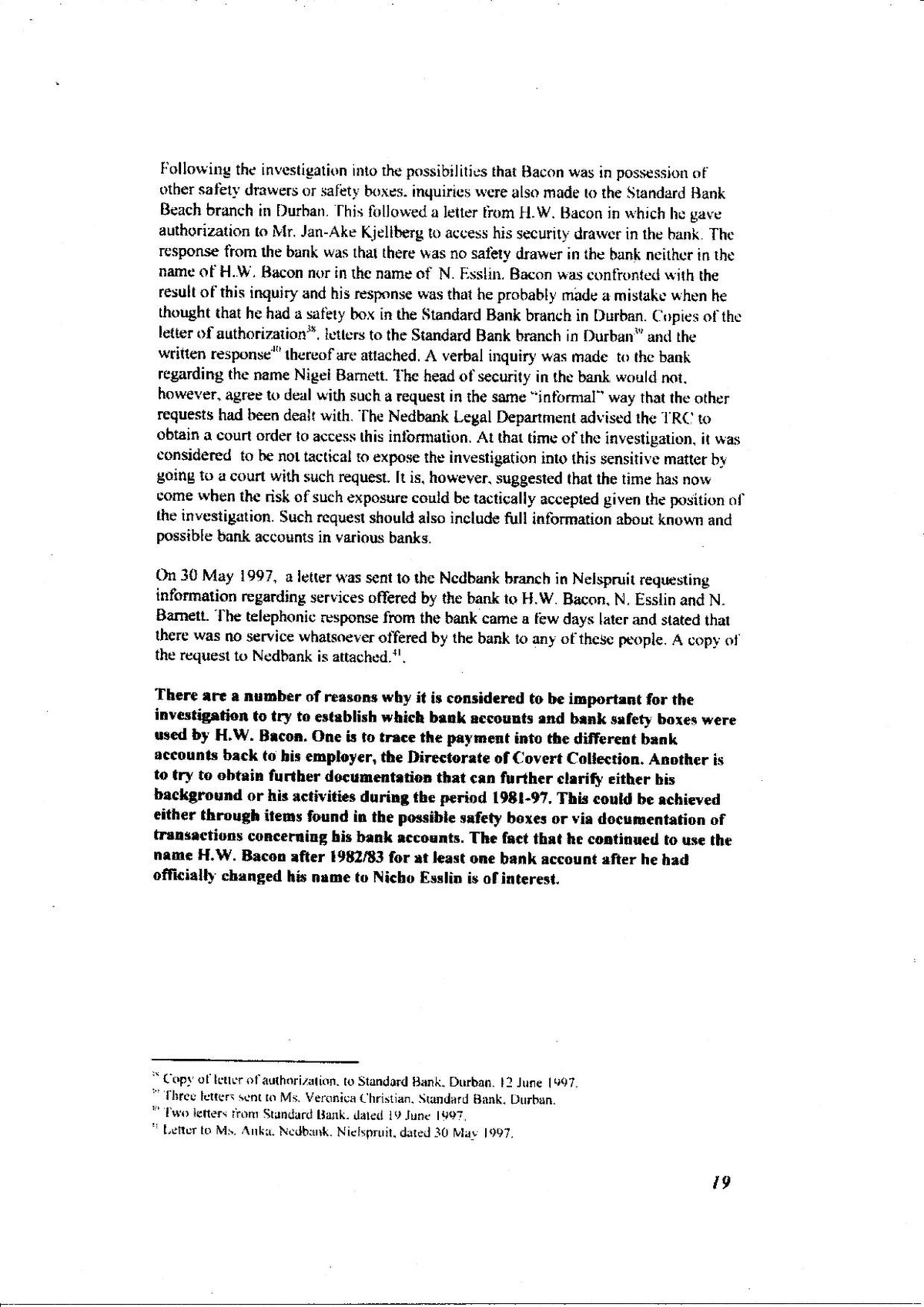
Following the investigation into the possibilities that Bacon was in possession of other safety drawers or safety boxes, inquiries were also made to the Standard Bank Beach branch in Durban. This followed a letter from H.W. Bacon in which he gave authorization to Mr. Jan-Ake Kjellberg to access his security drawer in the bank. The response from the bank was that there was no safety drawer in the bank ither in the name of H.W. Bacon nor in the name of N. Esslin. Bacon was confronted with the result of this inquiry and his response was that he probably made a mistake when he thought that he had a safety box in the Standard Bank branch in Durban. Copies of the letter of authorization*%, letters to the Standard Bank branch in Durban and the written response" thereof are attached. A verbal inquiry was made to the bank regarding the name Nigel Barnett. T'he head of security in the bank would not. however, agree to deal with such a request in the same "informal" way that the other requests had been dealt with. The Nedbank Legal Department advised the TRC to obtain a court order to access this information. At that time of the investigation, it was considered to be not tactical to expose the investigation into this sensitive matter by going to a court with such request. It is, however, suggested that the time has now come when the risk of such exposure could be tactically accepted given the position of the investigation. Such request should also include full information about known and possible bank accounts in various banks.
On 30 May 1997, a letter was sent to the Nedbank branch in Nelspruit requesting information regarding services offered by the bank to H.W. Bacon, N. Esslin and N. Barnett. The telephonic response from the bank came a few days later and stated that there was no service whatsoever offered by the bank to any of these people. A copy of the request to Nedbank is attached.".
There are a number of reasons why it is considered to be important for the investigation to try to establish which bank accounts and bank safety boxes were used by H.W. Bacon. One is to trace the payment into the different bank accounts back to his employer, the Directorate of Covert Collection. Another is to try to obtain further documentation that can further clarify either his background or his activities during the period 1981-97. This could be achieved either through items found in the possible safety boxes or via documentation of transactions concerning his bank accounts. The fact that he continued to use the name H.W. Bacon after 1982/83 for at least one bank account after he had officially changed his name to Nicbo Esslin is of interest.
Copy of letter of authorization. To Standard Bank, Durban. 12 June 1997. *** Three letters sent to Ms. Veronica Christian, Standard Bank, Durban.
Two letters from Standard Bank, dated 19 June 1997. Letter to Ms. Anka, Nedbank. Nielspruit, dated 30 May 1997.
19
POSSIBLE LINK TO THE ASSASSINATION OF OLOF PALME
TAPE RECORDING
Bacon has been asked about the background to this recording. He has stated that it was done in October 1996 in connection with the allegations made by Eugene de Kock about a South African link to the murder of Olof Palme. According to Bacon, he recorded the broadcast from Radio Sweden, an international Swedish radio station, broadcasting in English, for a Swedish friend living in Maputo. This was at a time when there was a lot of discussion in Maputo about the murder, mainly because of the allegations against Anthony White, living in Mozambique.
a
However, the person who initially reported Bacon to the police in Maputo. Richard Fair, has stated that he found the tape already late in 1995. after Bacon had been living on his property. The tape was then kept by Fair until March 1997 when he reported Bacon for the attempted arson and handed over the tape to the police.
Because of difficulties of getting the tape or a copy of it from the police in Maputo, it has not been possible to establish when this programme was broadcast. The fact that Radio Sweden, on several occasions since 1986, has broadcast programmes related to the murder of Olof Palme, makes it impossible to establish the date of the broadcast without having a copy of the complete recording. A copy of the tape-recording has been requested on a number of occasions.
a
VISITS TO SWEDEN
Bacon stated verbally and in a handwritten submission shortly after he was arrested that he had visited Sweden on three occasions:
When he was two/two and a half years old, together with his parents. He stated that he couldn't recall any details of this trip to Sweden because of his age. Bacon was born 1949 so this would obviously be in 1952.
.
In 1980/81 when he visited relatives of his stepmother in the northern part of Sweden. He also stayed in Stockholm for a few days on this occasion.
In 1988/89 when he visited other relatives of his stepmother in the northern part of Sweden. Fle also stayed in Stockholm for a few days on this occasion.
Based on information obtained from people who have been interviewed in Sweden. the following has been established about other trips to Sweden:
• In 1956 Bacon visited Sweden together with his mother, father and brother. He mer
with people related to his mother. This has been contirmed by people who met with him. His brother. Olaf Bacon, has also confirmed this. According to his brother. this was the first trip that he and his brother made to Sweden. Olat Bacon is to years older than his brother.
20
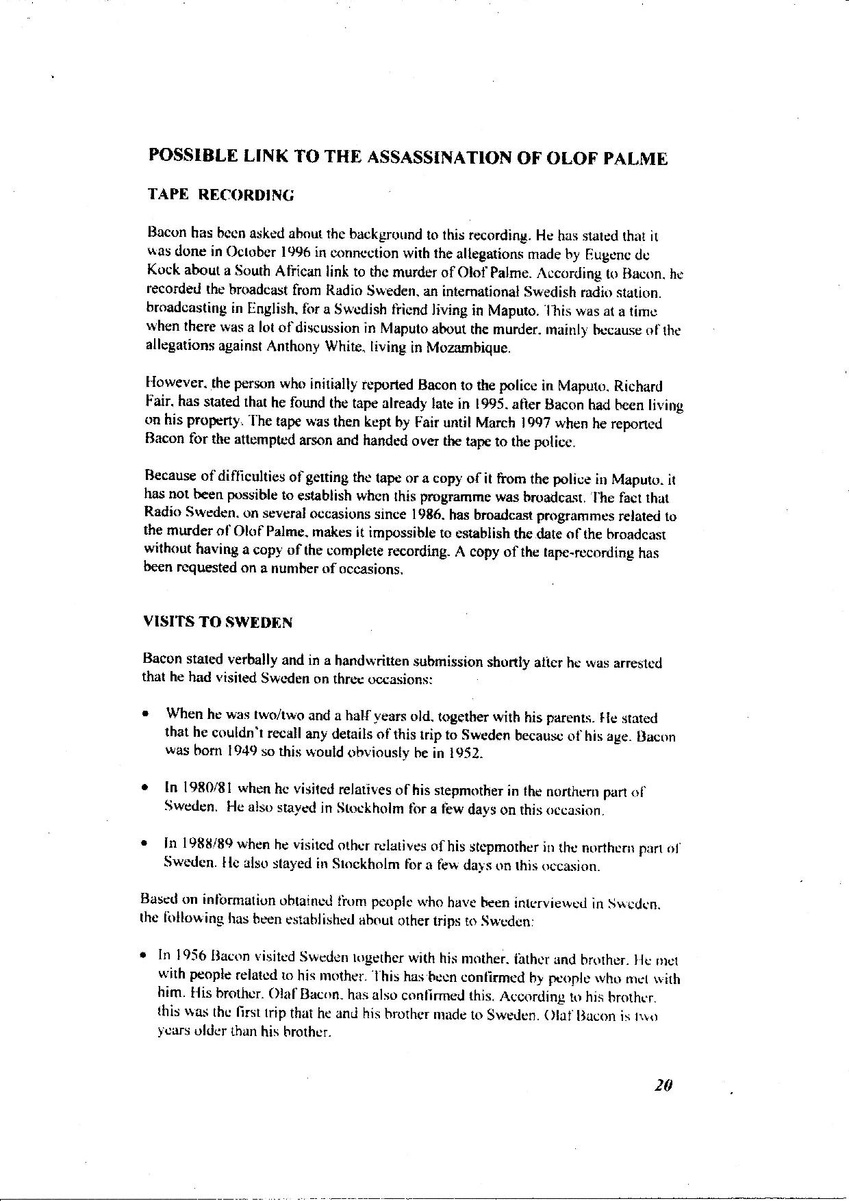
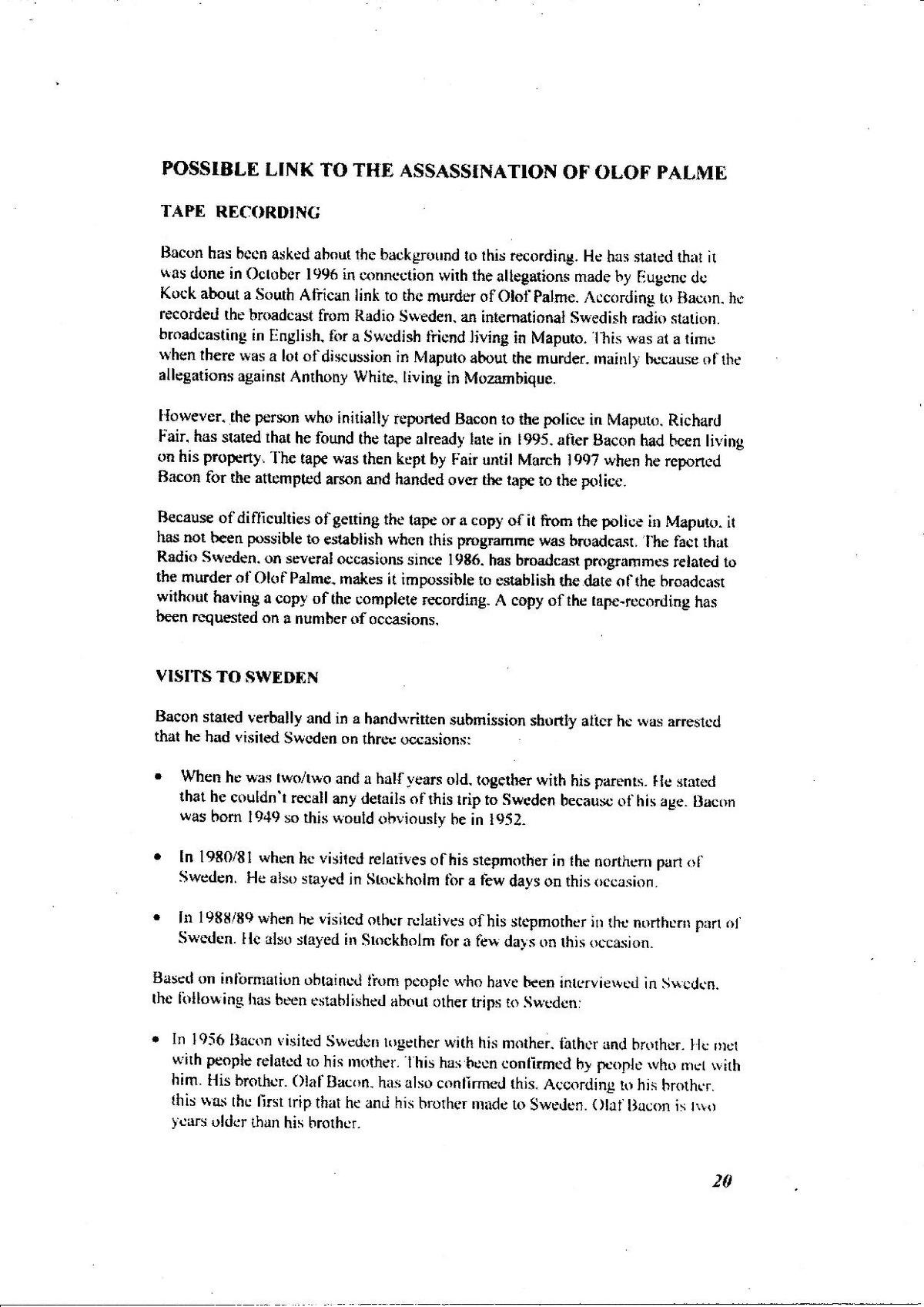
POSSIBLE LINK TO THE ASSASSINATION OF OLOF PALME
TAPE RECORDING
Bacon has been asked about the background to this recording. He has stated that it was done in October 1996 in connection with the allegations made by Eugene de Kock about a South African link to the murder of Olof Palme. According to Bacon, he recorded the broadcast from Radio Sweden, an international Swedish radio station, broadcasting in English, for a Swedish friend living in Maputo. This was at a time when there was a lot of discussion in Maputo about the murder, mainly because of the allegations against Anthony White, living in Mozambique.
a
However, the person who initially reported Bacon to the police in Maputo. Richard Fair, has stated that he found the tape already late in 1995. after Bacon had been living on his property. The tape was then kept by Fair until March 1997 when he reported Bacon for the attempted arson and handed over the tape to the police.
Because of difficulties of getting the tape or a copy of it from the police in Maputo, it has not been possible to establish when this programme was broadcast. The fact that Radio Sweden, on several occasions since 1986, has broadcast programmes related to the murder of Olof Palme, makes it impossible to establish the date of the broadcast without having a copy of the complete recording. A copy of the tape-recording has been requested on a number of occasions.
a
VISITS TO SWEDEN
Bacon stated verbally and in a handwritten submission shortly after he was arrested that he had visited Sweden on three occasions:
When he was two/two and a half years old, together with his parents. He stated that he couldn't recall any details of this trip to Sweden because of his age. Bacon was born 1949 so this would obviously be in 1952.
.
In 1980/81 when he visited relatives of his stepmother in the northern part of Sweden. He also stayed in Stockholm for a few days on this occasion.
In 1988/89 when he visited other relatives of his stepmother in the northern part of Sweden. Fle also stayed in Stockholm for a few days on this occasion.
Based on information obtained from people who have been interviewed in Sweden. the following has been established about other trips to Sweden:
• In 1956 Bacon visited Sweden together with his mother, father and brother. He mer
with people related to his mother. This has been contirmed by people who met with him. His brother. Olaf Bacon, has also confirmed this. According to his brother. this was the first trip that he and his brother made to Sweden. Olat Bacon is to years older than his brother.
20
• In 1975 he met with relatives in Stockholm. They were contacted by Bacon and
met with him once in their home in Stockholm.
• In July 1987 he visited Skelleftea in Sweden and met with several relatives. A
young Swedish girl who lived in Maputo with her father from August 1986 to late 1987 has stated that she knew Bacon from Maputo and that she was on a holiday trip to Sweden in June-July 1987 and coincidentally met Bacon in Stockholm at the end of June or in early July 1987. A flight-ticker" in Bacon's name was found in his safety-deposit box in the Nedbank Branch in Durban. The ticket was issued for a flight from Johannesburg via Amsterdam to Stockholm on 27 June 1987 and with a return flight from Stockholm via Zurich to Johannesburg on 11 July 1987.
When Bacon was confronted with this information, he still maintained that he had only visited Sweden in 1980/81 and probably in 1988. His “handler“ has mentioned that he could have been sent to Sweden in the beginning of the 80's to gather information about specific diving equipment for the navy. This was an intelligence operation, probably for the DCC.
Bacon has also repeated on different occasions that he has been in Sweden when it was very cold and he has also mentioned that he saw snow on one of his visits. None of the visits to Sweden to which he admits were undertaken when it was possible for him to have seen snow. However, it is worth noting that Palme's murder occurred in February 1986 when it was cold and there was snow in Stockholm.
BALLISTIC TEST
A ballistics test was done on the Smith and Wesson revolver found in Bacon's Nedbank safety deposit box in Durban using a number of rounds of the type of ammunition found at the scene of Palme's murder. Ten bullets were sent to the Swedish Forensic Laboratory for testing. The results were negative. They did not match with the bullets found at the scene of the murder. The weapon was also examined for the presence of finger or palm prints. The results of this were also negative.
POLYGRAPH EXAMINATION
On 18 April 1997, a Polygraph test was carried out on Bacon relating to the investigation into the murder of Palme. The test was arranged by the investigative unit in Maputo and was carried out in the Machava Prison in Maputo.
The examiner concluded that the examinee was Deceptive Indicative. This conclusion was based on the reactions to the specific questions on the assassination. A
2
Flight ticket found in the Nedbank. safety deposit box. See footnote no 13.
1
21
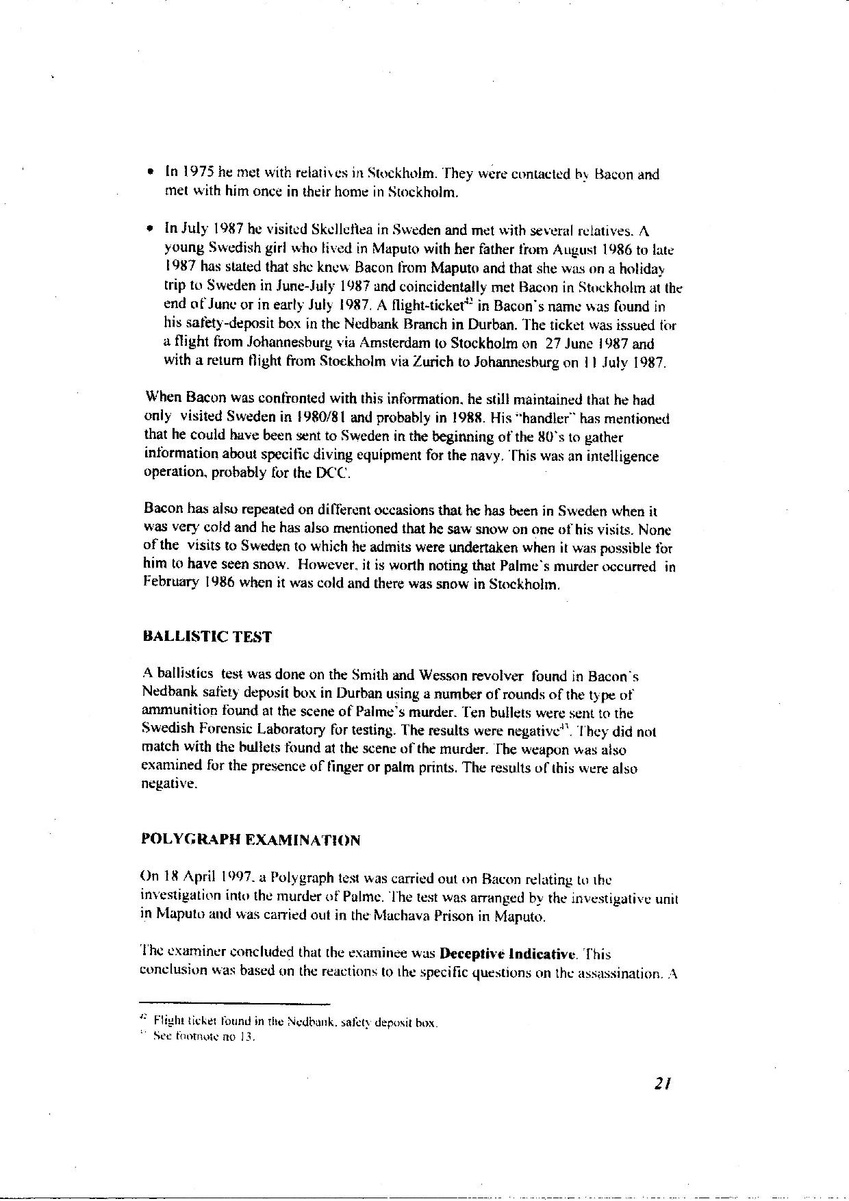
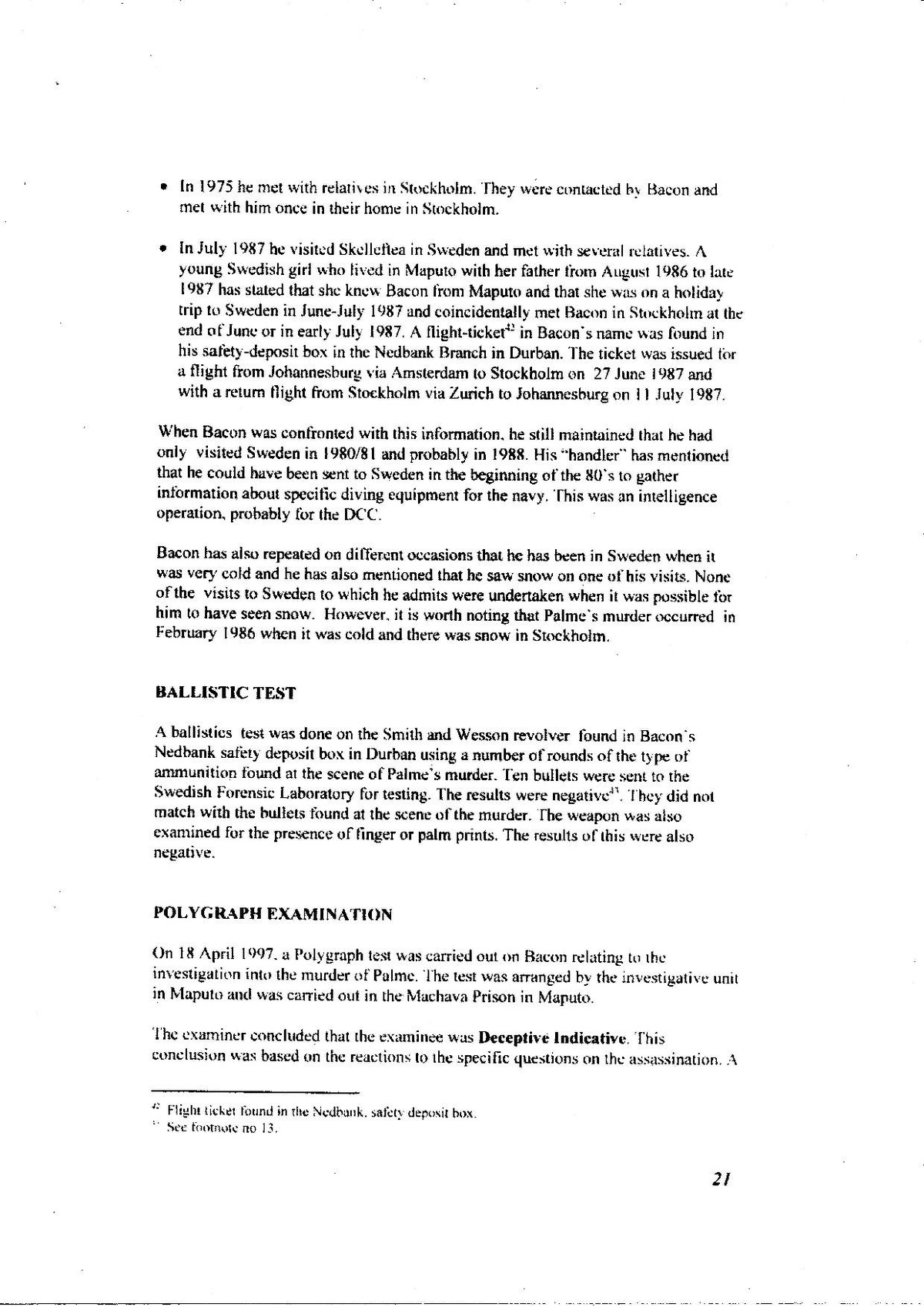
• In 1975 he met with relatives in Stockholm. They were contacted by Bacon and
met with him once in their home in Stockholm.
• In July 1987 he visited Skelleftea in Sweden and met with several relatives. A
young Swedish girl who lived in Maputo with her father from August 1986 to late 1987 has stated that she knew Bacon from Maputo and that she was on a holiday trip to Sweden in June-July 1987 and coincidentally met Bacon in Stockholm at the end of June or in early July 1987. A flight-ticker" in Bacon's name was found in his safety-deposit box in the Nedbank Branch in Durban. The ticket was issued for a flight from Johannesburg via Amsterdam to Stockholm on 27 June 1987 and with a return flight from Stockholm via Zurich to Johannesburg on 11 July 1987.
When Bacon was confronted with this information, he still maintained that he had only visited Sweden in 1980/81 and probably in 1988. His “handler“ has mentioned that he could have been sent to Sweden in the beginning of the 80's to gather information about specific diving equipment for the navy. This was an intelligence operation, probably for the DCC.
Bacon has also repeated on different occasions that he has been in Sweden when it was very cold and he has also mentioned that he saw snow on one of his visits. None of the visits to Sweden to which he admits were undertaken when it was possible for him to have seen snow. However, it is worth noting that Palme's murder occurred in February 1986 when it was cold and there was snow in Stockholm.
BALLISTIC TEST
A ballistics test was done on the Smith and Wesson revolver found in Bacon's Nedbank safety deposit box in Durban using a number of rounds of the type of ammunition found at the scene of Palme's murder. Ten bullets were sent to the Swedish Forensic Laboratory for testing. The results were negative. They did not match with the bullets found at the scene of the murder. The weapon was also examined for the presence of finger or palm prints. The results of this were also negative.
POLYGRAPH EXAMINATION
On 18 April 1997, a Polygraph test was carried out on Bacon relating to the investigation into the murder of Palme. The test was arranged by the investigative unit in Maputo and was carried out in the Machava Prison in Maputo.
The examiner concluded that the examinee was Deceptive Indicative. This conclusion was based on the reactions to the specific questions on the assassination. A
2
Flight ticket found in the Nedbank. safety deposit box. See footnote no 13.
1
21
copy of the Polygraph Examination Report is attached. Deceptive Indicative is a term used for persons showing the strongest reactions during a polygraph test.
CONNECTION TO OTHER SECURITY / INTELLIGENCE PERSONNEL
Richard Fair, who initially reported Bacon to the police, has stated that he witnessed Bacon on one occasion telephoning Anthony White from Fair's house in Maputo. The telephone call was made in the presence of Fair's parents. Bacon has denied any contacts with Anthony White. There was also a handwritten note's found in Bacon's belongings in which Anthony White's name was mentioned.
In his statements, Bacon has mentioned a number of people who either "handled" him as an agent or were involved in other ways in his activities as a DCC operator. They are At Nel, Adolf Van der Berg, and H. W. Doncaster.
It is recommended that a plan be developed to follow through on this information. It should include a decision to obtain the alternative identities used by these people, through the passport register in the Department of Home Affairs, and also the obtaining of Bacon's MI file.
PASSPORTS/ IDENTITIES
As noted above. Bacon has had at least three different identities/passports during his time as an operator in Mozambique:
.
Henry William Bacon: It has been established that he used a passport in the name Bacon when he purchased his flight-ticket to Sweden in 1987. He claims that he kept this passport after he officially changed his name in 1982. This passport has not been found. Bacon says he threw it away when it expired. Furthermore, it has been established that he was in possession of a petrol credit card in the name of H.W. Bacon, linked to a Standard Bank account until at least 1988. The l.U. is also in possession of a copy of an ID book " issued 1981-10-16 in the name H.W. Bacon.
16
Nicho Esslin: Officially he changed his name to Esslin in late 1982. This has been established by documentation obtained from Home Affairs in Pretoria. A copy a the Government Gazette", dated 10 December 1982, is attached. A copy of an ID book '*, issued 1983-10-21, was found in his apartment in Maputo. He has stated that this name change was done on his own initiative and purely for personal reasons. It is important to note that his handler in the period April 1994 -
Polygraph Examination Report. Copy of a handwritten note. Copy of a ID book. ID no 190529 5115 00 6. H.W. Bacon. See footnute no 7 Copy of ID book. ID no 4905295115 00 6. Nicho Esslin, issued 1983-10-21.
1
22
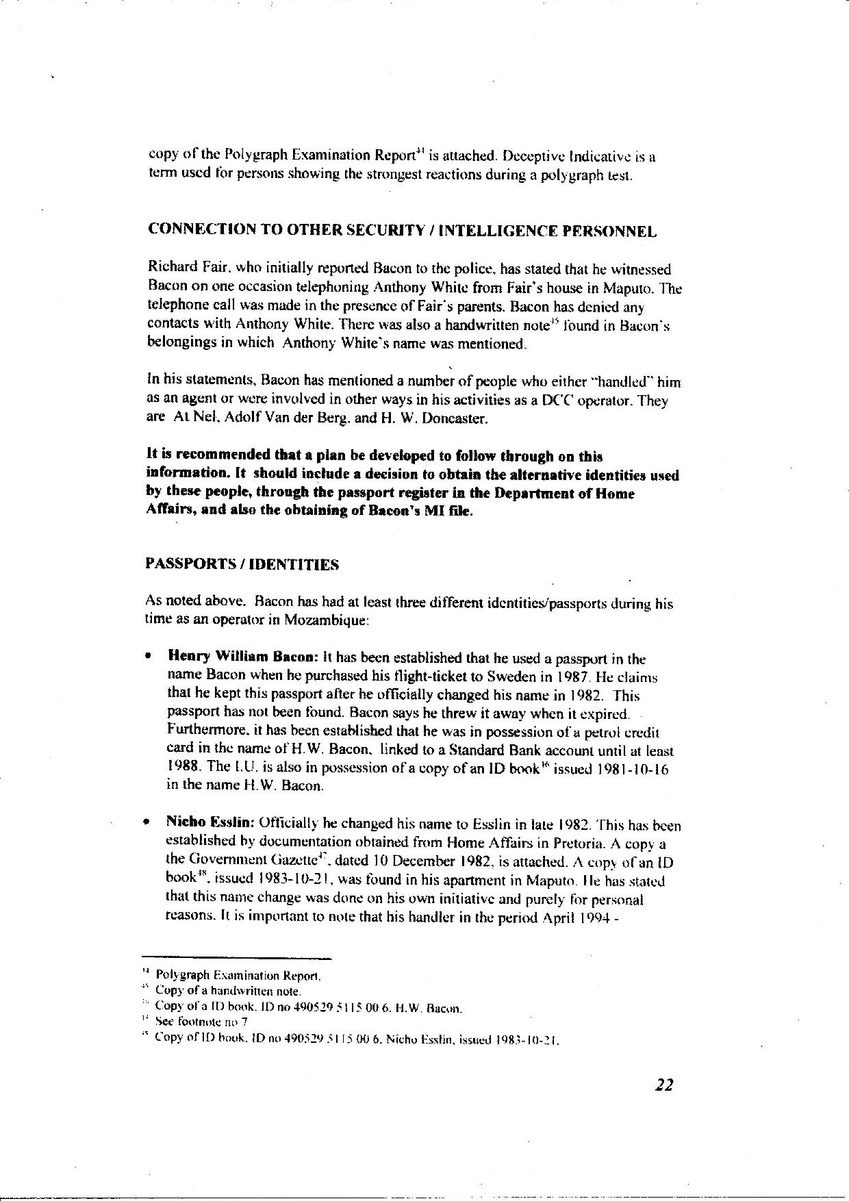
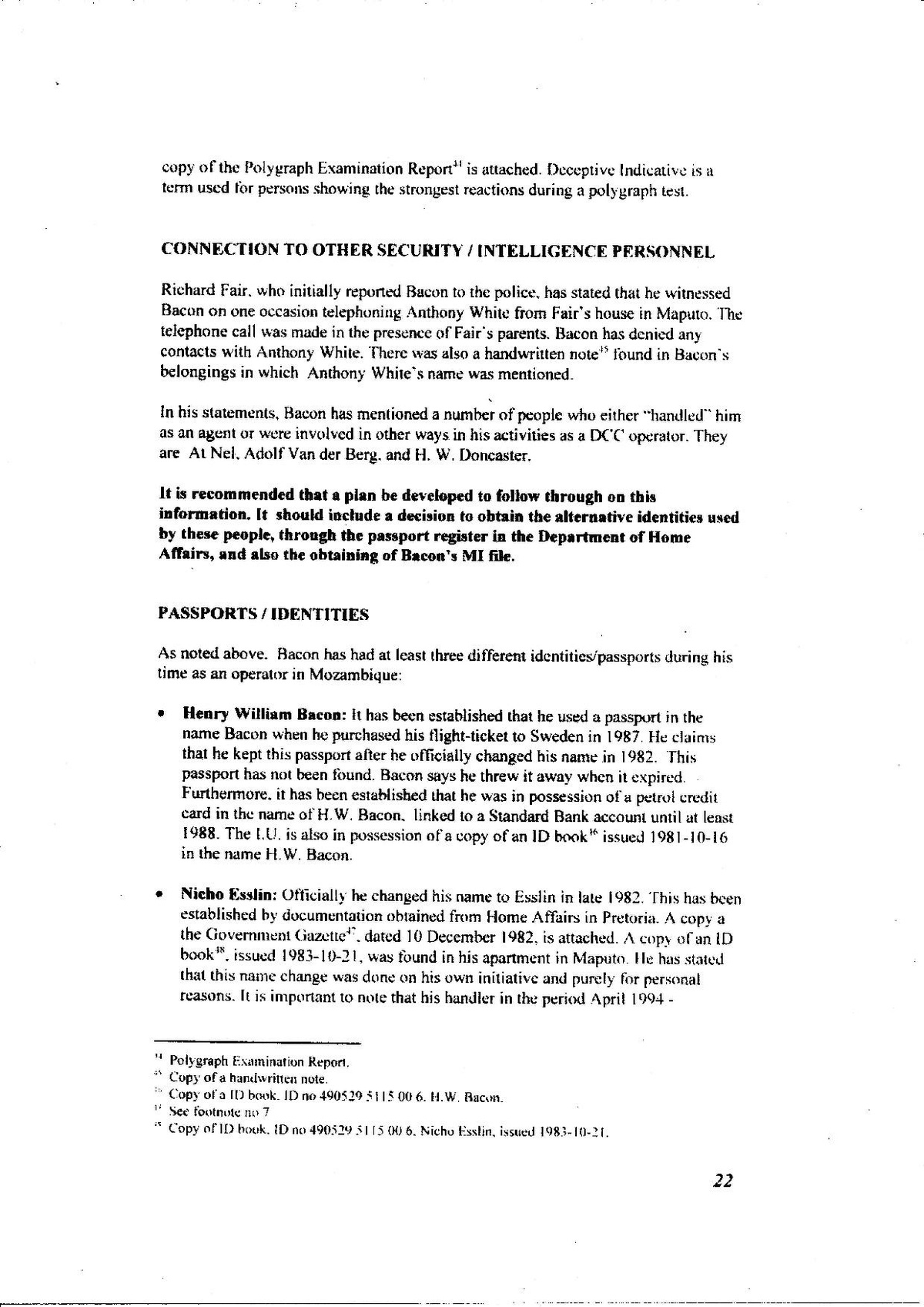
copy of the Polygraph Examination Report is attached. Deceptive Indicative is a term used for persons showing the strongest reactions during a polygraph test.
CONNECTION TO OTHER SECURITY / INTELLIGENCE PERSONNEL
Richard Fair, who initially reported Bacon to the police, has stated that he witnessed Bacon on one occasion telephoning Anthony White from Fair's house in Maputo. The telephone call was made in the presence of Fair's parents. Bacon has denied any contacts with Anthony White. There was also a handwritten note's found in Bacon's belongings in which Anthony White's name was mentioned.
In his statements, Bacon has mentioned a number of people who either "handled" him as an agent or were involved in other ways in his activities as a DCC operator. They are At Nel, Adolf Van der Berg, and H. W. Doncaster.
It is recommended that a plan be developed to follow through on this information. It should include a decision to obtain the alternative identities used by these people, through the passport register in the Department of Home Affairs, and also the obtaining of Bacon's MI file.
PASSPORTS/ IDENTITIES
As noted above. Bacon has had at least three different identities/passports during his time as an operator in Mozambique:
.
Henry William Bacon: It has been established that he used a passport in the name Bacon when he purchased his flight-ticket to Sweden in 1987. He claims that he kept this passport after he officially changed his name in 1982. This passport has not been found. Bacon says he threw it away when it expired. Furthermore, it has been established that he was in possession of a petrol credit card in the name of H.W. Bacon, linked to a Standard Bank account until at least 1988. The l.U. is also in possession of a copy of an ID book " issued 1981-10-16 in the name H.W. Bacon.
16
Nicho Esslin: Officially he changed his name to Esslin in late 1982. This has been established by documentation obtained from Home Affairs in Pretoria. A copy a the Government Gazette", dated 10 December 1982, is attached. A copy of an ID book '*, issued 1983-10-21, was found in his apartment in Maputo. He has stated that this name change was done on his own initiative and purely for personal reasons. It is important to note that his handler in the period April 1994 -
Polygraph Examination Report. Copy of a handwritten note. Copy of a ID book. ID no 190529 5115 00 6. H.W. Bacon. See footnute no 7 Copy of ID book. ID no 4905295115 00 6. Nicho Esslin, issued 1983-10-21.
1
22
December 1995 (Doncaster) identified him as H.W. Bacon and Nigel Barnett. The name Esslin was unknown to him.
.
Nigel Barnett: This name was given to him when he started his operation in Mozambique in 1983 or 1984. At least two passports in this name were issued. One" issued 1992-11-16 with an expiry date 1997-11-15 was found when he was
1 arrested and another " issued 1990-01-22 with an expiry date 1995-01-21 was found in his safety drawer in the Durban Nedbank branch.
30
It would be of interest to establish if Bacon was ever in possession of any other passports. Information has been obtained from people who know him in Maputo that he on several occasions mentioned that he had Swedish and British passports. None. however, had seen any of these passports. One of his DCC handlers has given information about a meeting between the handler and Bacon which took place in January 1985 in Pretoria at which Bacon showed the handler a Swedish passport. Bacon told him he had a female contact at the Swedish embassy in Maputo who had supplied him with the passport. The handler did not see if there was any name written in the passport.
A list of all passports issued to the Swedish embassy in Maputo from 1983 to 1986 by the Department of Foreign Affairs in Stockholm has been obtained. The list" was sent to the investigation team in Stockholm on 13 Aug. 1997. The aim was to establish any falsification or loss of passports. The result of the investigation in Stockholm have been reported verbally and the conclusion was that there were no passports issued to non-existent people and there were no reported losses of passports.
A Mozambique passport was found amongst Bacon's belongings in the Nedbank safety deposit box. The passport, no H 000001, bore no name. Bacon alleges he was given this passport by another South African intelligence agent based in Mozambique by the name of John Burch who was later arrested by the Mozambique Police for his intelligence activities. Burch was extradited to South Africa after his arrest.
a
A letter dated 87.10.25 and written in Swedish was found in his safety box in Durban. It is signed by and addressed to “Henry“. In it Mrs.
asks Bacon to send copies of his birth certificate. 3 photographs and other personal details. According to the letter, this information is for a Swedish passport for H. W Bacon. A copy of the letter is attached." A statement has been obtained from Ms.
by the Swedish investigators in which she states that she was asked by Bacon during his visit to Sweden in July 1987 if she could arrange a Swedish passport for him. The letter is obviously the response.
1)
Copy of a Passport ID no 500630 5202 00 6. Nigel Barnett, issued 1990-01-22. Copy of a Passport ID no 500630 5202 00 6. Nigel Barnett, issued 1992-11-16. See footnote no 9. A second meeting with the “Handler“. See footnote no ll. A handwritten letter "Hej Henry“ 2 pages.
23
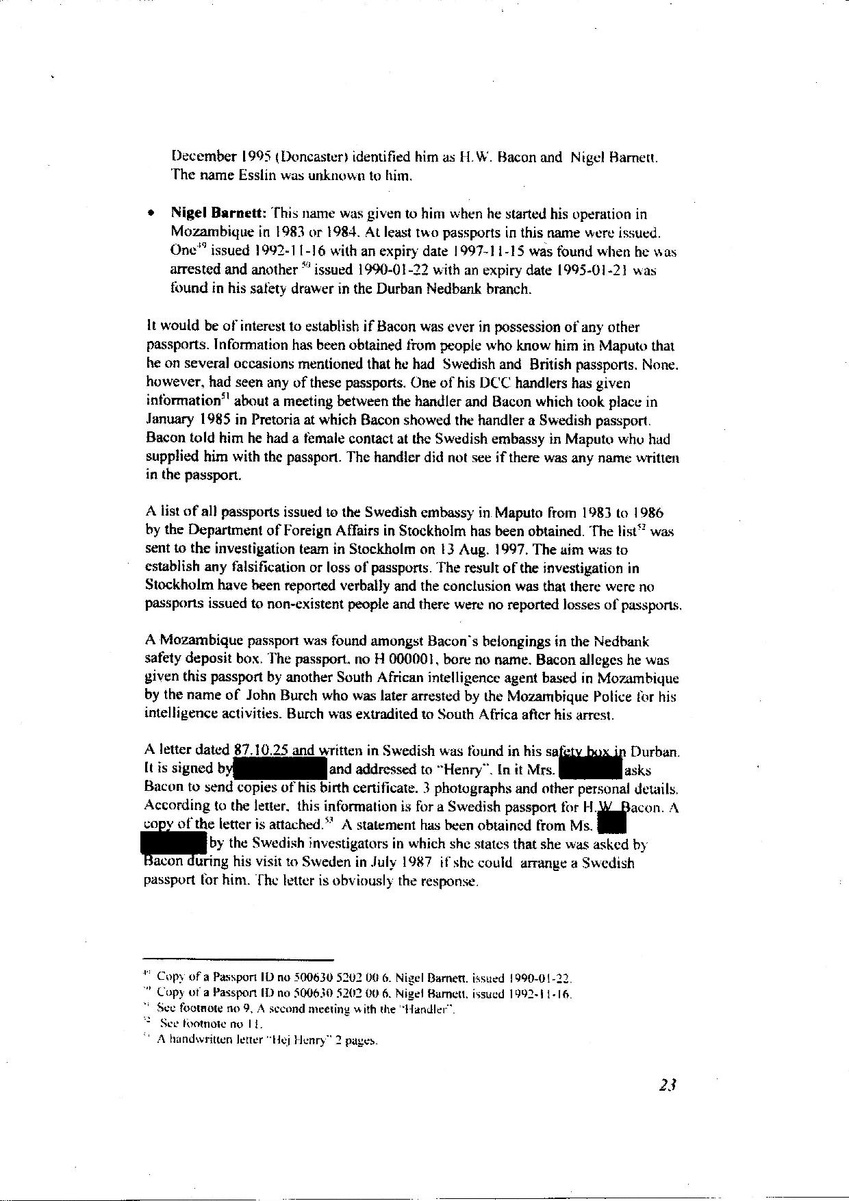
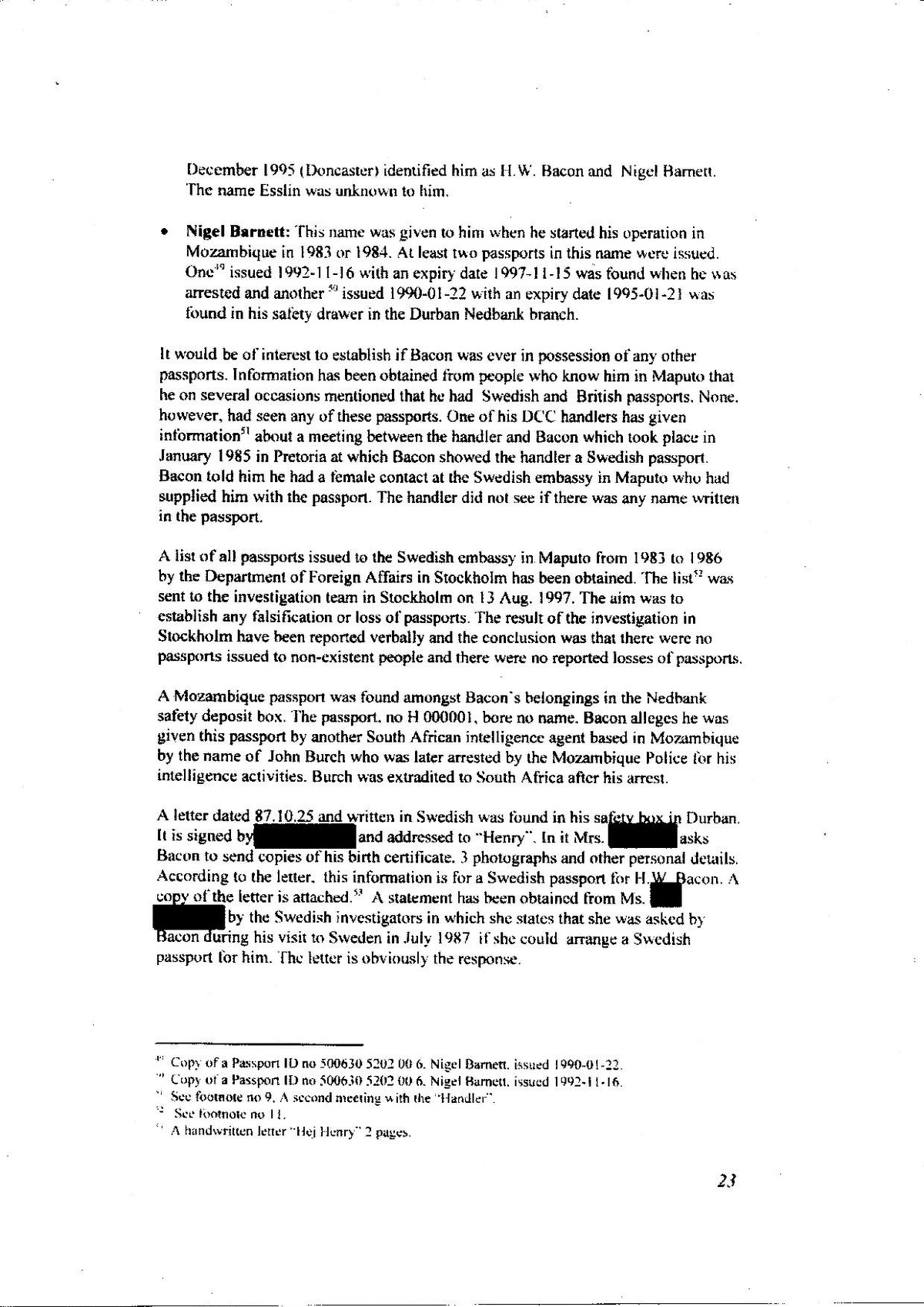
December 1995 (Doncaster) identified him as H.W. Bacon and Nigel Barnett. The name Esslin was unknown to him.
.
Nigel Barnett: This name was given to him when he started his operation in Mozambique in 1983 or 1984. At least two passports in this name were issued. One" issued 1992-11-16 with an expiry date 1997-11-15 was found when he was
1 arrested and another " issued 1990-01-22 with an expiry date 1995-01-21 was found in his safety drawer in the Durban Nedbank branch.
30
It would be of interest to establish if Bacon was ever in possession of any other passports. Information has been obtained from people who know him in Maputo that he on several occasions mentioned that he had Swedish and British passports. None. however, had seen any of these passports. One of his DCC handlers has given information about a meeting between the handler and Bacon which took place in January 1985 in Pretoria at which Bacon showed the handler a Swedish passport. Bacon told him he had a female contact at the Swedish embassy in Maputo who had supplied him with the passport. The handler did not see if there was any name written in the passport.
A list of all passports issued to the Swedish embassy in Maputo from 1983 to 1986 by the Department of Foreign Affairs in Stockholm has been obtained. The list" was sent to the investigation team in Stockholm on 13 Aug. 1997. The aim was to establish any falsification or loss of passports. The result of the investigation in Stockholm have been reported verbally and the conclusion was that there were no passports issued to non-existent people and there were no reported losses of passports.
A Mozambique passport was found amongst Bacon's belongings in the Nedbank safety deposit box. The passport, no H 000001, bore no name. Bacon alleges he was given this passport by another South African intelligence agent based in Mozambique by the name of John Burch who was later arrested by the Mozambique Police for his intelligence activities. Burch was extradited to South Africa after his arrest.
a
A letter dated 87.10.25 and written in Swedish was found in his safety box in Durban. It is signed by and addressed to “Henry“. In it Mrs.
asks Bacon to send copies of his birth certificate. 3 photographs and other personal details. According to the letter, this information is for a Swedish passport for H. W Bacon. A copy of the letter is attached." A statement has been obtained from Ms.
by the Swedish investigators in which she states that she was asked by Bacon during his visit to Sweden in July 1987 if she could arrange a Swedish passport for him. The letter is obviously the response.
1)
Copy of a Passport ID no 500630 5202 00 6. Nigel Barnett, issued 1990-01-22. Copy of a Passport ID no 500630 5202 00 6. Nigel Barnett, issued 1992-11-16. See footnote no 9. A second meeting with the “Handler“. See footnote no ll. A handwritten letter "Hej Henry“ 2 pages.
23
Names used by Bacon during this period could be of interest because it could be compared with a list of names registered at hotels in Stockholm in February 1986.
CONFERENCE IN STOCKHOLM
A list of participants at the conference in Stockholm the week before the assassination has been obtained. The list is probably not complete but should be evaluated for any possible connection with the security / intelligence establishment in South Africa at the time. A copy of the list is attached."
REPRESENTATION AT THE SOUTH AFRICAN LEGATION IN STOCKHOLM
Based on the fact that the Palme murder occurred only ten minute's walk from the SA Legation in Stockholm and that embassy facilities were used in the execution of other operations in Europe ( e.g., the bombing of the ANC office in London in May 1982). the identity of the security / intelligence legal officers linked to the representation in Stockholm should be established A full list of staff based or linked to the Stockholm office has been obtained but has not been evaluated. A copy of a letter from the Department of Foreign Affairs and including the list is attached. **
EUGENE DE KOCK'S TESTIMONY
As mentioned earlier in this report, Eugene De Kock gave evidence to the Pretoria Supreme Court in September 1996 implicating the security forces of South Africa in the murder of Olof Palme. De Kock has also included his alleged knowledge of the assassination in his amnesty application to the TRC.
A detailed statement has been obtained from De Kock which is attached." In his statement, he states he was given information by Philip Powell about the identity of the murderer on two occasions in 1993-94. He also implicates Craig Williamson in the assassination. A copy of the statement has also been forwarded to Ilan Lax of the TRC office in Durban to be used in the questioning of Philip Powell.
A PARALLEL INTELLIGENCE OPERATION.
During the investigation into Bacon's activities by the Mozambique authorities a Mozambique citizen named Carlos Pinto was arrested on suspicion of involvement in Bacon's intelligence operation. He has stated that he was introduced to Nigel Barnett
Motesplats Afrika, in Swedish. 2 pages. Letter from Department of Foreign Affairs, dated 01 September 1997, 0 pages.
6 Sworn statement, Eugene Alexander De Kock. 8 pages.
24
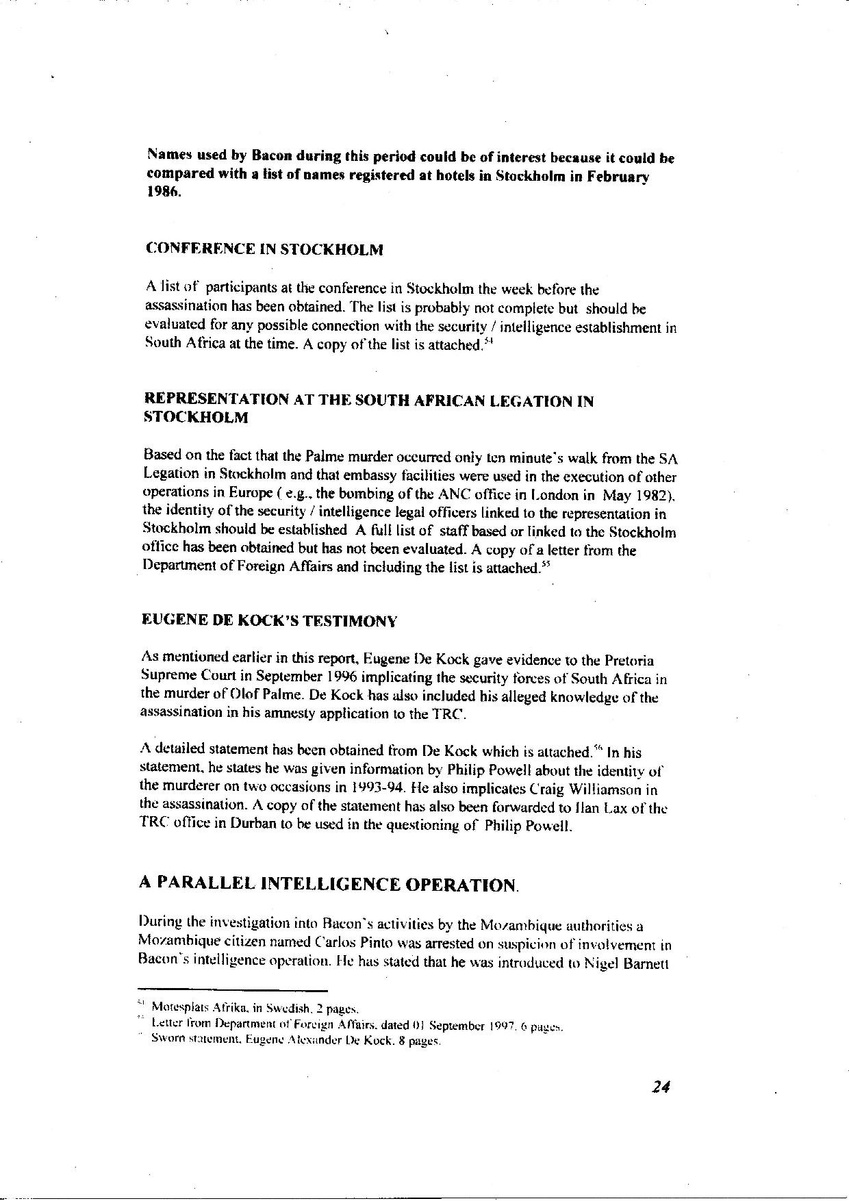
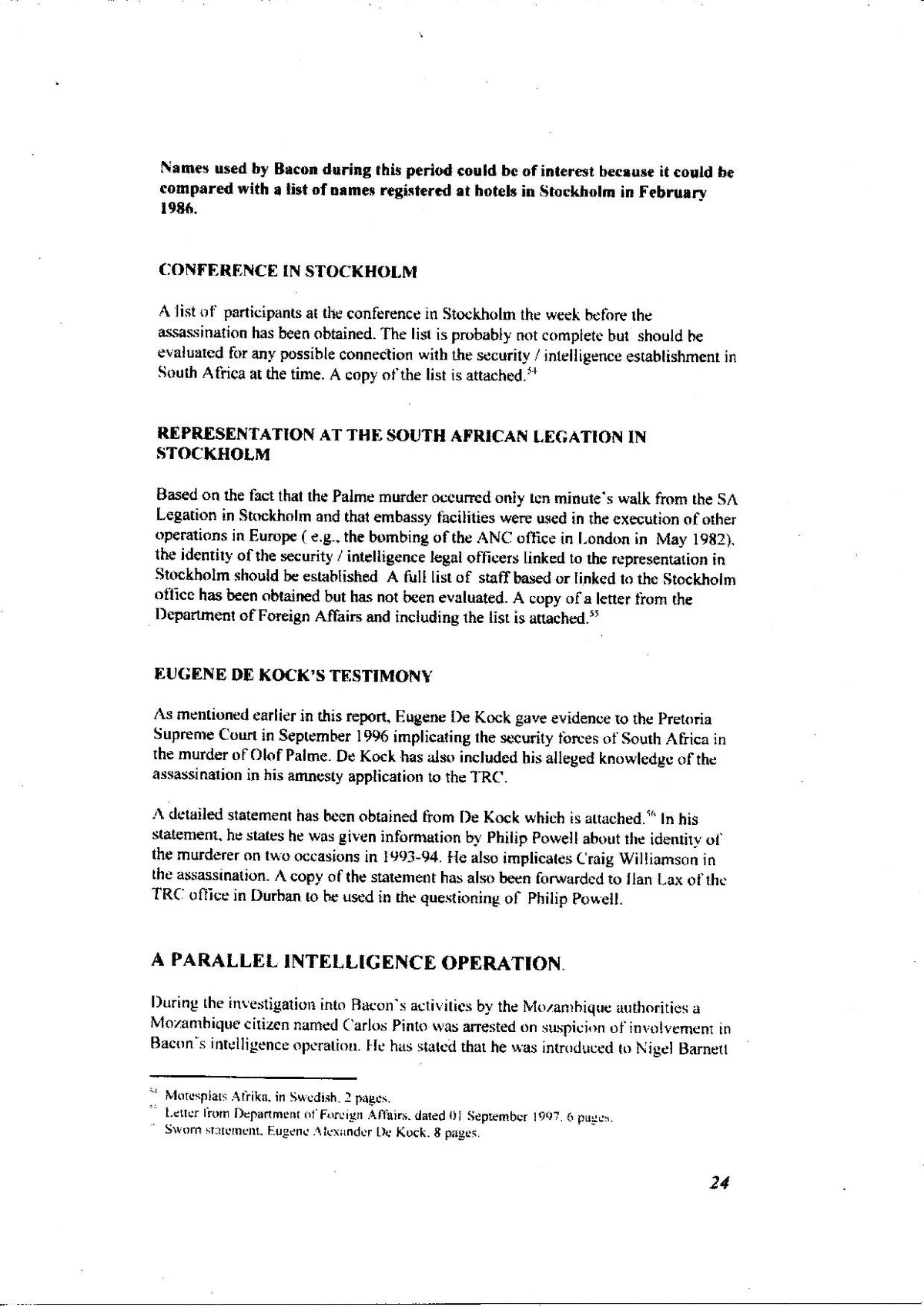
Names used by Bacon during this period could be of interest because it could be compared with a list of names registered at hotels in Stockholm in February 1986.
CONFERENCE IN STOCKHOLM
A list of participants at the conference in Stockholm the week before the assassination has been obtained. The list is probably not complete but should be evaluated for any possible connection with the security / intelligence establishment in South Africa at the time. A copy of the list is attached."
REPRESENTATION AT THE SOUTH AFRICAN LEGATION IN STOCKHOLM
Based on the fact that the Palme murder occurred only ten minute's walk from the SA Legation in Stockholm and that embassy facilities were used in the execution of other operations in Europe ( e.g., the bombing of the ANC office in London in May 1982). the identity of the security / intelligence legal officers linked to the representation in Stockholm should be established A full list of staff based or linked to the Stockholm office has been obtained but has not been evaluated. A copy of a letter from the Department of Foreign Affairs and including the list is attached. **
EUGENE DE KOCK'S TESTIMONY
As mentioned earlier in this report, Eugene De Kock gave evidence to the Pretoria Supreme Court in September 1996 implicating the security forces of South Africa in the murder of Olof Palme. De Kock has also included his alleged knowledge of the assassination in his amnesty application to the TRC.
A detailed statement has been obtained from De Kock which is attached." In his statement, he states he was given information by Philip Powell about the identity of the murderer on two occasions in 1993-94. He also implicates Craig Williamson in the assassination. A copy of the statement has also been forwarded to Ilan Lax of the TRC office in Durban to be used in the questioning of Philip Powell.
A PARALLEL INTELLIGENCE OPERATION.
During the investigation into Bacon's activities by the Mozambique authorities a Mozambique citizen named Carlos Pinto was arrested on suspicion of involvement in Bacon's intelligence operation. He has stated that he was introduced to Nigel Barnett
Motesplats Afrika, in Swedish. 2 pages. Letter from Department of Foreign Affairs, dated 01 September 1997, 0 pages.
6 Sworn statement, Eugene Alexander De Kock. 8 pages.
24
in 1983-84 hy a South African customs representative in Mozambique named Van Staaden. Ile has also admitted that he twice assisted Barnett in getting hold of certain documents related to the harbour in Maputo.
In 1987 Pinto was introduced to Mr. Antonio Pombo, a former South African Military Liaison Officer at the Trade Mission in Maputo, by Van Staaden. Amongst the items found in N. Esslin's safety box, in the Durban Nedbank branch was a handwritten note", dated January 1988. On it is written "R100.00 Mr. Pinto, Mr. Van Stuuden". Mr. H.W. Bacon has not yet been asked about this note but it indicates a connection between Bacon, Pinto and Van Staaden. It is suggested that the role of Van Staaden be further investigated. Bacon has revealed that he was once asked by Pombo to take an envelope to a person at the ANC office in Maputo called Monde. Hedid so and this led to Pinto being offered some work at different ANC houses in Maputo. At this time. Pinto was running his own construction company and he was asked to do some plumbing and general repair and construction work in offices and apartments where ANC people worked or lived.
From this time in 1987, Pinto regularly took envelopes from Mr. Monde to Swaziland where he met Pombo in Mbabane in an office above a restaurant. He has stated that he is not sure of the name of the restaurant but he thinks it was called C'-international (possibly the Continental which was a restaurant in the Swazi Plaza in Mbabane at the time). Most of the time he met Mr. Pombo, but if he was not there, he gave the envelopes to his secretary. According to Pinto, he delivered about one envelope per month during the period 1987-88 for which he was paid R500 per delivery. Normally he also brought an envelope back to Mr. Monde in Maputo from Mr. Pombo.
He has stated that he never opened or in any way tried to access the contents of the envelopes. He did not know what information it contained.
Pinto has stated that he also sometimes brought envelopes to Mr. Pombo from a man at the ANC office called Francis. This man worked as a radio reporter at Radio Mozambique and as far as Mr. Pinto can recall he was also a member of ANC. Pinto believes that Monde and Francis were transferred from Maputo to Lusaka in 1988 or 1989 which was when his work for Pumbo finished.
a
This information has not been followed up or investigated. Of interest is the fact that Bacon's handler mentioned Antonio Pombo in relation to Bacon's operation and that some sort of disturbance occurred in the relationship between Bacon and Pombo. This led to the withdrawal of Pombo from Maputo.
Pinto was released on 25 September 1997, pending further investigation and a decision by the prosecutor.
Handwritten note, January 1988.
25
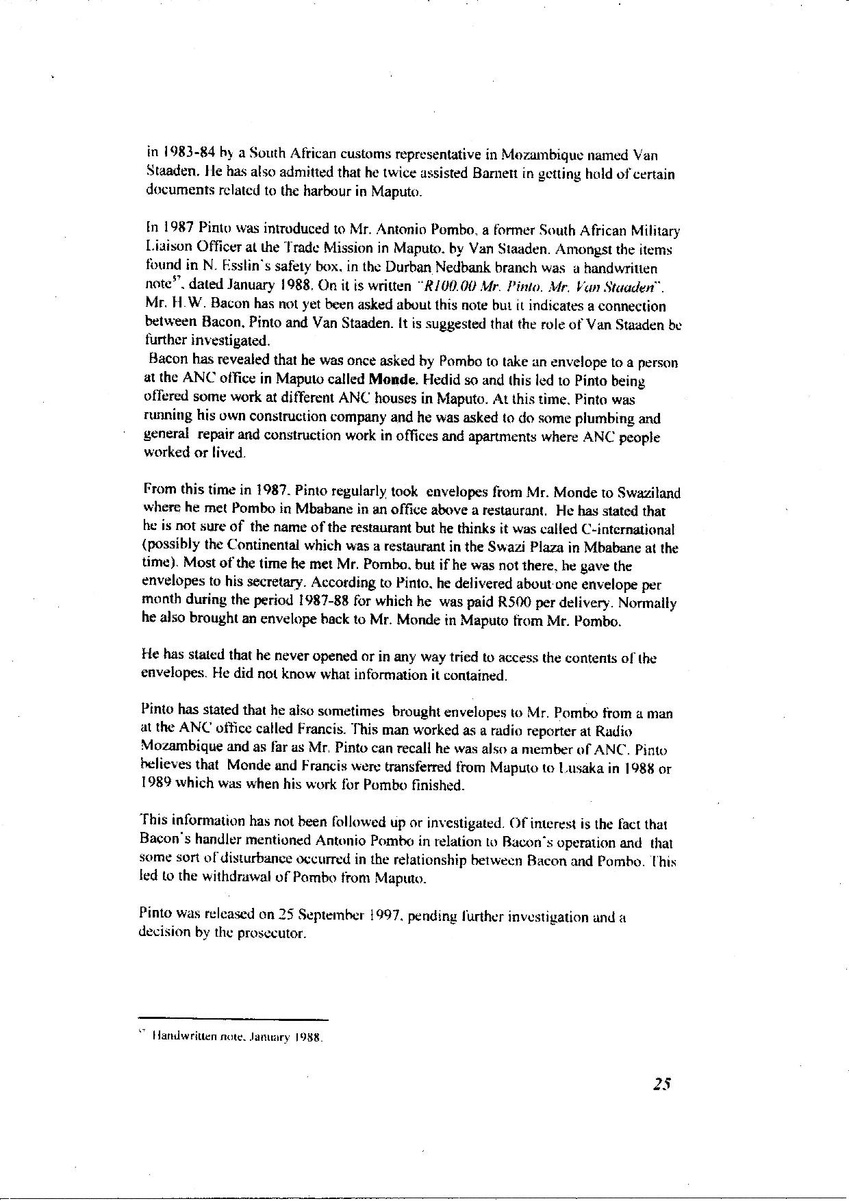
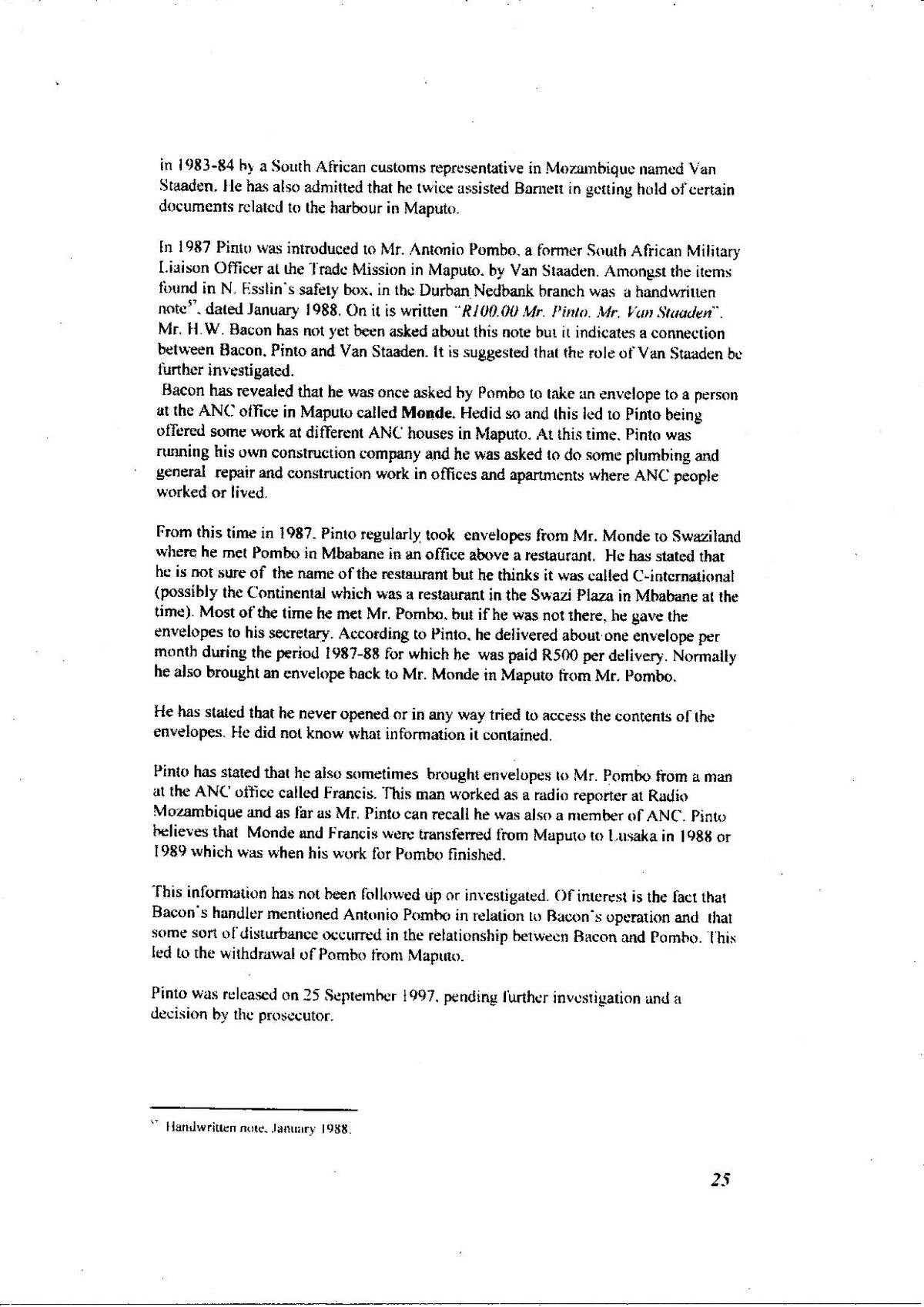
in 1983-84 hy a South African customs representative in Mozambique named Van Staaden. Ile has also admitted that he twice assisted Barnett in getting hold of certain documents related to the harbour in Maputo.
In 1987 Pinto was introduced to Mr. Antonio Pombo, a former South African Military Liaison Officer at the Trade Mission in Maputo, by Van Staaden. Amongst the items found in N. Esslin's safety box, in the Durban Nedbank branch was a handwritten note", dated January 1988. On it is written "R100.00 Mr. Pinto, Mr. Van Stuuden". Mr. H.W. Bacon has not yet been asked about this note but it indicates a connection between Bacon, Pinto and Van Staaden. It is suggested that the role of Van Staaden be further investigated. Bacon has revealed that he was once asked by Pombo to take an envelope to a person at the ANC office in Maputo called Monde. Hedid so and this led to Pinto being offered some work at different ANC houses in Maputo. At this time. Pinto was running his own construction company and he was asked to do some plumbing and general repair and construction work in offices and apartments where ANC people worked or lived.
From this time in 1987, Pinto regularly took envelopes from Mr. Monde to Swaziland where he met Pombo in Mbabane in an office above a restaurant. He has stated that he is not sure of the name of the restaurant but he thinks it was called C'-international (possibly the Continental which was a restaurant in the Swazi Plaza in Mbabane at the time). Most of the time he met Mr. Pombo, but if he was not there, he gave the envelopes to his secretary. According to Pinto, he delivered about one envelope per month during the period 1987-88 for which he was paid R500 per delivery. Normally he also brought an envelope back to Mr. Monde in Maputo from Mr. Pombo.
He has stated that he never opened or in any way tried to access the contents of the envelopes. He did not know what information it contained.
Pinto has stated that he also sometimes brought envelopes to Mr. Pombo from a man at the ANC office called Francis. This man worked as a radio reporter at Radio Mozambique and as far as Mr. Pinto can recall he was also a member of ANC. Pinto believes that Monde and Francis were transferred from Maputo to Lusaka in 1988 or 1989 which was when his work for Pumbo finished.
a
This information has not been followed up or investigated. Of interest is the fact that Bacon's handler mentioned Antonio Pombo in relation to Bacon's operation and that some sort of disturbance occurred in the relationship between Bacon and Pombo. This led to the withdrawal of Pombo from Maputo.
Pinto was released on 25 September 1997, pending further investigation and a decision by the prosecutor.
Handwritten note, January 1988.
25
CONCLUSION
Since the TRC's mandate is relatively limited, this investigation has focused on three main issues:
1. Bacon's intelligence operation targeted on the ANC representation in Maputo. 2. Pinto's operation directed toward the ANC representation in Maputo. 3. The alleged link to the assassination of the Swedish Prime Minister.
Bacon has tried to play down his role as an intelligence operator but the evidence contradicts this. The whole operation contains all the hallmarks of an advanced intelligence operation. The following facts are pertinent:
1. A false identity was created, including the supply of a false passport. 2. He was given intelligence training. 3. He was employed by a “front company”. 4. He was sent overseas to be able to verify his “legend”. 5. His “legend" was confirmed by his "front company”. 6. Handlers were appointed to him. 7. One or several "safe houses were used to debrief him. 8. He had alternative identities to be used for travel arrangements. 9. He cut off his links with his family. 10. There are strong indications that he received instructions via radio in a manner
that is internationally recognized as a modus operandi for intelligence agents. 11. At a later stage of his operation, he used a computerized e-mail system for
communication. 12. The fact that he was based in Maputo from at least 1984 to 1994, and even more
importantly that he was kept there after 1994 indicates that he or his operation
must have been considered to be of great importance. 13. The role of Gold Star Shipping is of special interest since it could also implicate a
third country in the operation.
It is my contention that Bacon's intelligence-gathering operation falls within the mandate of the TRC given that his intelligence would have fed into the planning of cross-border operations in Mozambique in which both ANC members and Mozambican citizens were killed or injured. The amnesty application of Henri van der Westhuizen gives details of target intelligence gathering in Mozambique undertaken by DCC. As an agent-in-place, Bacon must have been a key link in the collection chain which resulted in at least two operations in Maputo - a 1988 attack on four ANO targets in which the wrong houses were hit and two Mozambicans were killed, and the attempted assassination of Albie Sachs. It is also known that the planning of an attack on an ANC transit facility in Maputo in DEC 86 or Jan 87 was aborted at the last minute as was the planned murder of Robert Davies. detailed dossiers on these two operations would have been developed. There is thus a prima facie case against Bacon of involvement in gross human rights violations.
-
H.W. Bacon has not applied for amnesty:
26
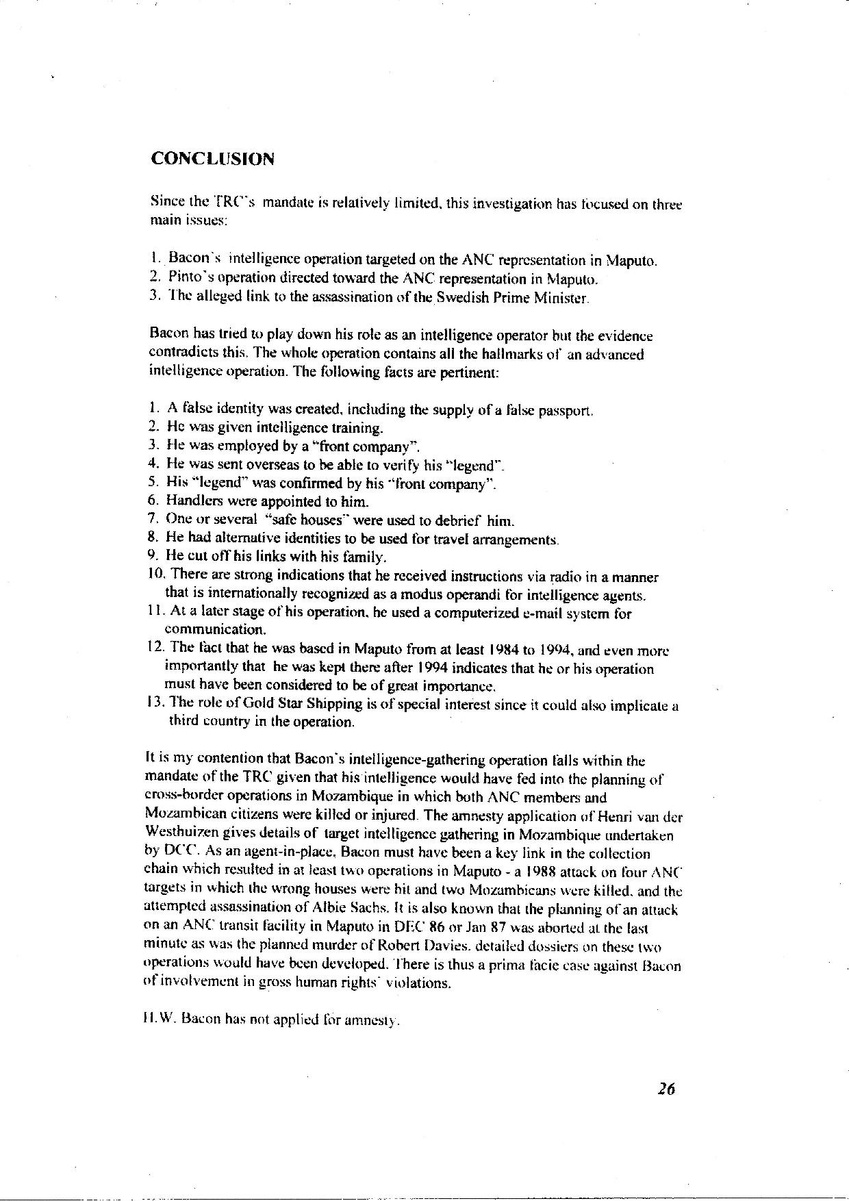
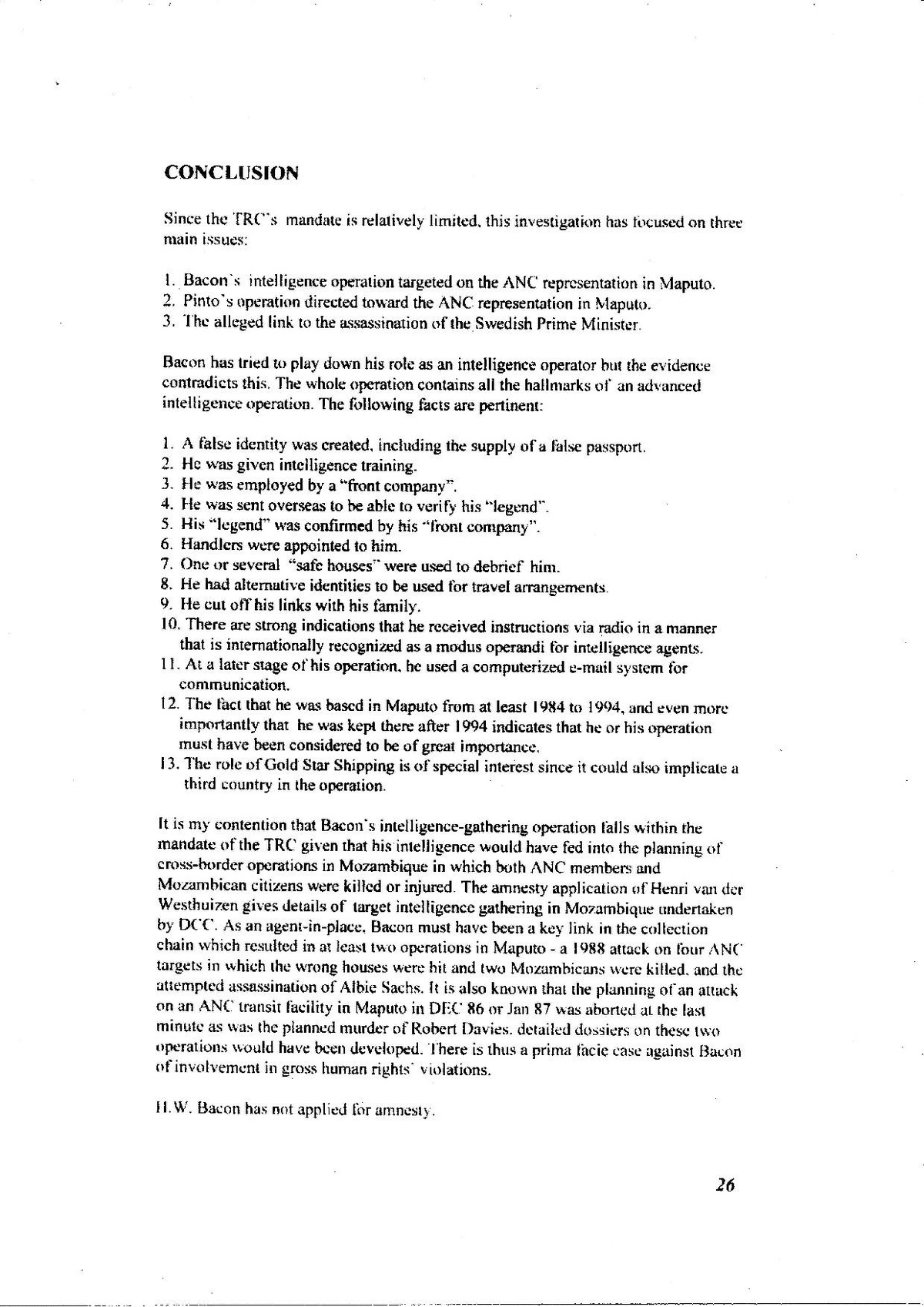
CONCLUSION
Since the TRC's mandate is relatively limited, this investigation has focused on three main issues:
1. Bacon's intelligence operation targeted on the ANC representation in Maputo. 2. Pinto's operation directed toward the ANC representation in Maputo. 3. The alleged link to the assassination of the Swedish Prime Minister.
Bacon has tried to play down his role as an intelligence operator but the evidence contradicts this. The whole operation contains all the hallmarks of an advanced intelligence operation. The following facts are pertinent:
1. A false identity was created, including the supply of a false passport. 2. He was given intelligence training. 3. He was employed by a “front company”. 4. He was sent overseas to be able to verify his “legend”. 5. His “legend" was confirmed by his "front company”. 6. Handlers were appointed to him. 7. One or several "safe houses were used to debrief him. 8. He had alternative identities to be used for travel arrangements. 9. He cut off his links with his family. 10. There are strong indications that he received instructions via radio in a manner
that is internationally recognized as a modus operandi for intelligence agents. 11. At a later stage of his operation, he used a computerized e-mail system for
communication. 12. The fact that he was based in Maputo from at least 1984 to 1994, and even more
importantly that he was kept there after 1994 indicates that he or his operation
must have been considered to be of great importance. 13. The role of Gold Star Shipping is of special interest since it could also implicate a
third country in the operation.
It is my contention that Bacon's intelligence-gathering operation falls within the mandate of the TRC given that his intelligence would have fed into the planning of cross-border operations in Mozambique in which both ANC members and Mozambican citizens were killed or injured. The amnesty application of Henri van der Westhuizen gives details of target intelligence gathering in Mozambique undertaken by DCC. As an agent-in-place, Bacon must have been a key link in the collection chain which resulted in at least two operations in Maputo - a 1988 attack on four ANO targets in which the wrong houses were hit and two Mozambicans were killed, and the attempted assassination of Albie Sachs. It is also known that the planning of an attack on an ANC transit facility in Maputo in DEC 86 or Jan 87 was aborted at the last minute as was the planned murder of Robert Davies. detailed dossiers on these two operations would have been developed. There is thus a prima facie case against Bacon of involvement in gross human rights violations.
-
H.W. Bacon has not applied for amnesty:
26
As has been mentioned earlier in this report. the fact that this operation continued up to 1997 is a significant factor. I am, however, not the right person to make any evaluation of the implications for the South African Government of the fact that an intelligence structure in this country continued to use an apartheid-era operator in Mozambique in the post-94 period.
The investigation also indicates that there was a parallel intelligence operation during 1987 - 1988 involving ANC personnel based in Maputo as “informers". This is a matter that has not been further investigated. If necessary, the two persons who have been mentioned could probably easily be identified.
The investigation into a possible link into the assassination of the Swedish Prime Minister has been extremely difficult and time-consuming. To make any further progress, further investigation of the DCC needs to be undertaken should be approached. Furthermore it is suggested that the Truth & Reconciliation Commission should claim access to all files within the Defence Force related to this issue. There are a number of circumstances that have been established during this part of the investigation which render Bacon a suspect. They are:
1. He failed the polygraph examination on questions related to the murder. 2. He has not been able to give an adequate explanation for possession of the tape
from Swedish radio. There are even strong indications that he lied about it. 3. He failed to give correct details about his visits to Sweden. The times given by him
for his visits proved to be incorrect. The circumstances for his visits to Sweden
have also been proved to be very odd. 4. He has proved to be very familiar with Stockholm, which indicates that he went
there frequently 5. He has travelled to Sweden under false identity. 6. He was in possession of the same type of weapon that was used for the
assassination, which at least establishes that he is familiar with this specific type of
weapon, although it has been proved that his weapon was not used for the murder. 7. One of his handlers has stated that Bacon was in possession of a Swedish passport. 8. He has stated that he visited Sweden when it was cold and there was snow without
being able to specify the occasion. 9. His attempts to cover up his relationship with Anthony White are suspicious given
the fact that other sources have implicated White in the murder.
The aim in this part of the investigation has been to establish if H.W. Bacon was involved in, or has any knowledge of the assassination. It is suggested that the results of this investigation should be forwarded to the Attorney General's office for further investigation
PROPOSALS FOR FURTHER INVESTIGATION
1. Issue a subpoena in terms of Section 29 ("the Act”) on At Nel to he questioned
about the whole "Bacon operation".
27
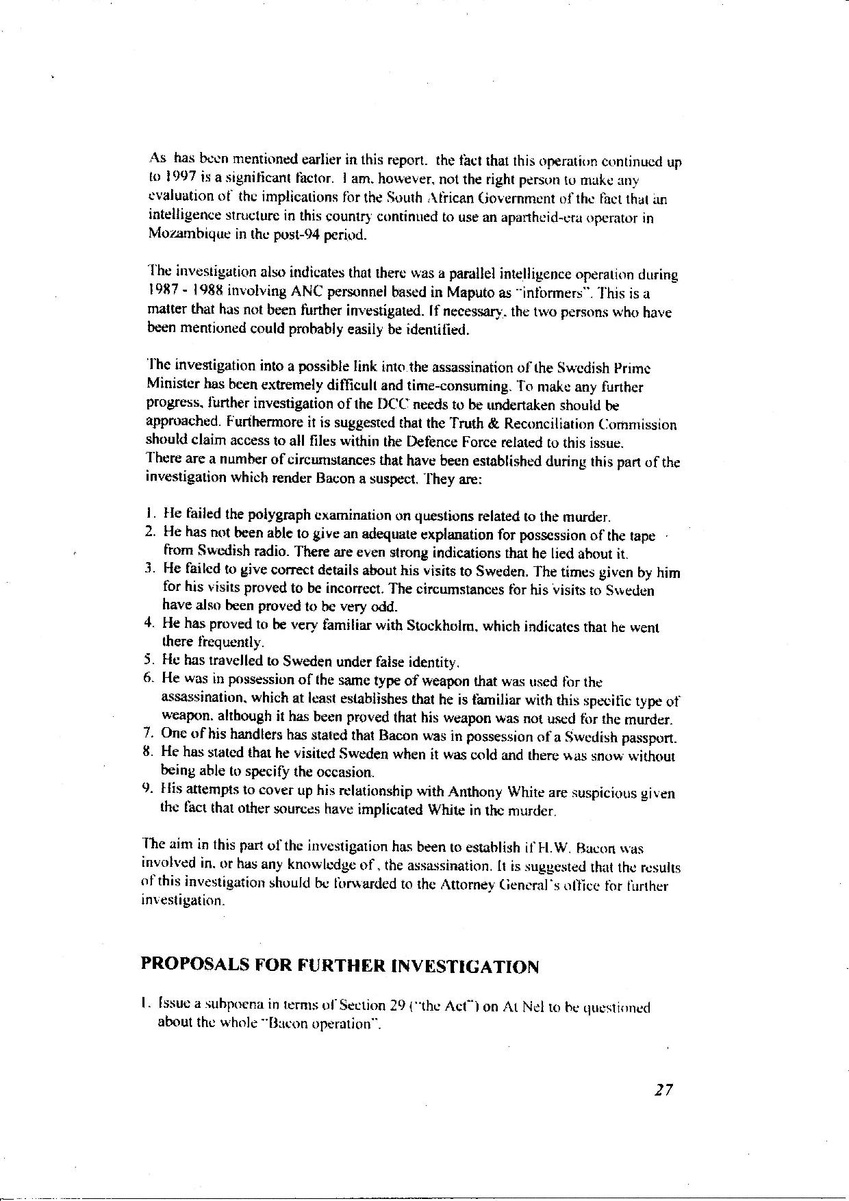
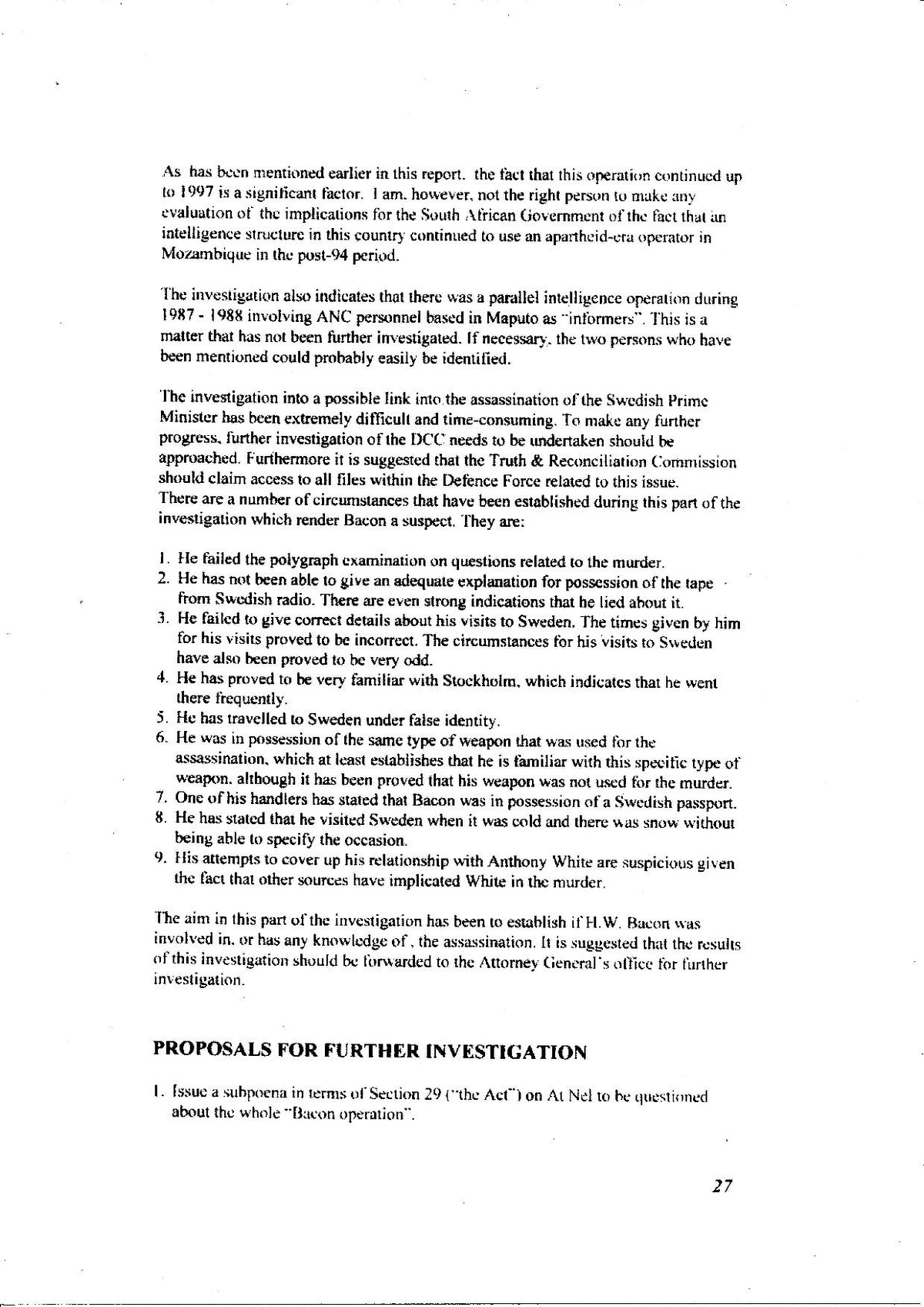
As has been mentioned earlier in this report. the fact that this operation continued up to 1997 is a significant factor. I am, however, not the right person to make any evaluation of the implications for the South African Government of the fact that an intelligence structure in this country continued to use an apartheid-era operator in Mozambique in the post-94 period.
The investigation also indicates that there was a parallel intelligence operation during 1987 - 1988 involving ANC personnel based in Maputo as “informers". This is a matter that has not been further investigated. If necessary, the two persons who have been mentioned could probably easily be identified.
The investigation into a possible link into the assassination of the Swedish Prime Minister has been extremely difficult and time-consuming. To make any further progress, further investigation of the DCC needs to be undertaken should be approached. Furthermore it is suggested that the Truth & Reconciliation Commission should claim access to all files within the Defence Force related to this issue. There are a number of circumstances that have been established during this part of the investigation which render Bacon a suspect. They are:
1. He failed the polygraph examination on questions related to the murder. 2. He has not been able to give an adequate explanation for possession of the tape
from Swedish radio. There are even strong indications that he lied about it. 3. He failed to give correct details about his visits to Sweden. The times given by him
for his visits proved to be incorrect. The circumstances for his visits to Sweden
have also been proved to be very odd. 4. He has proved to be very familiar with Stockholm, which indicates that he went
there frequently 5. He has travelled to Sweden under false identity. 6. He was in possession of the same type of weapon that was used for the
assassination, which at least establishes that he is familiar with this specific type of
weapon, although it has been proved that his weapon was not used for the murder. 7. One of his handlers has stated that Bacon was in possession of a Swedish passport. 8. He has stated that he visited Sweden when it was cold and there was snow without
being able to specify the occasion. 9. His attempts to cover up his relationship with Anthony White are suspicious given
the fact that other sources have implicated White in the murder.
The aim in this part of the investigation has been to establish if H.W. Bacon was involved in, or has any knowledge of the assassination. It is suggested that the results of this investigation should be forwarded to the Attorney General's office for further investigation
PROPOSALS FOR FURTHER INVESTIGATION
1. Issue a subpoena in terms of Section 29 ("the Act”) on At Nel to he questioned
about the whole "Bacon operation".
27
Truth & Reconciliation Commission Investigative Unit Jan-Ake Kjellberg
28 April 1998
A SUMMARY OF THE INVESTIGATION RELATING TO THE ARREST OF A SOUTH AFRICAN CITIZEN IN MAPUTO, MOZAMBIQUE
INTRODUCTION
On 23 March 1997, a South African citizen was arrested in Maputo, Mozambique. The initial reason for his arrest was his alleged involvement in a reported attempted arson. The investigation very soon developed into suspicions that the arrested man had been involved in an intelligence operation in Mozambique on behalf of South African Military Intelligence. There were also, at an early stage, indications that his activities might be linked to the assassination of the Swedish Prime Minister Olof Palme in Stockholm on 28 February 1986.
The individual in question was born Leon van der Westhuizen but his name was changed at adoption to Henry William Bacon. In 1982, his name was changed legally to Nicho Esslin but the name under which he operated in Mozambique was Nigel Barnett.
INTELLIGENCE
According to information obtained in Maputo, Barnett had been operating in Mozambique as an agent for South African Military Intelligence from 1984 until his arrest in March 1997. In a statement to thư Mozambican police. hc revealed that he had been recruited by Colonel At Nel of the Directorate of Covert Collection in January 1983. He was first placed in a "front company“ in Durban called Lesotho Mountain Carriers, which was in turn, owned by another front company" called Polaris Shipping. Later during 1983, he was supplied with a false passport by ('olonc! At Nel in the name of Nigel Barnell, and with ID NO: 5006305202006.
1
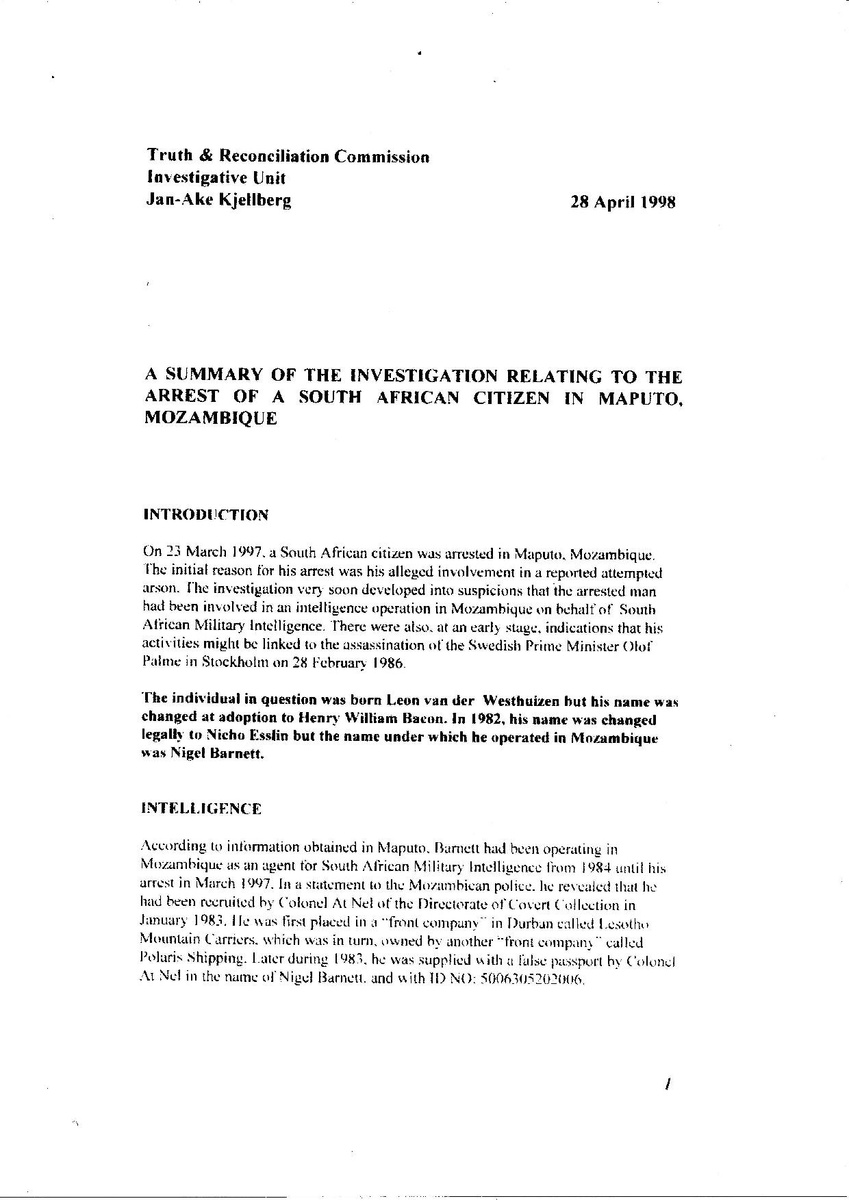
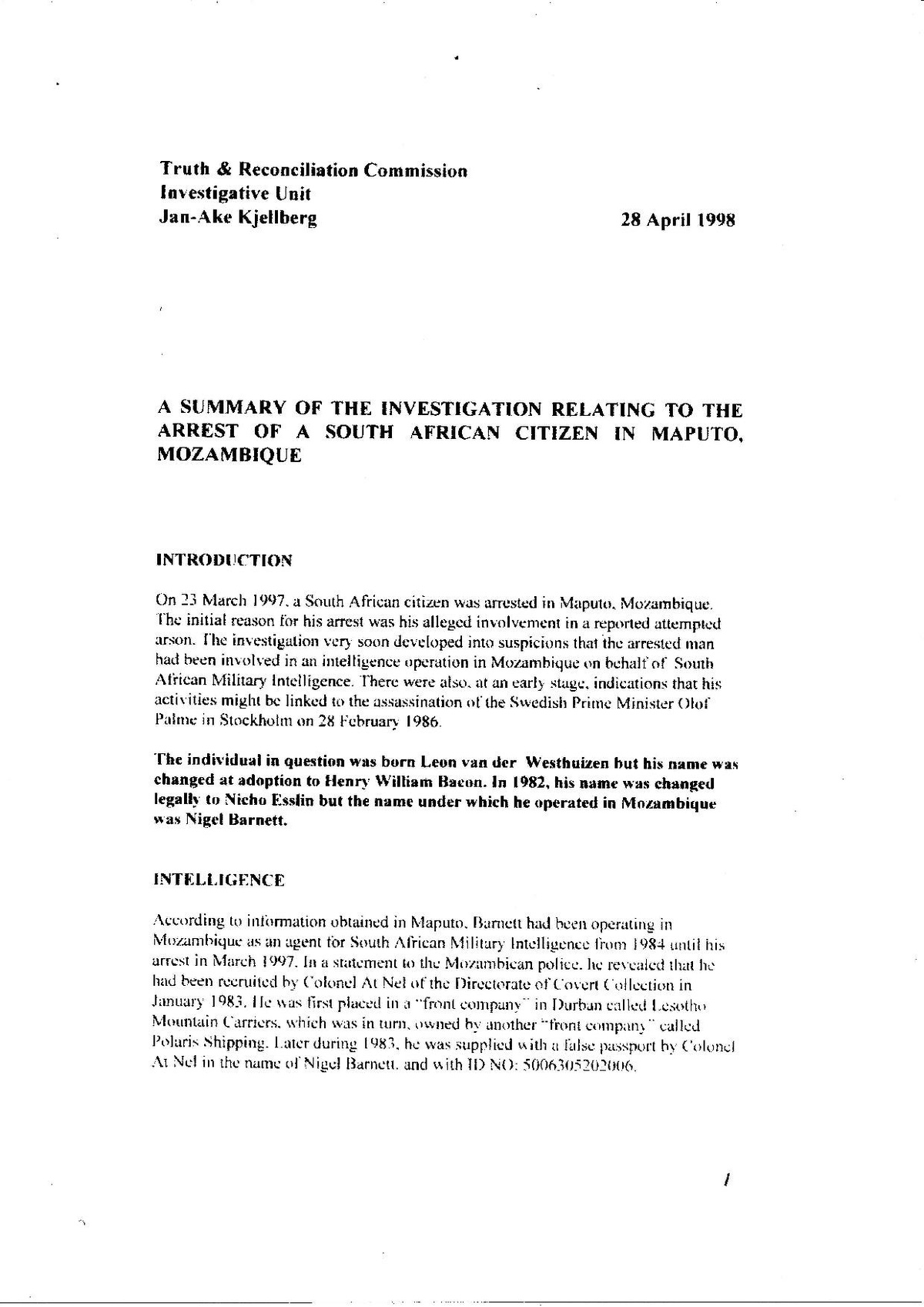
Truth & Reconciliation Commission Investigative Unit Jan-Ake Kjellberg
28 April 1998
A SUMMARY OF THE INVESTIGATION RELATING TO THE ARREST OF A SOUTH AFRICAN CITIZEN IN MAPUTO, MOZAMBIQUE
INTRODUCTION
On 23 March 1997, a South African citizen was arrested in Maputo, Mozambique. The initial reason for his arrest was his alleged involvement in a reported attempted arson. The investigation very soon developed into suspicions that the arrested man had been involved in an intelligence operation in Mozambique on behalf of South African Military Intelligence. There were also, at an early stage, indications that his activities might be linked to the assassination of the Swedish Prime Minister Olof Palme in Stockholm on 28 February 1986.
The individual in question was born Leon van der Westhuizen but his name was changed at adoption to Henry William Bacon. In 1982, his name was changed legally to Nicho Esslin but the name under which he operated in Mozambique was Nigel Barnett.
INTELLIGENCE
According to information obtained in Maputo, Barnett had been operating in Mozambique as an agent for South African Military Intelligence from 1984 until his arrest in March 1997. In a statement to thư Mozambican police. hc revealed that he had been recruited by Colonel At Nel of the Directorate of Covert Collection in January 1983. He was first placed in a "front company“ in Durban called Lesotho Mountain Carriers, which was in turn, owned by another front company" called Polaris Shipping. Later during 1983, he was supplied with a false passport by ('olonc! At Nel in the name of Nigel Barnell, and with ID NO: 5006305202006.
1
Issue a subpoena in terms of Section 29 ("the Act“) on H.W. Doncaster to be
questioned on his role in the "Bacon operation". 3. Issue a subpoena in terms of Section 29 (“the Act") on Charles Richards to be
questioned on his role in the "Bacon operation". 4. Issue a subpoena in terms of Section 29(b) ("the Act”) on the Head of the Defence
Force to produce all documentation, inclusive of Bacon's personal file, related to
Bacon's and Pinto's intelligence operations. 5. Issue a subpoena in terms of Section 29(b) ("the Act") on the Standard Bank to
produce documentation on all transactions related to Bacon. 6. Issue a subpoena in terms of Section 29(b) (“the Act”) on Van Staaden to be
questioned on his role in the “Pinto operation". 7. Issue a subpoena in terms of Section 29(b) ("the Acta) on the ANC to produce
documentation on personnel based at the ANC office in Maputo. 8. Issue a subpoena in terms of Section 29(b) ("the Act") on the Department of Home
Affairs to produce all documentation related to the issue of false passports, specifically for Bacon. At Nel, Anthony White and Doncaster.
Jan-Ake Kjellberg.
28
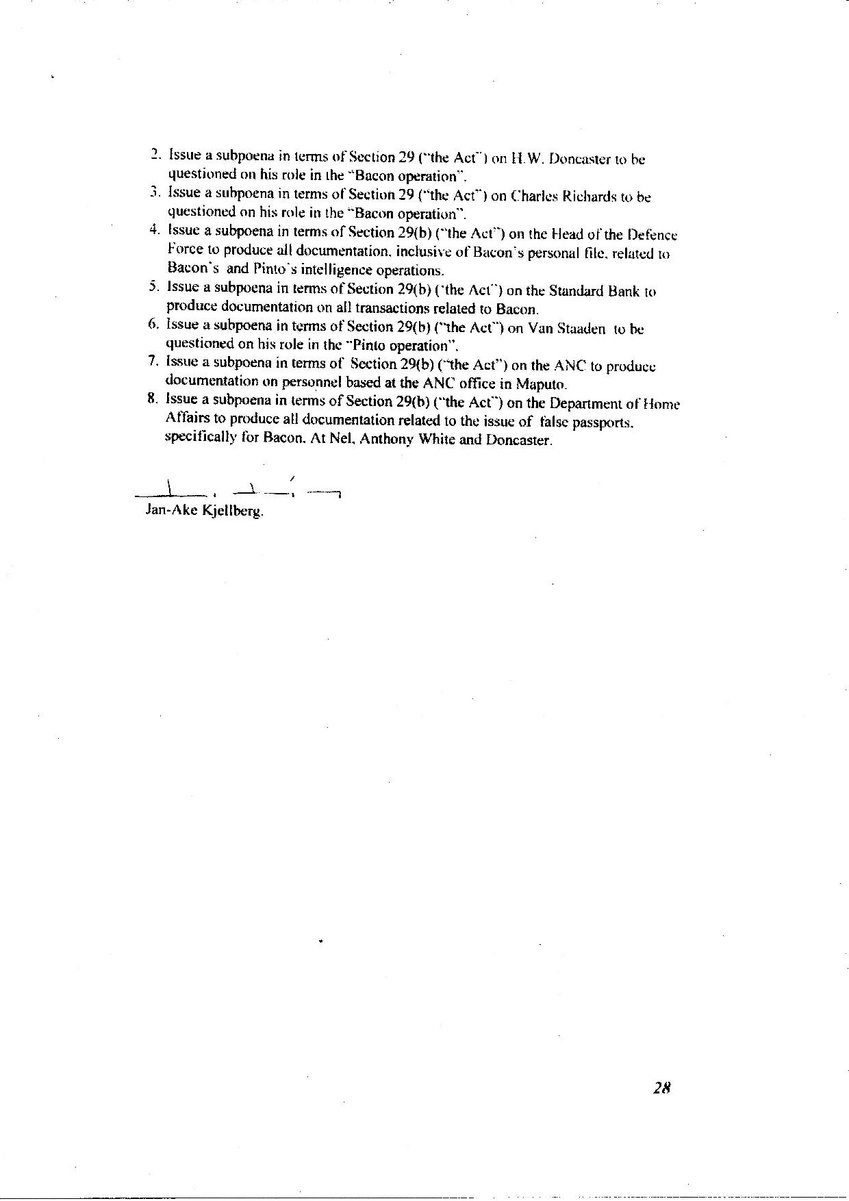
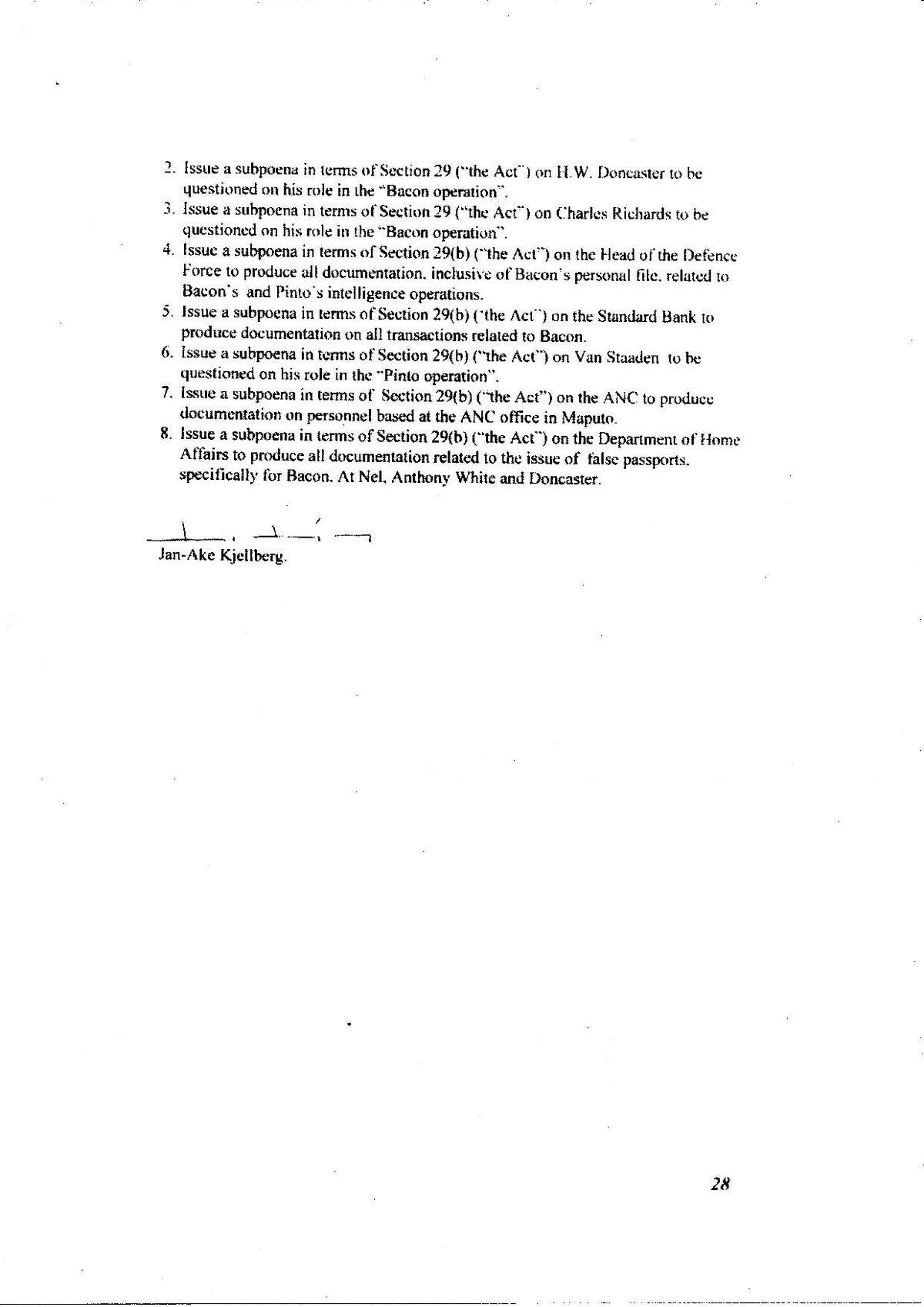
Issue a subpoena in terms of Section 29 ("the Act“) on H.W. Doncaster to be
questioned on his role in the "Bacon operation". 3. Issue a subpoena in terms of Section 29 (“the Act") on Charles Richards to be
questioned on his role in the "Bacon operation". 4. Issue a subpoena in terms of Section 29(b) ("the Act”) on the Head of the Defence
Force to produce all documentation, inclusive of Bacon's personal file, related to
Bacon's and Pinto's intelligence operations. 5. Issue a subpoena in terms of Section 29(b) ("the Act") on the Standard Bank to
produce documentation on all transactions related to Bacon. 6. Issue a subpoena in terms of Section 29(b) (“the Act”) on Van Staaden to be
questioned on his role in the “Pinto operation". 7. Issue a subpoena in terms of Section 29(b) ("the Acta) on the ANC to produce
documentation on personnel based at the ANC office in Maputo. 8. Issue a subpoena in terms of Section 29(b) ("the Act") on the Department of Home
Affairs to produce all documentation related to the issue of false passports, specifically for Bacon. At Nel, Anthony White and Doncaster.
Jan-Ake Kjellberg.
28
Early in 1984 he was told hy Colonel At Nel that Polaris Shipping needed a representative in Maputo. Later that year he was placed in that post and started his intelligence operation for the DCC.
He has stated that his main handler up to 1994 was Colonel At Nel and thereafter until his arrest in March 1997. Horace Doncaster. The latter was at this point the Director of the DCC and is perhaps indicative of the importance of Barnett as a source and operative. He has also named the co-handlers during the period 1984-1994. He has explained that Nel and Doncaster were his handlers on an operational level while the co-handlers were his administrative handlers.
He has described his tasks as an intelligence gatherer by dividing them in two main time periods:
1984-86/87: Collected data on the serviceability of Maputo llarhour. c.g. how many cranes and forklifts in working condition, etc.?
1987- 92/93: Collecting data on ANC' personnel, supporters, transit houses and foreign visitors, i.e., target identification. In general, this operation was aimed at monitoring the activities of the ANC representation in Maputo.
His tasks in the 1993-97 period is unclear. However, a copy of a report' dated 11/02/97 was secured during the investigation which clearly shows that - and Barnell has confessed as much - that his intelligence activities continued after the clections in South Africa in 1994. Furthermore, another report dated 11/12/1995 which, apart from the fact that it support the evidence that he was active at this time, also indicates that Barnett had a very good "source" within the civilian intelligence agency (SISE) in Mozambique.
In short, this investigation has established that South African Military Intelligence continued to run an operation in Mozambique after the democratic elections in South Africa 1994, using at least some of the apartheid-era agentsin-place, such as Barnett.
OLOF PALME
The investigation into Barnett's possible links with the murder of the Swedish PM was initiated by the fact that a tape recording was found in his possession of an international radio-broadcast by Radio-Sweden in which details from the Swedish investigation into the murder were revealed. Furthermore, it was established that the suspect had a family connection with Sweden. Ile was adopted as it young child by a South African father and Swedish mother. There was also information available that he had visited Sweden a number of times. A search of his apartment uncovered letters
To: N. is copy of report found on a computer disk in Barnett's apartment. A report dated 11/12.1995. directings all".
2
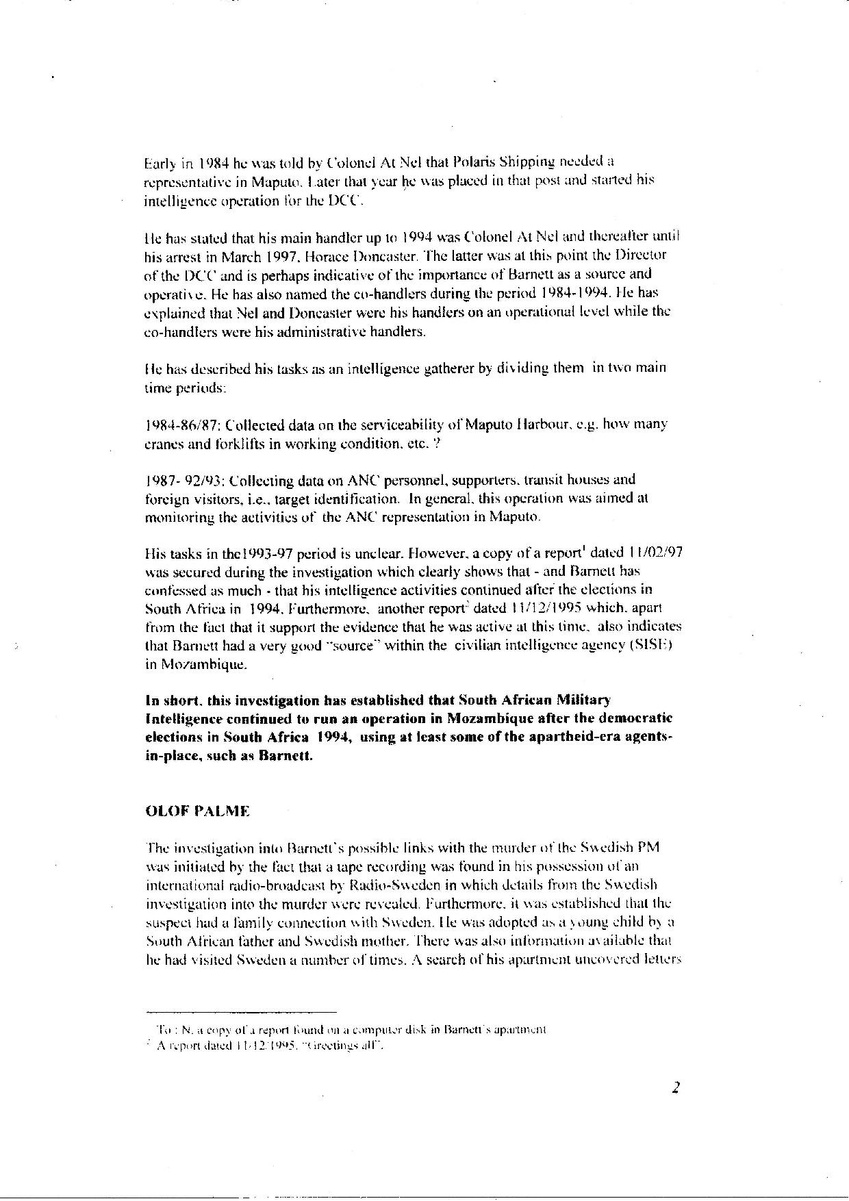
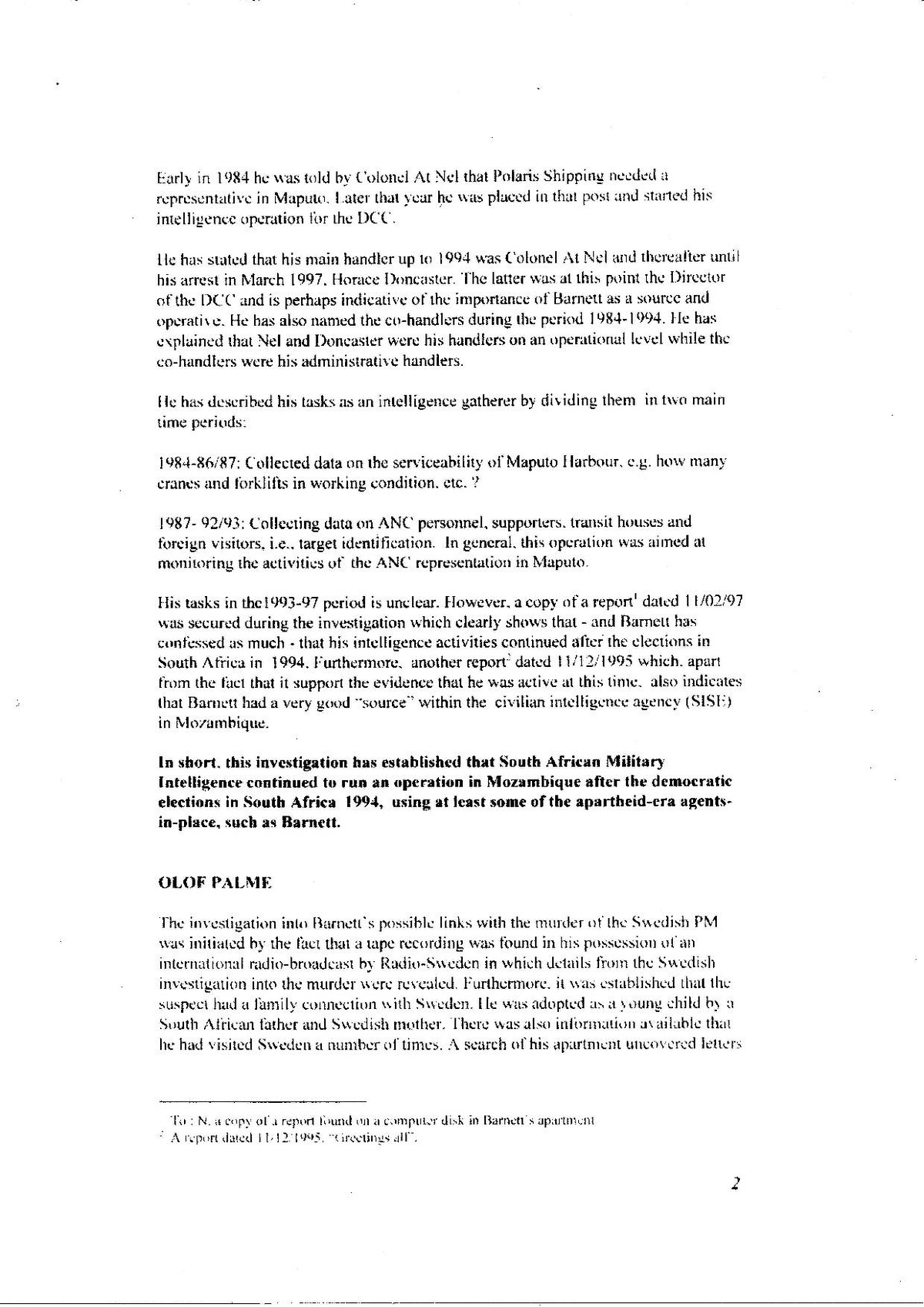
Early in 1984 he was told hy Colonel At Nel that Polaris Shipping needed a representative in Maputo. Later that year he was placed in that post and started his intelligence operation for the DCC.
He has stated that his main handler up to 1994 was Colonel At Nel and thereafter until his arrest in March 1997. Horace Doncaster. The latter was at this point the Director of the DCC and is perhaps indicative of the importance of Barnett as a source and operative. He has also named the co-handlers during the period 1984-1994. He has explained that Nel and Doncaster were his handlers on an operational level while the co-handlers were his administrative handlers.
He has described his tasks as an intelligence gatherer by dividing them in two main time periods:
1984-86/87: Collected data on the serviceability of Maputo llarhour. c.g. how many cranes and forklifts in working condition, etc.?
1987- 92/93: Collecting data on ANC' personnel, supporters, transit houses and foreign visitors, i.e., target identification. In general, this operation was aimed at monitoring the activities of the ANC representation in Maputo.
His tasks in the 1993-97 period is unclear. However, a copy of a report' dated 11/02/97 was secured during the investigation which clearly shows that - and Barnell has confessed as much - that his intelligence activities continued after the clections in South Africa in 1994. Furthermore, another report dated 11/12/1995 which, apart from the fact that it support the evidence that he was active at this time, also indicates that Barnett had a very good "source" within the civilian intelligence agency (SISE) in Mozambique.
In short, this investigation has established that South African Military Intelligence continued to run an operation in Mozambique after the democratic elections in South Africa 1994, using at least some of the apartheid-era agentsin-place, such as Barnett.
OLOF PALME
The investigation into Barnett's possible links with the murder of the Swedish PM was initiated by the fact that a tape recording was found in his possession of an international radio-broadcast by Radio-Sweden in which details from the Swedish investigation into the murder were revealed. Furthermore, it was established that the suspect had a family connection with Sweden. Ile was adopted as it young child by a South African father and Swedish mother. There was also information available that he had visited Sweden a number of times. A search of his apartment uncovered letters
To: N. is copy of report found on a computer disk in Barnett's apartment. A report dated 11/12.1995. directings all".
2
and books, written in Swedish. which clearly indicated that Barnett had a good grasp of the Swedish language.
It was also established that Barnett had licences for four different weapons, one of which was identical to the type of weapon - a Smith and Wesson 357, Magnum revolver - that was used in the assassination of Olof Palme.
A fourth factor was that Eugene De Kock in his testimony before the Supreme Court in Pretoria in September 1996 had alleged that he had information implicating the DCC in the murder and other sources mentioned Anthony White, another DCC operative. as involved in the operation. This was of importance since there was information available of a link between the suspect and Anthony White.
Fifthly. it was established that the suspect was in possession of at least three different South African passports and later information was obtained indicating that he could have been in possession of Swedish and British passports as well.
Finally, some significance was attached to the fact that an international conference was held in Stockholm the week before the murder, at which the ANC had strong representation. Olof Palme gave a speech during the conference that was in large part directed against the apartheid government in South Africa and in favour of the ANC. It has been suggested that this conference marked a significant departure for both Olof Palme and the Swedish government by signaling their official diplomatic view of the ANC as the legitimate representative for the majority of the South African people.
A PARALLEL INTELLIGENCE OPERATION
During the investigation into the suspect's links to the Palme case, another parallel intelligence operation was uncovered. Also run by South African Military Intelligence, this operation was aimed at the ANC presence in Maputo.
INVESTIGATION
During April 1997, I received information about the Maputo arrest from various sources in South Africa. Contacts with the National Criminal Investigation Department in Sweden revealed that there was an interest from the "Palmo Investigation Team“ to probe the activities of the arrested person in Maputo. Arrangements were made through the Swedish Embassy in Maputo with the Criminal Investigation Department in Mozambique for permission for a Swedish investigator 10 meet with the authorities in Maputo. It was at the same time requested that I should. as a representative of the Swedish National Criminal Investigation Department (SNCID), try to establish contact with the investigators in Maputo.
a
On 22 April 1997. I contacted the national head of the TRC`s Investigative Unit. Advocate Glenn Goosen, and requested that arrangements be made for me to travel to Mozambique in order to investigate the background to the arrest. A copy oraluller 10
}
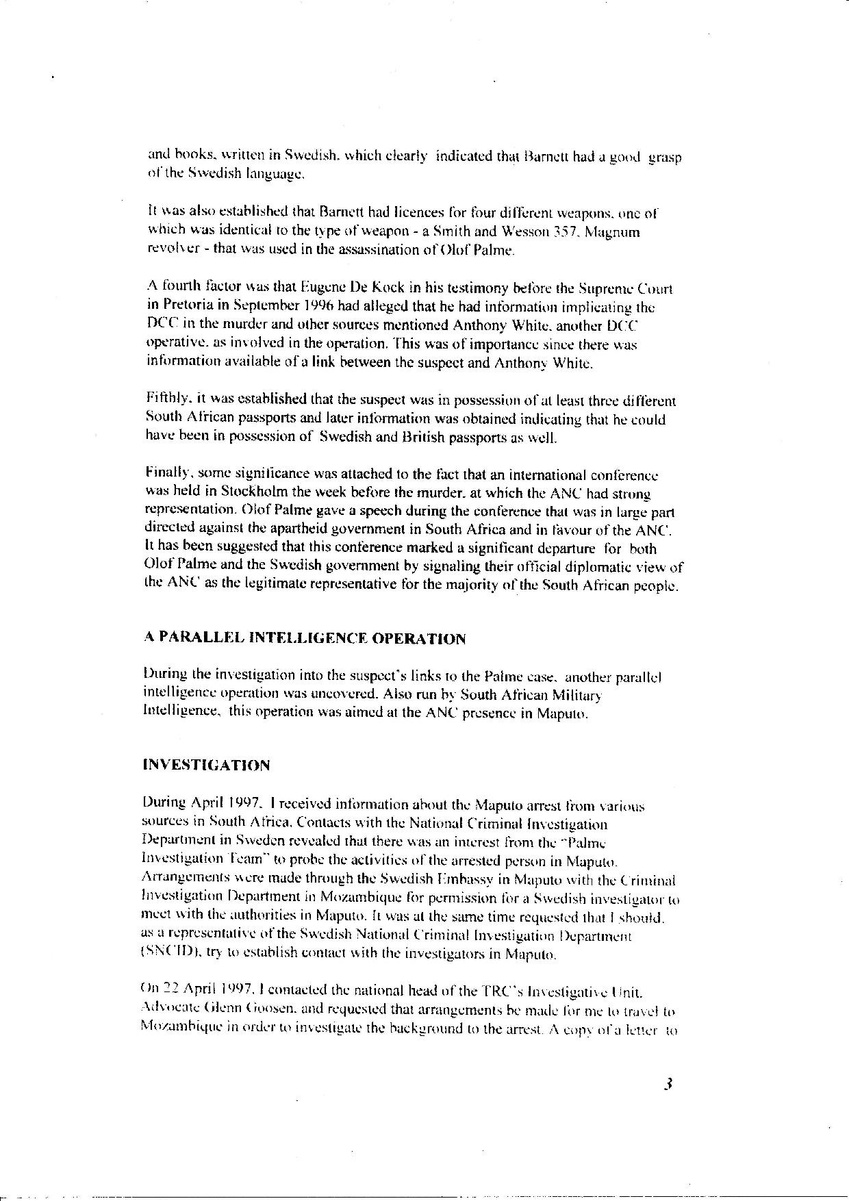
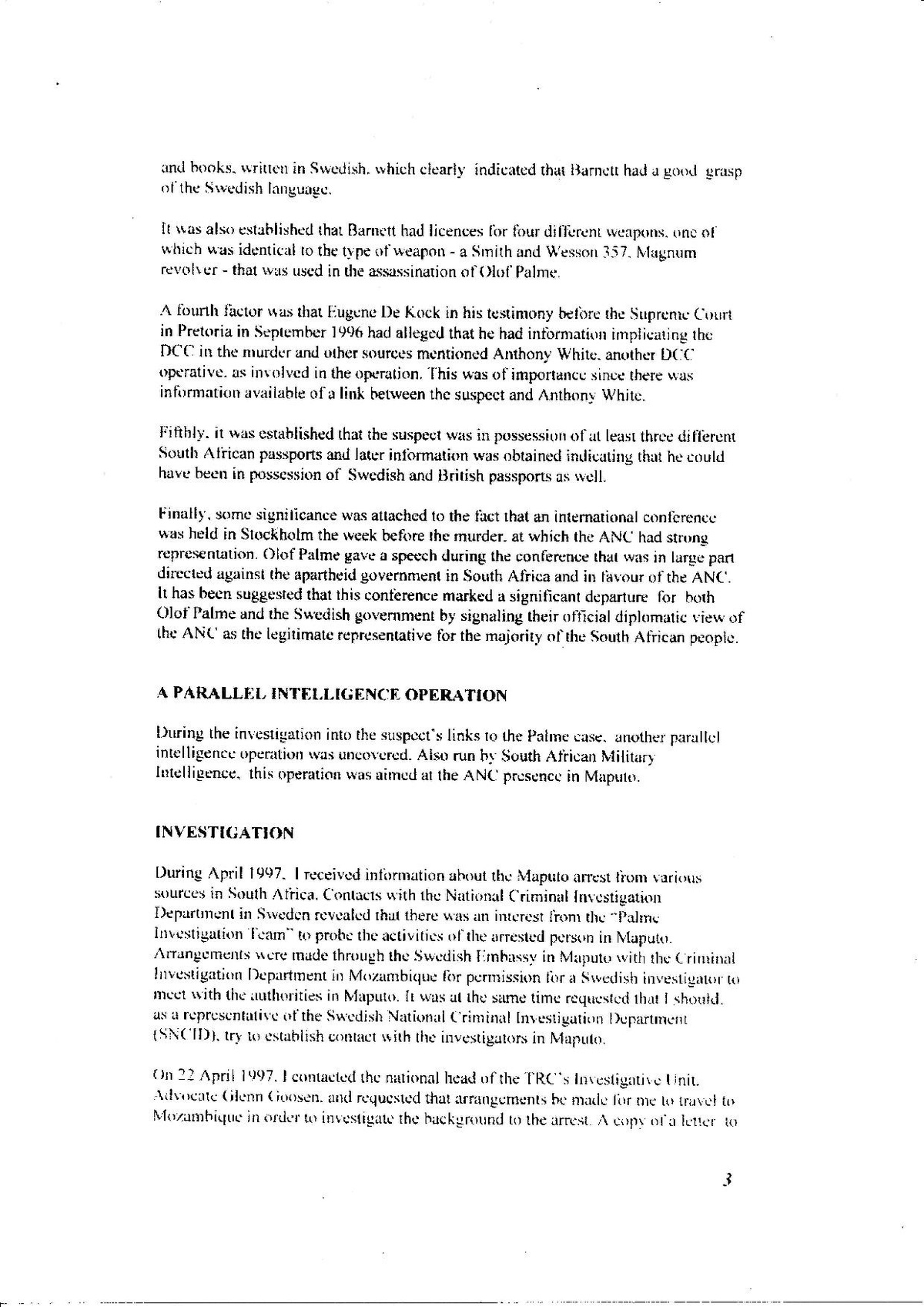
and books, written in Swedish. which clearly indicated that Barnett had a good grasp of the Swedish language.
It was also established that Barnett had licences for four different weapons, one of which was identical to the type of weapon - a Smith and Wesson 357, Magnum revolver - that was used in the assassination of Olof Palme.
A fourth factor was that Eugene De Kock in his testimony before the Supreme Court in Pretoria in September 1996 had alleged that he had information implicating the DCC in the murder and other sources mentioned Anthony White, another DCC operative. as involved in the operation. This was of importance since there was information available of a link between the suspect and Anthony White.
Fifthly. it was established that the suspect was in possession of at least three different South African passports and later information was obtained indicating that he could have been in possession of Swedish and British passports as well.
Finally, some significance was attached to the fact that an international conference was held in Stockholm the week before the murder, at which the ANC had strong representation. Olof Palme gave a speech during the conference that was in large part directed against the apartheid government in South Africa and in favour of the ANC. It has been suggested that this conference marked a significant departure for both Olof Palme and the Swedish government by signaling their official diplomatic view of the ANC as the legitimate representative for the majority of the South African people.
A PARALLEL INTELLIGENCE OPERATION
During the investigation into the suspect's links to the Palme case, another parallel intelligence operation was uncovered. Also run by South African Military Intelligence, this operation was aimed at the ANC presence in Maputo.
INVESTIGATION
During April 1997, I received information about the Maputo arrest from various sources in South Africa. Contacts with the National Criminal Investigation Department in Sweden revealed that there was an interest from the "Palmo Investigation Team“ to probe the activities of the arrested person in Maputo. Arrangements were made through the Swedish Embassy in Maputo with the Criminal Investigation Department in Mozambique for permission for a Swedish investigator 10 meet with the authorities in Maputo. It was at the same time requested that I should. as a representative of the Swedish National Criminal Investigation Department (SNCID), try to establish contact with the investigators in Maputo.
a
On 22 April 1997. I contacted the national head of the TRC`s Investigative Unit. Advocate Glenn Goosen, and requested that arrangements be made for me to travel to Mozambique in order to investigate the background to the arrest. A copy oraluller 10
}
Goosen is attached. It was decided that I could travel to Mozambique purely as a representative of the Swedish Police and that I had to act under conditions arranged by the Swedish Embassy in Maputo or the SNCID. Following the arrangements made earlier between the TRC and Swedish Government regarding the Palme investigation, it was agreed that I should report to the national head on my return from Mozambique.
On 28 April 1997, I had my first meeting with representatives of the investigative team in Maputo at which I explained my presence in Mozambique as a representative for the SNCID. I requested access to any details of the investigation which could be related to the murder of Palme, as well as access to the suspect. Since the Intelligence Agency in Mozambique was involved in the investigation, a decision had to be taken at a top political level relating to this request which was that I could have "100% insight into the investigation" and then later that I could forward information obtained in Mozambique to the TRC.
On 30 April 1997. I had my first meeting with the suspect at the Criminal Investigation Department in Maputo. At this stage there was no time for a proper interview. Instead, I put a number of questions to the suspect relating to his activities in Mozambique, any trips to Sweden, any knowledge about Longreach. his whereabouts on 28 February 1986 and knowledge of any so-called “Third Force activities". I asked him to write down his answers and hand then over at a later stage. The same day I was also present during a search of the suspect's apartment in Maputo. I was also given access to some of the evidence obtained in earlier searches of Barnett's apartment.
On 2 May 1997, I took part in a meeting with the suspect at the Machaba Prison in Maputo. At this meeting. he handed over a handwritten document containing his answers to the questions put to him the previous day. This document is attached.'
from documents gathered from the suspect's apartment it had already been established that he was licenced for at least 4 weapons at the time of his arrest: 1 Astra pistol (cal 22). I Glock pistol (cal 10mm), 1 Spandau Mauser rifle (cal 308) and a Smith & Wesson revolver (357 magnum). All of the weapons mentioned, except the Smith & Wesson revolver, had been found previous to the time for my meeting with him on 2 May 1997. He stated that the missing weapon was kept in a security deposit drawer in a Nedbank branch in Durban. At my request I was given a letter", addressed to The Manager. Nedbank Bank, Smith Street (Durban), giving me access to his bank drawer and hox in the afore-mentioned bank. On 21 May 1997 on a visit to the hank. 1 removed the revolver, and other items, from both the drawer and the box. A list of the removed items is attached."
Request la contact a South African citizen under arrest in Mozambique. ?? April 1997.
llandwritten document 'N. Esslin Security Deposit Drawer and Box Infree Space.... * Concerning a safety deposit box illnd a safuty drawer in Nudbank. Smith Street, Durhan.
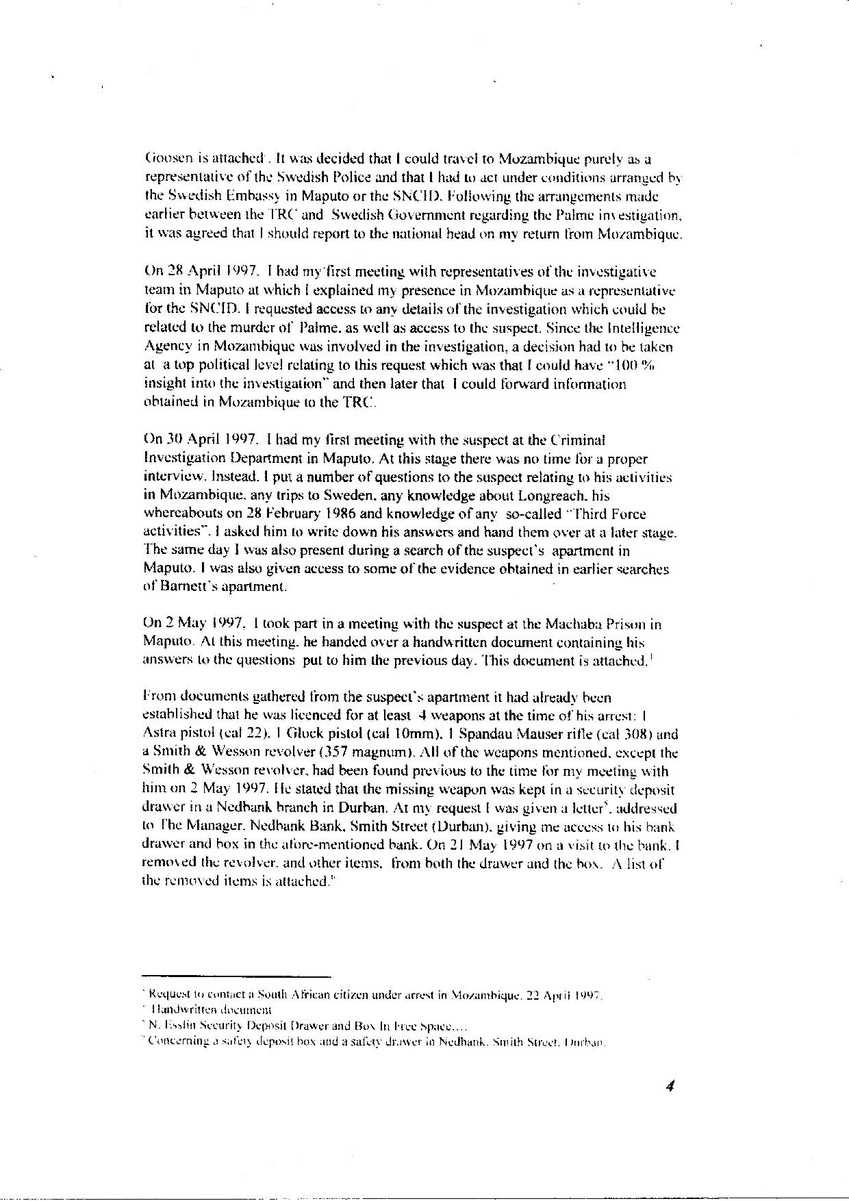

Goosen is attached. It was decided that I could travel to Mozambique purely as a representative of the Swedish Police and that I had to act under conditions arranged by the Swedish Embassy in Maputo or the SNCID. Following the arrangements made earlier between the TRC and Swedish Government regarding the Palme investigation, it was agreed that I should report to the national head on my return from Mozambique.
On 28 April 1997, I had my first meeting with representatives of the investigative team in Maputo at which I explained my presence in Mozambique as a representative for the SNCID. I requested access to any details of the investigation which could be related to the murder of Palme, as well as access to the suspect. Since the Intelligence Agency in Mozambique was involved in the investigation, a decision had to be taken at a top political level relating to this request which was that I could have "100% insight into the investigation" and then later that I could forward information obtained in Mozambique to the TRC.
On 30 April 1997. I had my first meeting with the suspect at the Criminal Investigation Department in Maputo. At this stage there was no time for a proper interview. Instead, I put a number of questions to the suspect relating to his activities in Mozambique, any trips to Sweden, any knowledge about Longreach. his whereabouts on 28 February 1986 and knowledge of any so-called “Third Force activities". I asked him to write down his answers and hand then over at a later stage. The same day I was also present during a search of the suspect's apartment in Maputo. I was also given access to some of the evidence obtained in earlier searches of Barnett's apartment.
On 2 May 1997, I took part in a meeting with the suspect at the Machaba Prison in Maputo. At this meeting. he handed over a handwritten document containing his answers to the questions put to him the previous day. This document is attached.'
from documents gathered from the suspect's apartment it had already been established that he was licenced for at least 4 weapons at the time of his arrest: 1 Astra pistol (cal 22). I Glock pistol (cal 10mm), 1 Spandau Mauser rifle (cal 308) and a Smith & Wesson revolver (357 magnum). All of the weapons mentioned, except the Smith & Wesson revolver, had been found previous to the time for my meeting with him on 2 May 1997. He stated that the missing weapon was kept in a security deposit drawer in a Nedbank branch in Durban. At my request I was given a letter", addressed to The Manager. Nedbank Bank, Smith Street (Durban), giving me access to his bank drawer and hox in the afore-mentioned bank. On 21 May 1997 on a visit to the hank. 1 removed the revolver, and other items, from both the drawer and the box. A list of the removed items is attached."
Request la contact a South African citizen under arrest in Mozambique. ?? April 1997.
llandwritten document 'N. Esslin Security Deposit Drawer and Box Infree Space.... * Concerning a safety deposit box illnd a safuty drawer in Nudbank. Smith Street, Durhan.
Later it was established that the suspect had been using other banks in Durban and Nelspruit. Investigations at these banks produced no usefUL information. (Further information under "PAYMENT AND BANK ISSUES“.)
One of the main issues at this stage of the investigation was to identify the suspect. From documents found at the time of his arrest and during the search of his apartmeni. it was known that he was in possession of at least the three following ID documents:
1. Nigel Barnett, ID no 500630520200 2. Nicho Esslin, ID no 4905295115006 3. Henry William Bacon, ID no 4905295115006
According to the suspect, he was born in 1949 in Queenstown, South Africa, as Leon van der Westhuizen. When he was about two- months old, he was adopted by the Bacon family and re-named Henry William Bacon. In 1982. he officially changed his name to Nicho Esslin. A copy of the Governments Gazette, dated 10 December 1982, promulgating the name change is attached. The reason given for this change was that he planned to marry and did not want his future family to experience the same problems of ridicule that he had had, e.g. bacon and egg. In 1983, he assumed the false name. Nigel Barnett, as a cover for his operation in Mozambique.
It was established that Henry William Bacon had a step-brother who was born in 1947. His name is Olav Bacon and he lives in Pretoria. On 2 June 1997. a meeting was held with him. Details from the interview are given in a report which is attached." Of interest was the fact that Olav Bacon was confronted with two photographs of the person arrested in Maputo but could not identify the person in the photographs as his brother.
On 3 June 1997, I had a meeting with an unidentified person who claimed that he was "Barnett's" handler between April 1984 and December 1985. A second meeting was held with the handler on 22 July 1997. Details from the two meetings are given in a report that is attached."
On 9 and 10 June 1997. I had a meeting at the NCID in Stockholm. The purpose was to discuss possible assistance in order to follow-up information relating to the suspect's visits to Sweden, as well as to investigate information about a Swedish passport used by the suspect, identify persons at the South African Legation in Stockholm in the 1980s, establish when the earlier-mentioned radio-broadcast was made and to conduct a ballistic test of the suspect's Smith & Wesson revolver.
On 28 June 1997, I was present during an interrogation of the suspect in the Machaba Prison in Maputo. The interrogation was conducted by personnel from the CID and the Intelligence Service in Maputo. The interview focused on his family background.
Ciovernment (inzette No. 2645.10 December 1982. a copy. Meeting with Olav Bacon. Meeting with a "llandler"-Bannell. A second meeting with the “Handler"
5
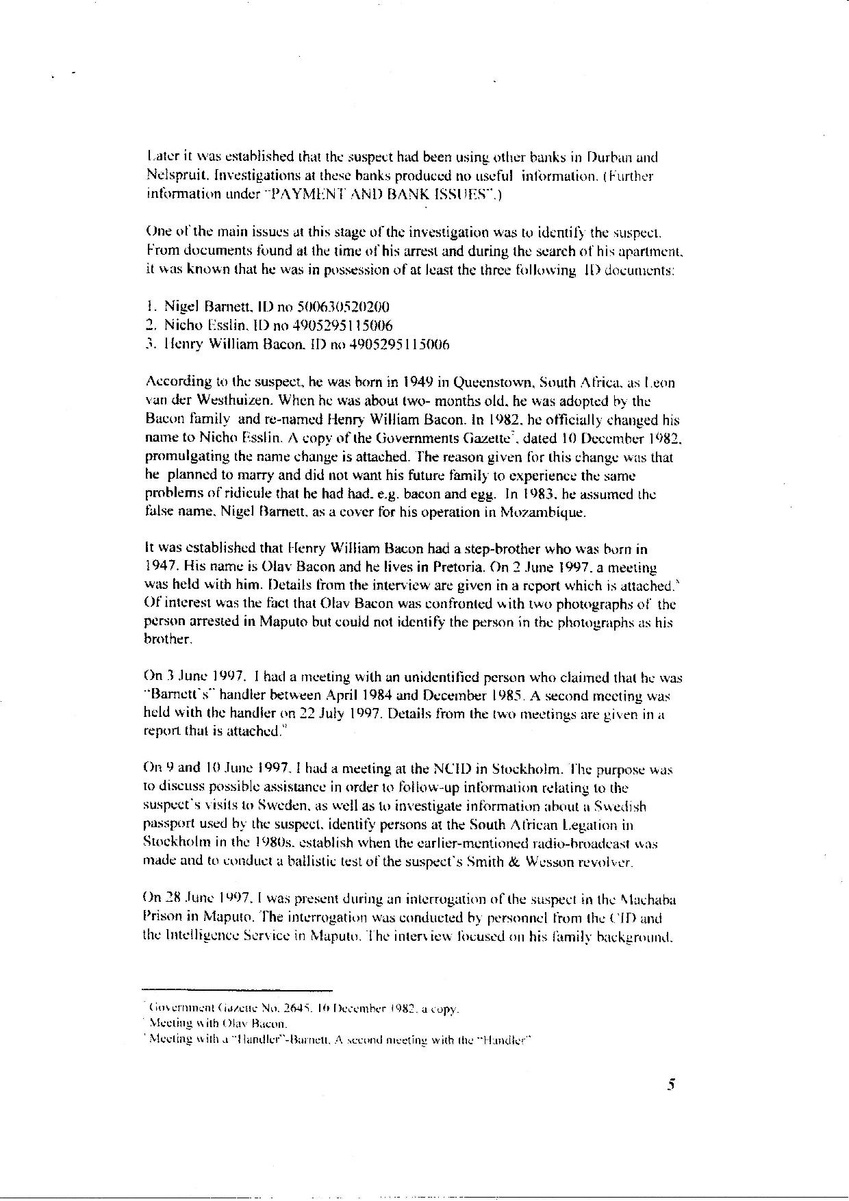
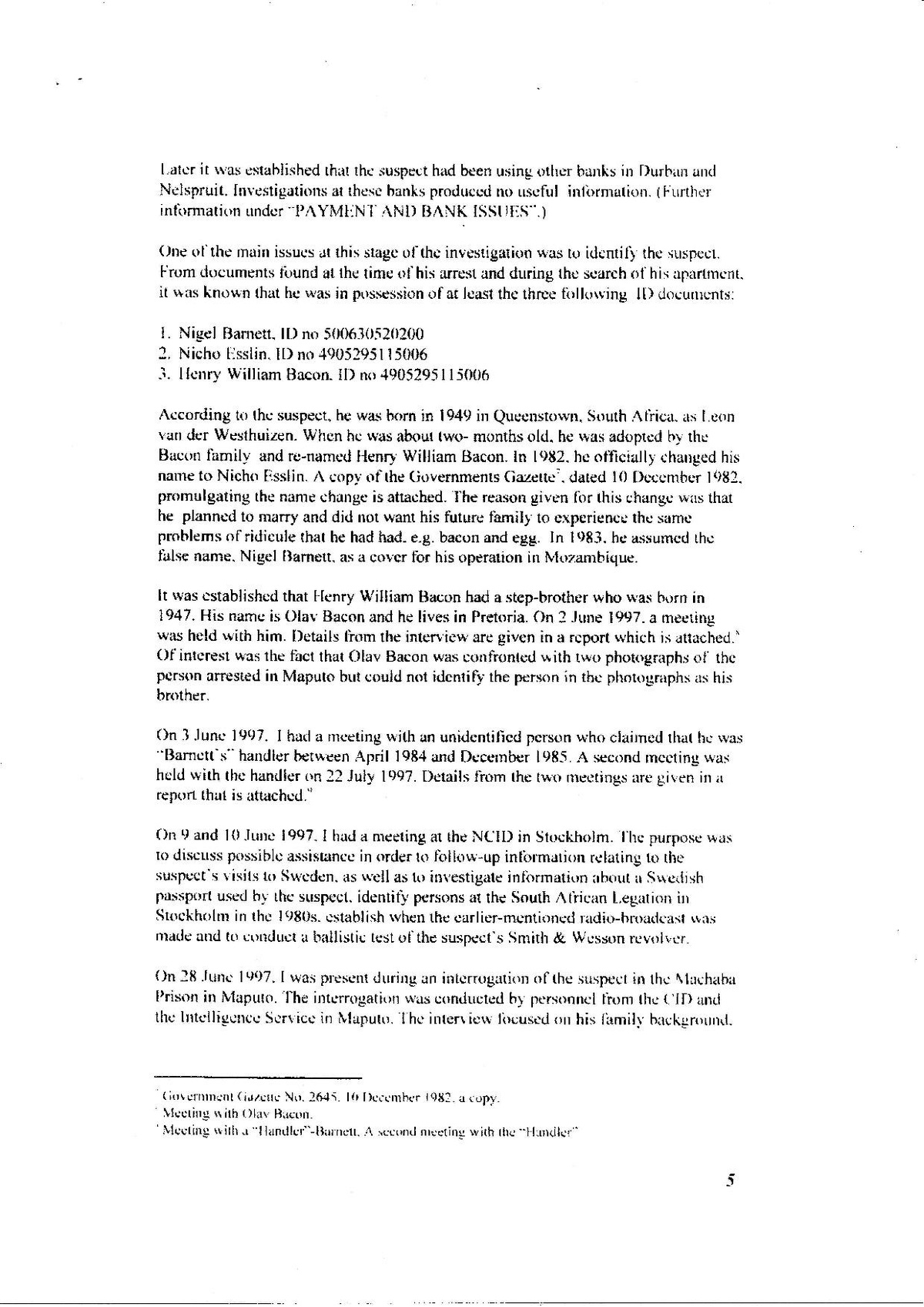
Later it was established that the suspect had been using other banks in Durban and Nelspruit. Investigations at these banks produced no usefUL information. (Further information under "PAYMENT AND BANK ISSUES“.)
One of the main issues at this stage of the investigation was to identify the suspect. From documents found at the time of his arrest and during the search of his apartmeni. it was known that he was in possession of at least the three following ID documents:
1. Nigel Barnett, ID no 500630520200 2. Nicho Esslin, ID no 4905295115006 3. Henry William Bacon, ID no 4905295115006
According to the suspect, he was born in 1949 in Queenstown, South Africa, as Leon van der Westhuizen. When he was about two- months old, he was adopted by the Bacon family and re-named Henry William Bacon. In 1982. he officially changed his name to Nicho Esslin. A copy of the Governments Gazette, dated 10 December 1982, promulgating the name change is attached. The reason given for this change was that he planned to marry and did not want his future family to experience the same problems of ridicule that he had had, e.g. bacon and egg. In 1983, he assumed the false name. Nigel Barnett, as a cover for his operation in Mozambique.
It was established that Henry William Bacon had a step-brother who was born in 1947. His name is Olav Bacon and he lives in Pretoria. On 2 June 1997. a meeting was held with him. Details from the interview are given in a report which is attached." Of interest was the fact that Olav Bacon was confronted with two photographs of the person arrested in Maputo but could not identify the person in the photographs as his brother.
On 3 June 1997, I had a meeting with an unidentified person who claimed that he was "Barnett's" handler between April 1984 and December 1985. A second meeting was held with the handler on 22 July 1997. Details from the two meetings are given in a report that is attached."
On 9 and 10 June 1997. I had a meeting at the NCID in Stockholm. The purpose was to discuss possible assistance in order to follow-up information relating to the suspect's visits to Sweden, as well as to investigate information about a Swedish passport used by the suspect, identify persons at the South African Legation in Stockholm in the 1980s, establish when the earlier-mentioned radio-broadcast was made and to conduct a ballistic test of the suspect's Smith & Wesson revolver.
On 28 June 1997, I was present during an interrogation of the suspect in the Machaba Prison in Maputo. The interrogation was conducted by personnel from the CID and the Intelligence Service in Maputo. The interview focused on his family background.
Ciovernment (inzette No. 2645.10 December 1982. a copy. Meeting with Olav Bacon. Meeting with a "llandler"-Bannell. A second meeting with the “Handler"
5
military training, police service and intelligence operation. A report on the interrogation is attached.""'
On 13 August 1997, a list of numbers on passports issued at the Swedish Embassy in Maputo from 1982 to 1986 was sent to the Investigative Unit in Stockholm. The list was based on information obtained at the Swedish Embassy earlier the same month. The purpose was to establish if'any passports issued during this period were given to the suspect. As mentioned before in this report, one of the suspect's handlers indicated that the suspect, at one stage, was in possession of a Swedish passport. A copy of the list sent to Sweden is attached."
On 15 August 1997, I was present during an interrogation of Richard Fair in the Machaba Prison in Maputo. The interrogation was conducted by personnel from the CID and the Intelligence Service in Maputo. A report on the interrogation is attached".
On 23 August 1997, I was present during an interrogation of a co-accused of the suspect, a Mozambique citizen named Carlos Pinto. The interrogation was aimed of establishing the relationship between Mr. Pinto and the suspect and Mr. Pinto's involvement in the intelligence operation. During this interrogation, the parallel SA DMI operation targeted at personnel at the ANC office in Maputo was revealed. A copy of a report of the interrogation is attached.
On 29 September 1997, bullets fired from the suspect's Smith & Wesson revolver were tested at the Swedish Criminal Forensic Laboratory. It found that there was no similarity between the bullets from the suspect's weapon and those used in the assassination of Olof Palme. The weapon was also examined for the presence of tinger or palm prints at a private Forensic Laboratory in Pretoria. No identifiable finger or palm prints could be found. Reports from the laboratories are attached."
On the 25 September 1997, Barnett was released on US$2000 bail with a requirement that he report daily to a local police station.
INVESTIGATIVE RESULTS
FAMILY BACKGROUND/IDENTITY
Given the fact that the suspect was in possession of a number of ID documents, the nature of his operation in Mozambique created an uncertainty as to his correct identity. The fact that his alleged step-brother could not identify him from
Interview of Nigel Barnett in the Machaba Prison. Maputo, Mozambique: 28 June 1997. Concerning Swedish passports issued in Maputo. Interrogation of a South African citizen named Richard Fair. Interrogation of a citizen of Mozambique named Carlos Pinto. Report from Swedish National Criminal Forensic Laboratory, tile no 4790-97 ind FB.137.97
6
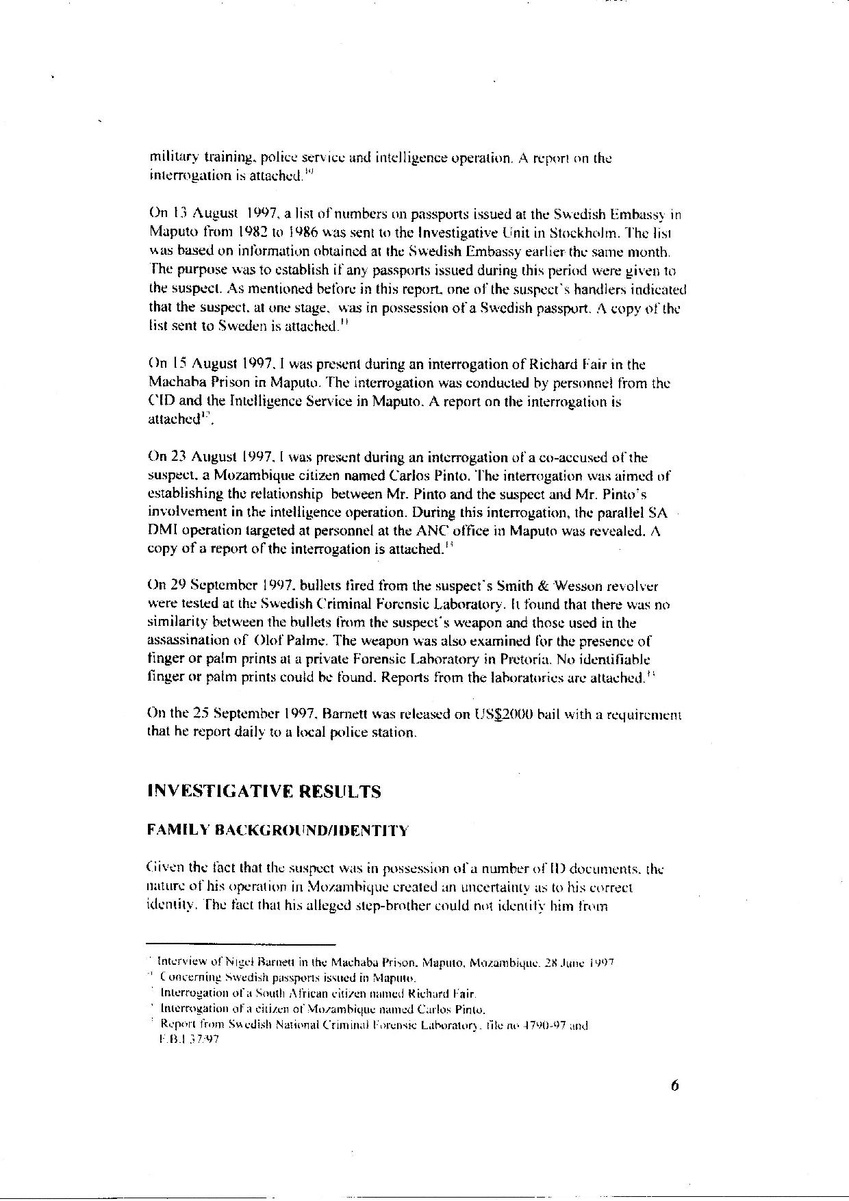
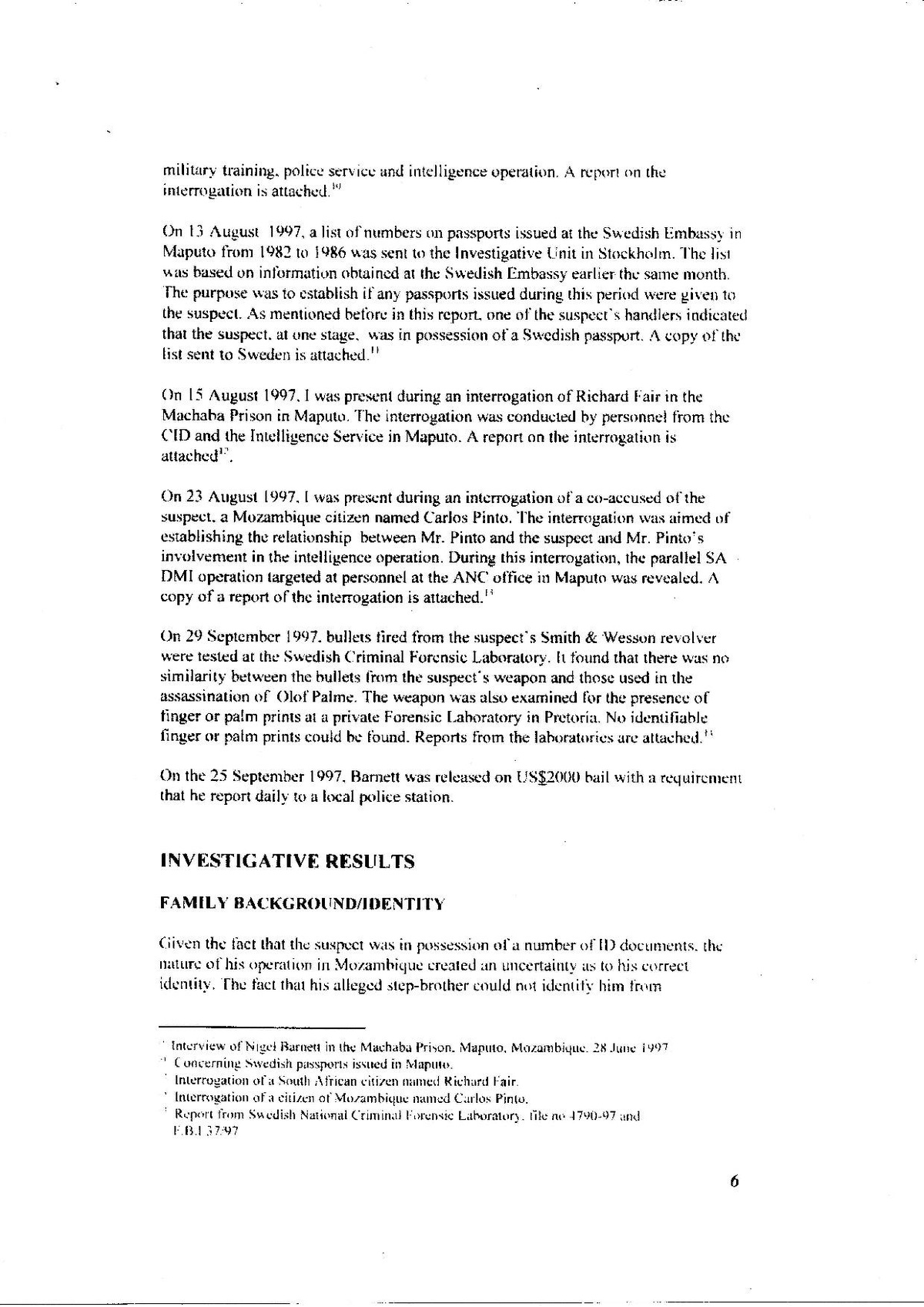
military training, police service and intelligence operation. A report on the interrogation is attached.""'
On 13 August 1997, a list of numbers on passports issued at the Swedish Embassy in Maputo from 1982 to 1986 was sent to the Investigative Unit in Stockholm. The list was based on information obtained at the Swedish Embassy earlier the same month. The purpose was to establish if'any passports issued during this period were given to the suspect. As mentioned before in this report, one of the suspect's handlers indicated that the suspect, at one stage, was in possession of a Swedish passport. A copy of the list sent to Sweden is attached."
On 15 August 1997, I was present during an interrogation of Richard Fair in the Machaba Prison in Maputo. The interrogation was conducted by personnel from the CID and the Intelligence Service in Maputo. A report on the interrogation is attached".
On 23 August 1997, I was present during an interrogation of a co-accused of the suspect, a Mozambique citizen named Carlos Pinto. The interrogation was aimed of establishing the relationship between Mr. Pinto and the suspect and Mr. Pinto's involvement in the intelligence operation. During this interrogation, the parallel SA DMI operation targeted at personnel at the ANC office in Maputo was revealed. A copy of a report of the interrogation is attached.
On 29 September 1997, bullets fired from the suspect's Smith & Wesson revolver were tested at the Swedish Criminal Forensic Laboratory. It found that there was no similarity between the bullets from the suspect's weapon and those used in the assassination of Olof Palme. The weapon was also examined for the presence of tinger or palm prints at a private Forensic Laboratory in Pretoria. No identifiable finger or palm prints could be found. Reports from the laboratories are attached."
On the 25 September 1997, Barnett was released on US$2000 bail with a requirement that he report daily to a local police station.
INVESTIGATIVE RESULTS
FAMILY BACKGROUND/IDENTITY
Given the fact that the suspect was in possession of a number of ID documents, the nature of his operation in Mozambique created an uncertainty as to his correct identity. The fact that his alleged step-brother could not identify him from
Interview of Nigel Barnett in the Machaba Prison. Maputo, Mozambique: 28 June 1997. Concerning Swedish passports issued in Maputo. Interrogation of a South African citizen named Richard Fair. Interrogation of a citizen of Mozambique named Carlos Pinto. Report from Swedish National Criminal Forensic Laboratory, tile no 4790-97 ind FB.137.97
6
photographs made it even more uncertain. At this stage. it was considered of great importance to establish the background of Henry William Bacon in order to be able to confirm the information given by the suspect regarding his identity,
During interviews with the suspect he stated that he attended Dale College in King Williams Town from the ages of 7-9 until he finished his Matric in 1968 or 1969. From records obtained at the school, it was established that he matriculated in 1967.! Photographs from Dale College during this period' of different sport teams included a Henry William Bacon. The school was also visited to gain an awareness of the look of the buildings and where specific facilities were located.
During the interrogation on 28 June 1997, the suspect was confronted with this material. Based on the response and, most importantly, the photographs it was concluded that the person who was arrested in Maputo as Nigel Barnett was identical to Henry William Bacon. It was further established that Henry William Bacon had officially changed his name to Nicho Esslin in 1983.
On 29 May 1949 a Leon van der Westhuizen was born in Queenstown, South Africa. When he was a few months old, he was adopted by Jeffrey Harold Walker Bacon and Aina Amanda Eriksson. He was given the name Henry William Bacon. He also got a step-brother named Olav Bacon who was born 1947. The father was British and the mother a Swedish citizen. The mother worked as a missionary in South Africa for the Swedish Lutheran Church. His mother died in 1964 and his father in 1994.
When he was about 8 years old, he was sent to Dale College in King Williams Town. He finished his studies and left the school in 1969.
According to his brother. Olav Bacon, they had only had sporadic contacts with each other after 1969. From 1971-81, Bacon was in Rhodesia in the British South African Police. Olav met his brother only once when he visited him in Rhodesia. - Olav states that that was in 1976 but H.W.Bacon states that it was in 1981. His father apparently visited him twice, once with his brother in 1976 or 1981, and once he came alone. probably in 1979 or 1980).
After these sporadic contacts with his family, Bacon seems to have cut all his contacts with his family in South Africa. His brother stated that his father tried to contact him from early 1980 until he died in 1994. However, he couldn't recall whether his father ever succeeded in meeting him during this period. II.W. Bacon's handler has also stated that he was ordered by Colonel Al Nel to contact Bacon's father after he had made inquiries about his son. The handler phoned the father, who was living somewhere south of Durban, and told him that his son was overseas and that he was fine.
It has been established that H.W. Bacon visited Sweden a number of times and met relatives of his mother. All those visited in Sweden described the visits as unexpected.
"Memo trum Dalu College hoy's high school, dated 26.06.97.
Thru photographs of different sport leams. Dale College.
7
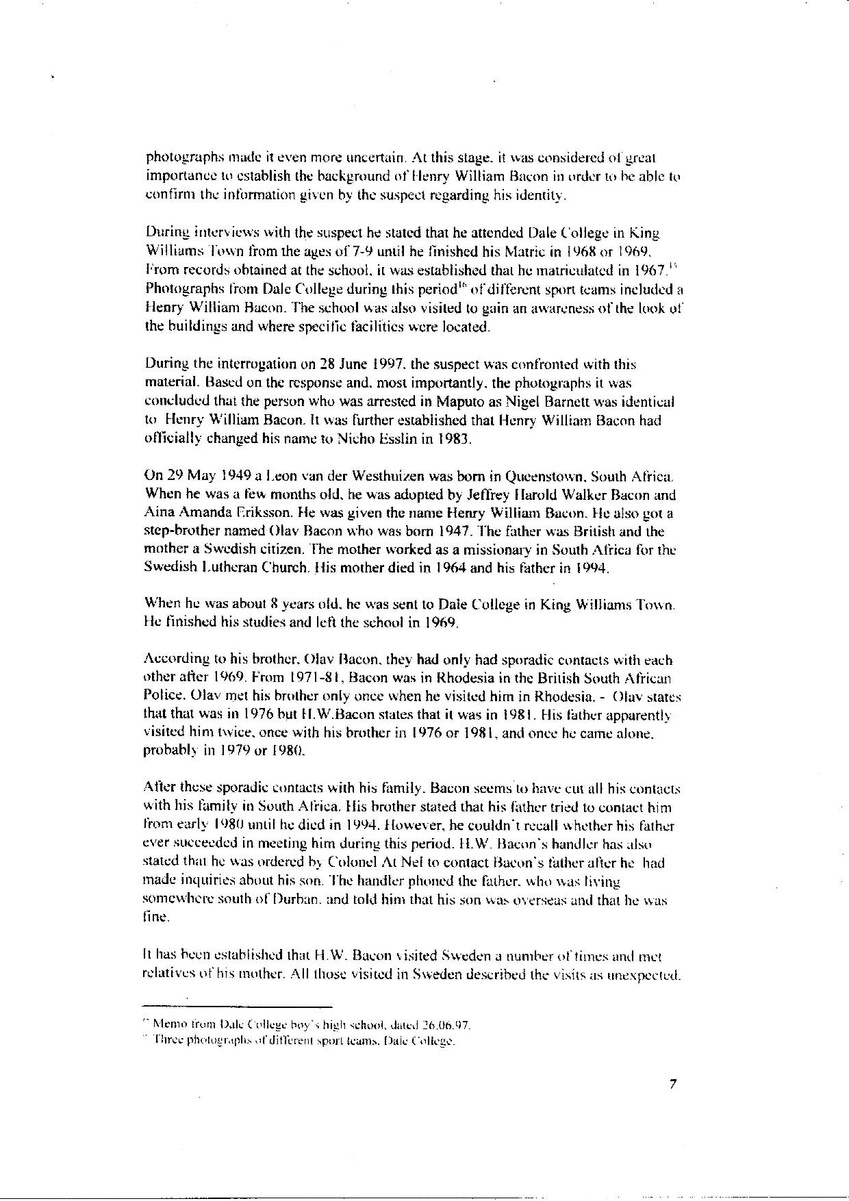
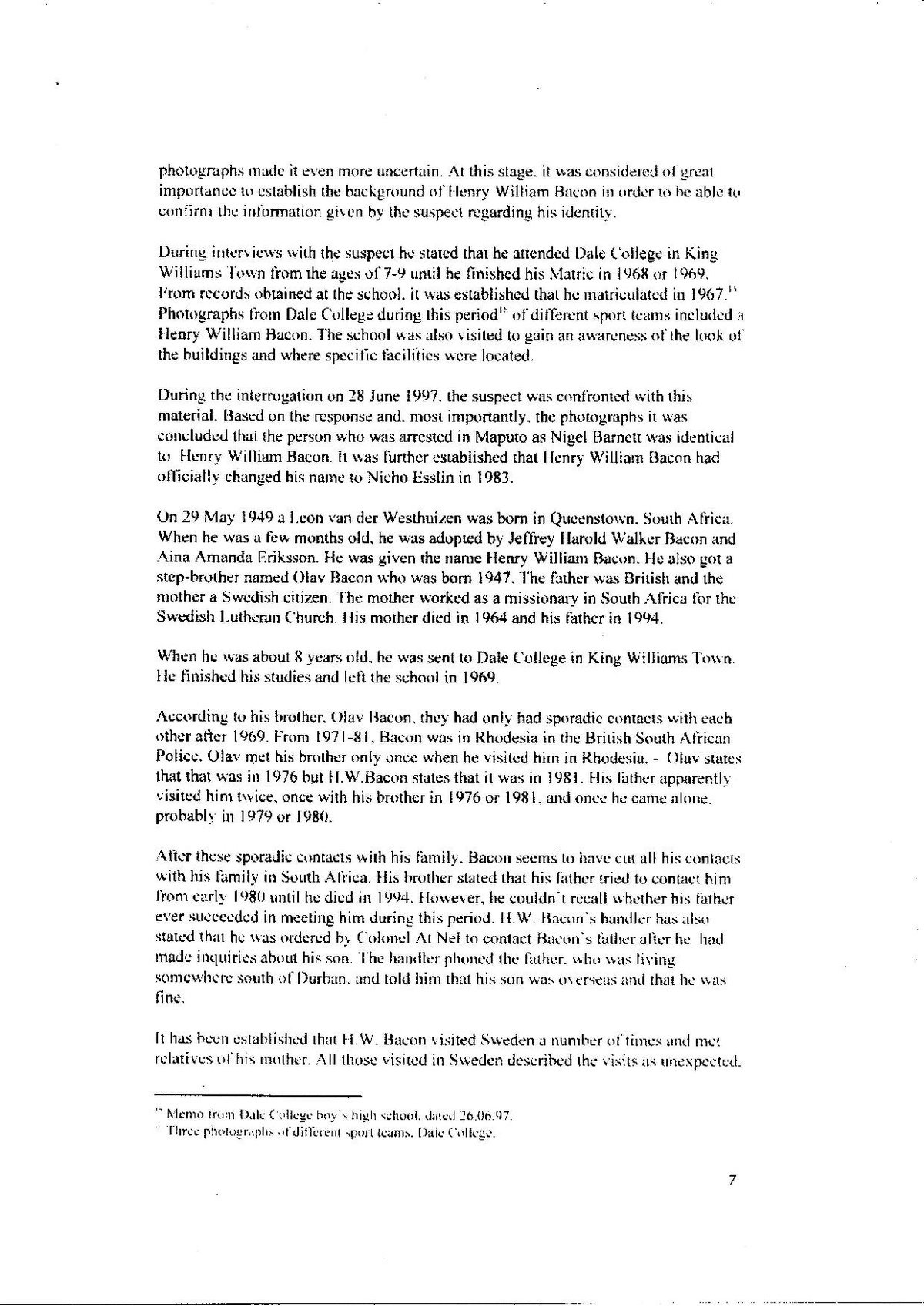
photographs made it even more uncertain. At this stage. it was considered of great importance to establish the background of Henry William Bacon in order to be able to confirm the information given by the suspect regarding his identity,
During interviews with the suspect he stated that he attended Dale College in King Williams Town from the ages of 7-9 until he finished his Matric in 1968 or 1969. From records obtained at the school, it was established that he matriculated in 1967.! Photographs from Dale College during this period' of different sport teams included a Henry William Bacon. The school was also visited to gain an awareness of the look of the buildings and where specific facilities were located.
During the interrogation on 28 June 1997, the suspect was confronted with this material. Based on the response and, most importantly, the photographs it was concluded that the person who was arrested in Maputo as Nigel Barnett was identical to Henry William Bacon. It was further established that Henry William Bacon had officially changed his name to Nicho Esslin in 1983.
On 29 May 1949 a Leon van der Westhuizen was born in Queenstown, South Africa. When he was a few months old, he was adopted by Jeffrey Harold Walker Bacon and Aina Amanda Eriksson. He was given the name Henry William Bacon. He also got a step-brother named Olav Bacon who was born 1947. The father was British and the mother a Swedish citizen. The mother worked as a missionary in South Africa for the Swedish Lutheran Church. His mother died in 1964 and his father in 1994.
When he was about 8 years old, he was sent to Dale College in King Williams Town. He finished his studies and left the school in 1969.
According to his brother. Olav Bacon, they had only had sporadic contacts with each other after 1969. From 1971-81, Bacon was in Rhodesia in the British South African Police. Olav met his brother only once when he visited him in Rhodesia. - Olav states that that was in 1976 but H.W.Bacon states that it was in 1981. His father apparently visited him twice, once with his brother in 1976 or 1981, and once he came alone. probably in 1979 or 1980).
After these sporadic contacts with his family, Bacon seems to have cut all his contacts with his family in South Africa. His brother stated that his father tried to contact him from early 1980 until he died in 1994. However, he couldn't recall whether his father ever succeeded in meeting him during this period. II.W. Bacon's handler has also stated that he was ordered by Colonel Al Nel to contact Bacon's father after he had made inquiries about his son. The handler phoned the father, who was living somewhere south of Durban, and told him that his son was overseas and that he was fine.
It has been established that H.W. Bacon visited Sweden a number of times and met relatives of his mother. All those visited in Sweden described the visits as unexpected.
"Memo trum Dalu College hoy's high school, dated 26.06.97.
Thru photographs of different sport leams. Dale College.
7
